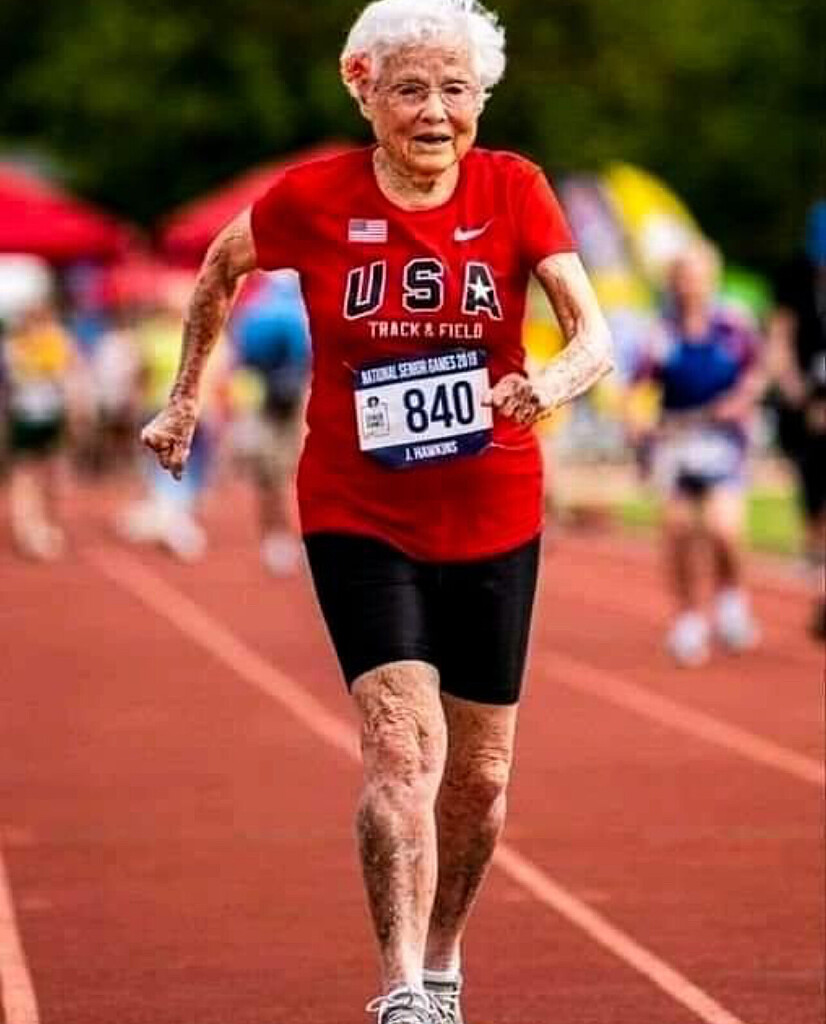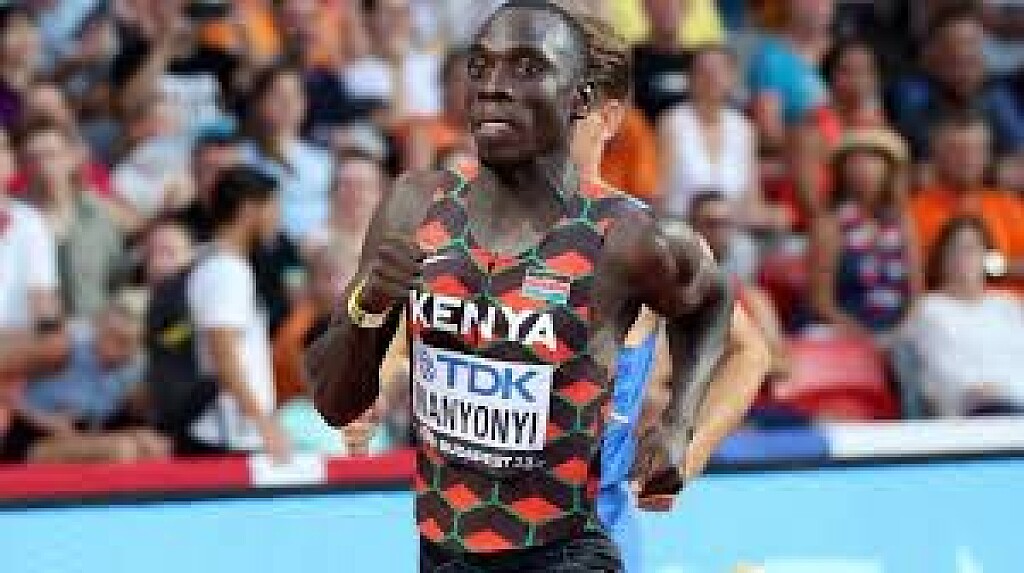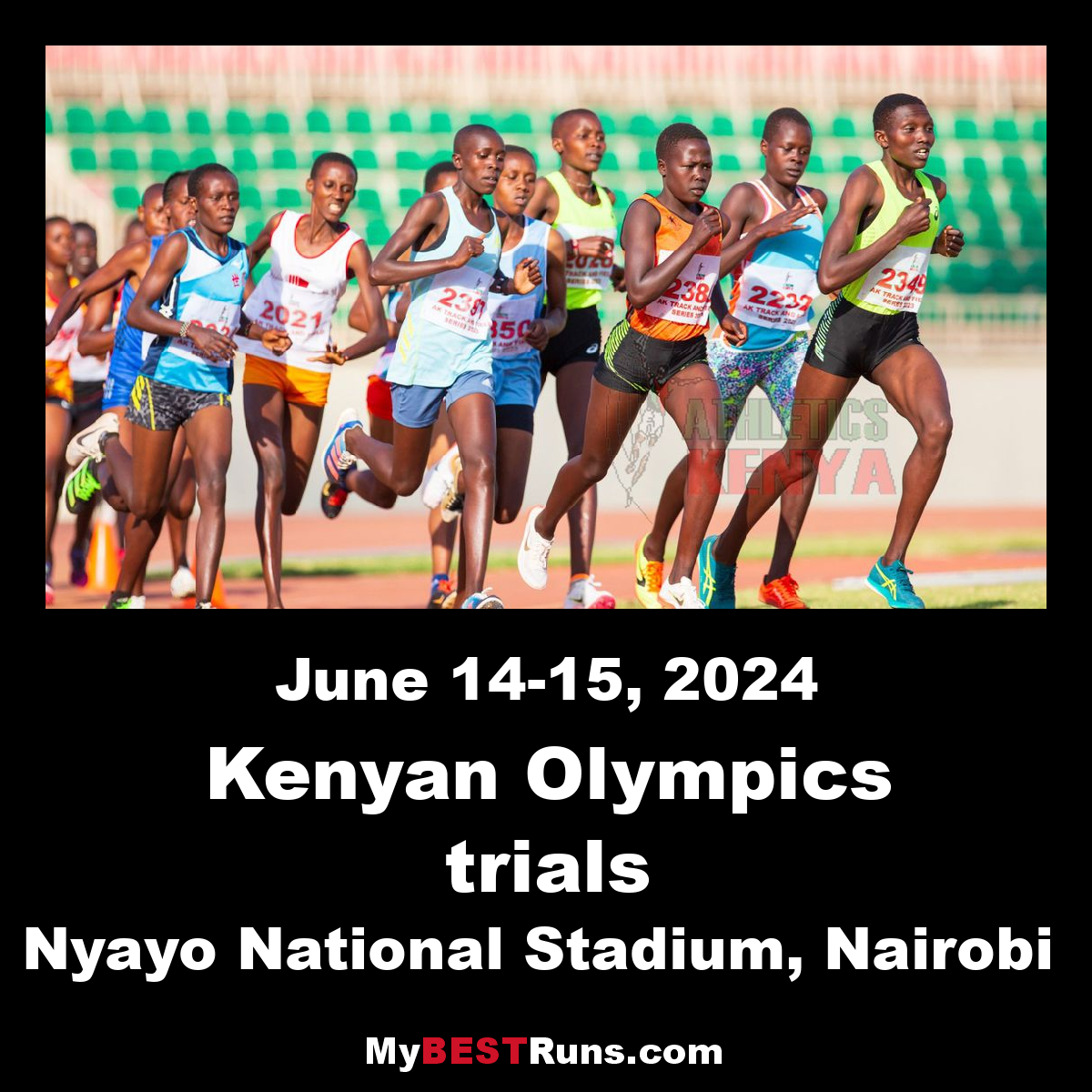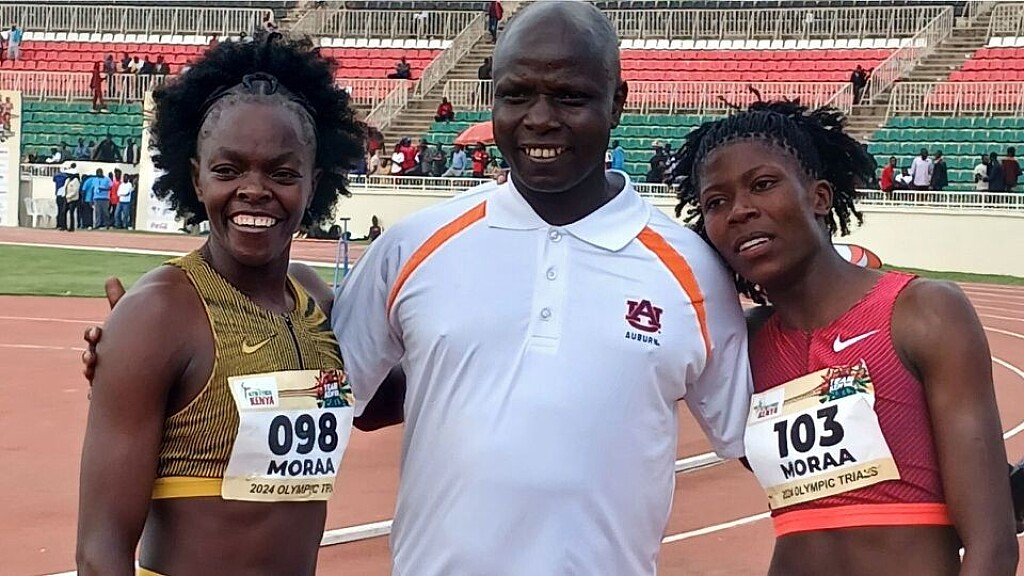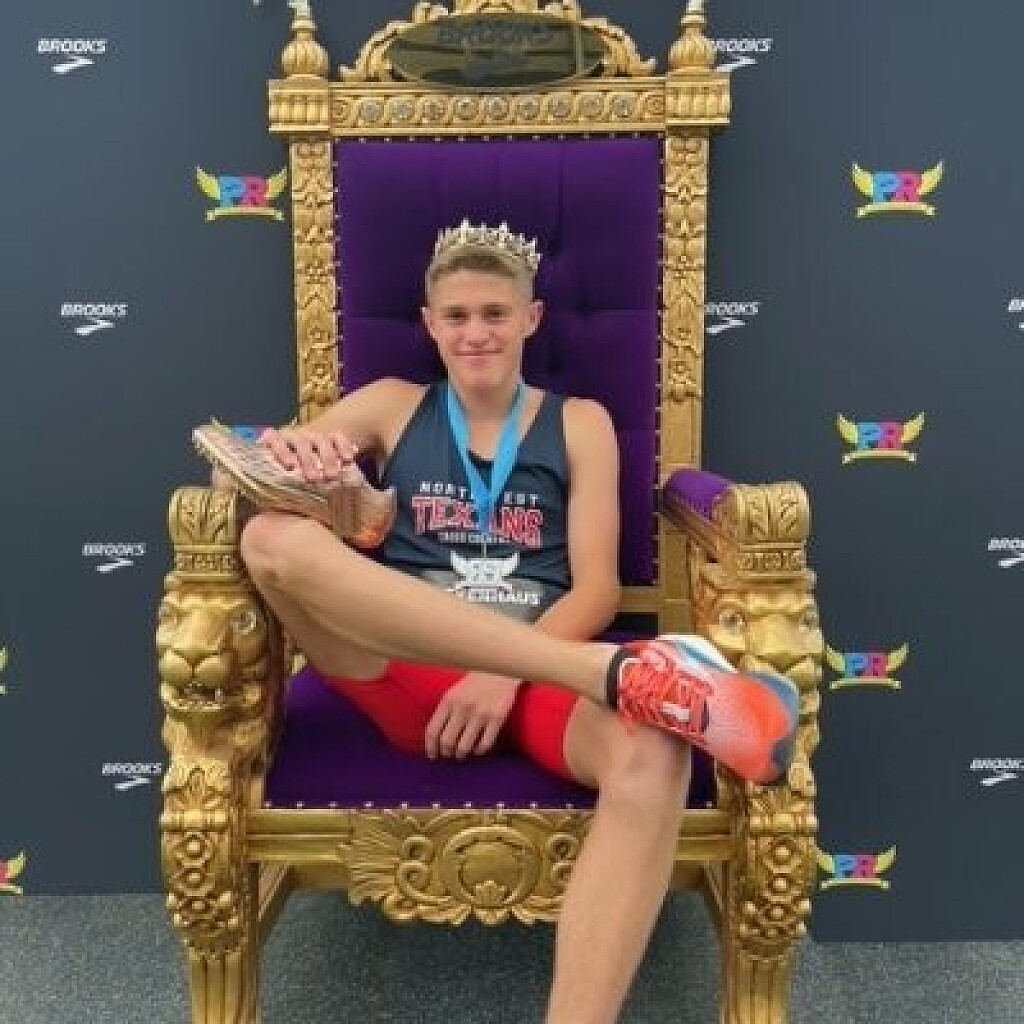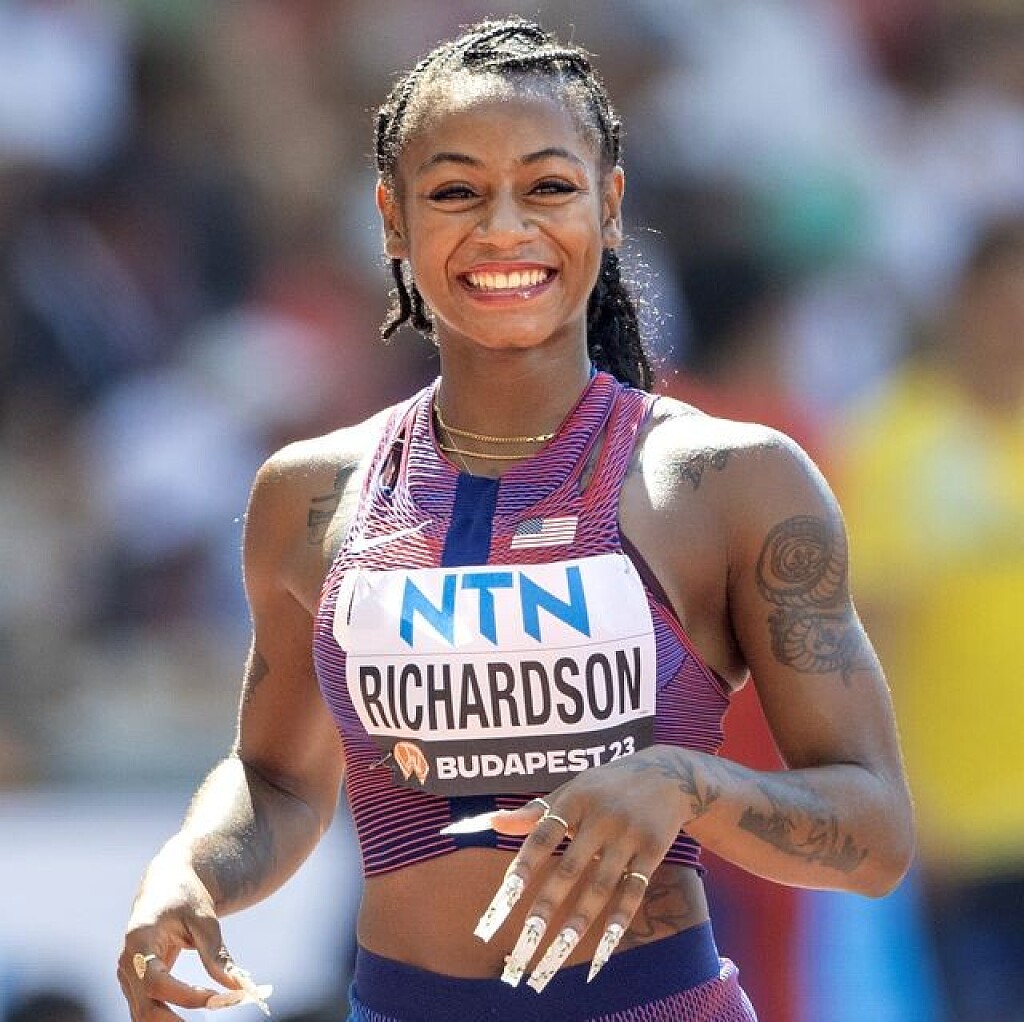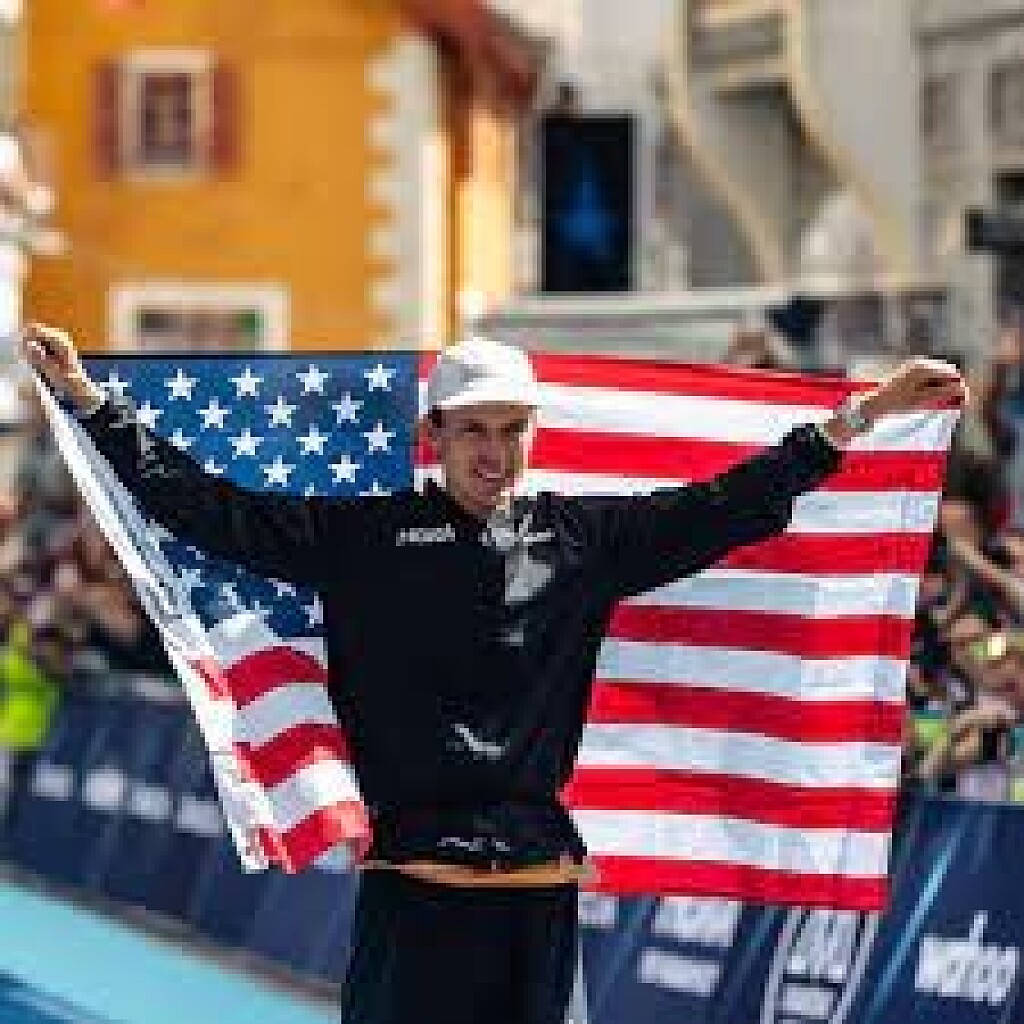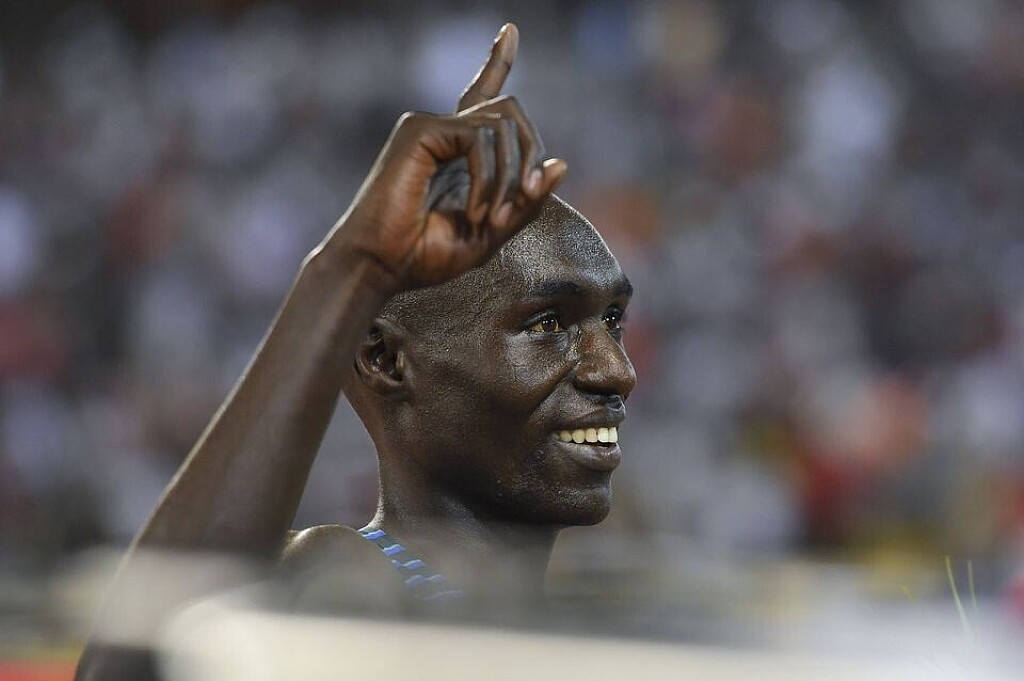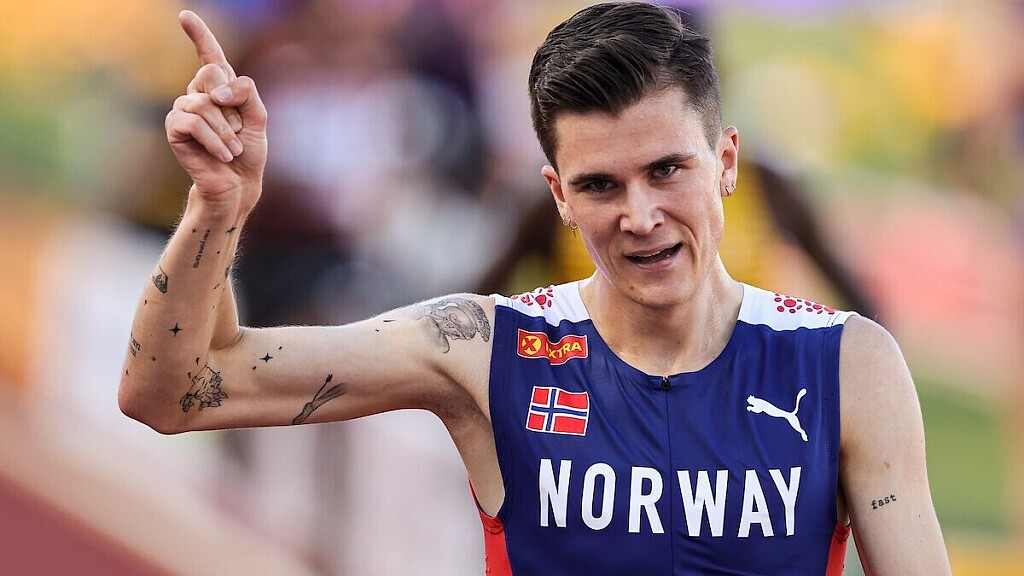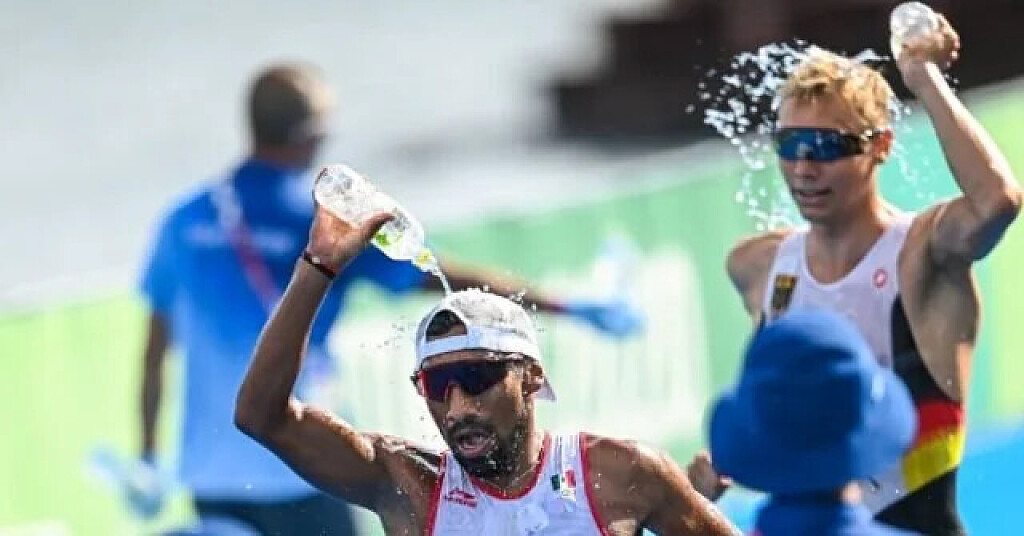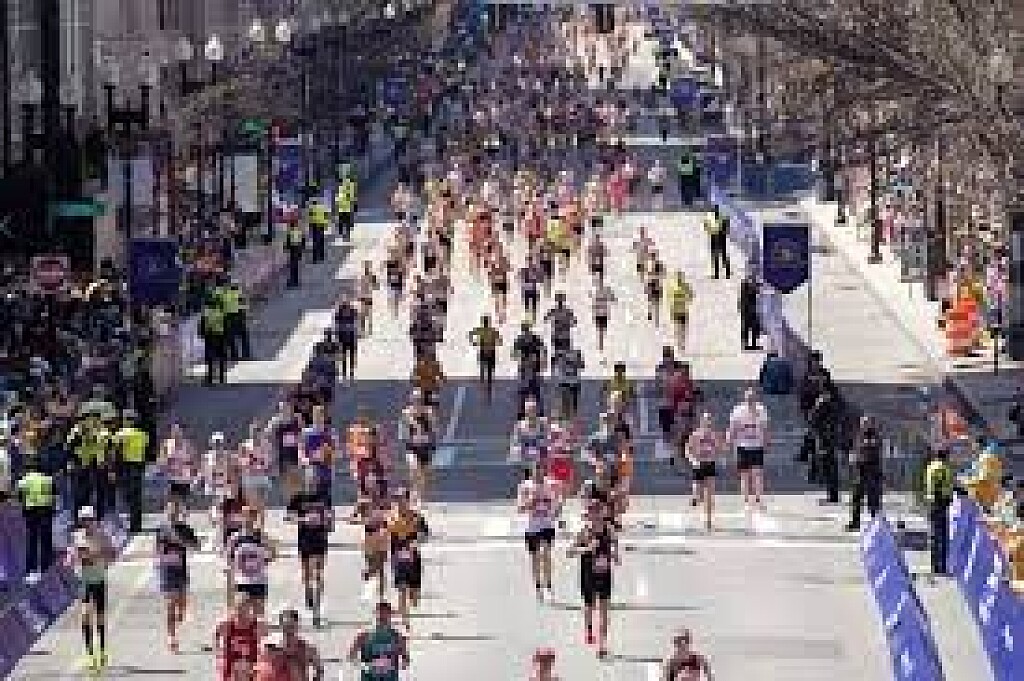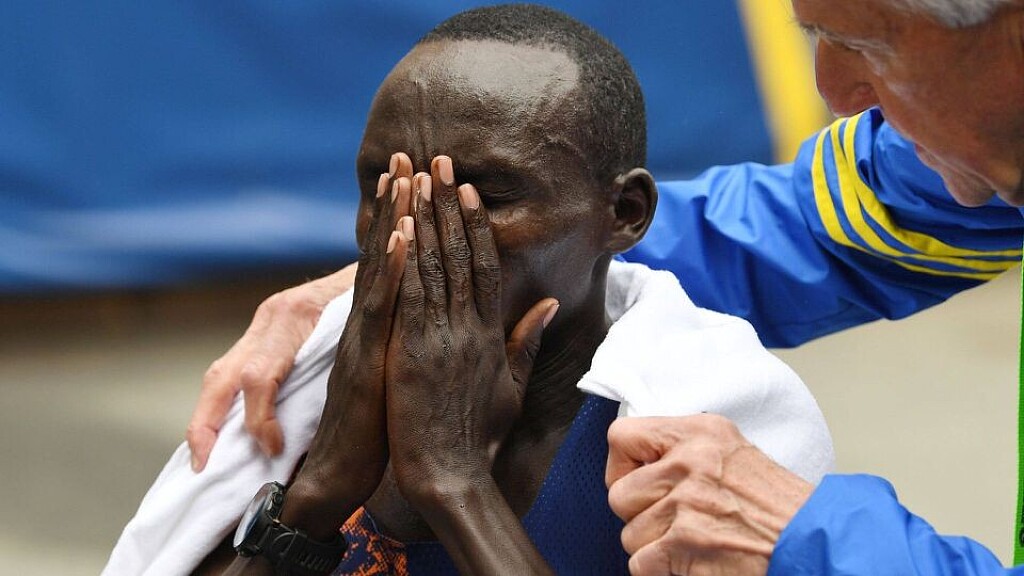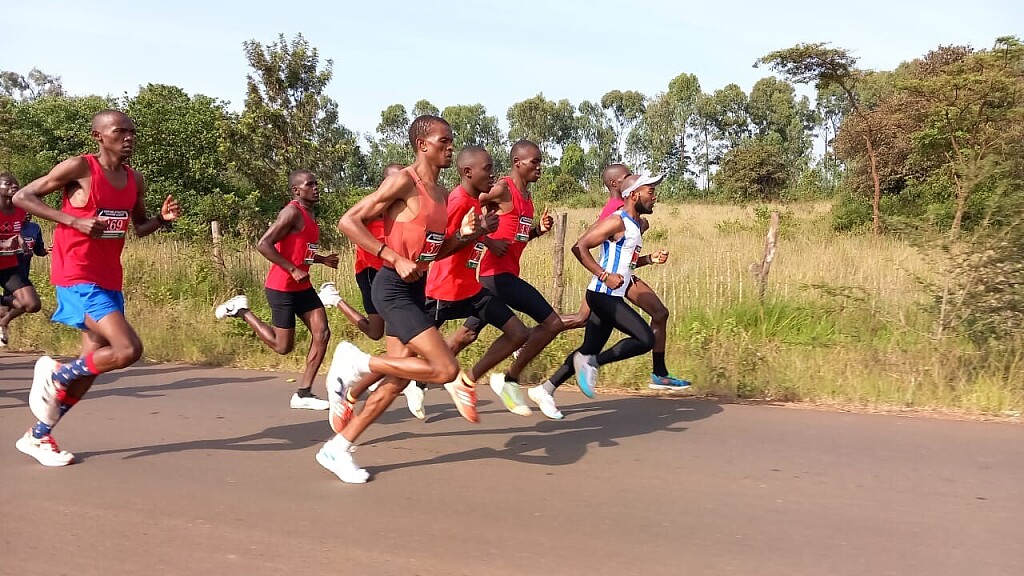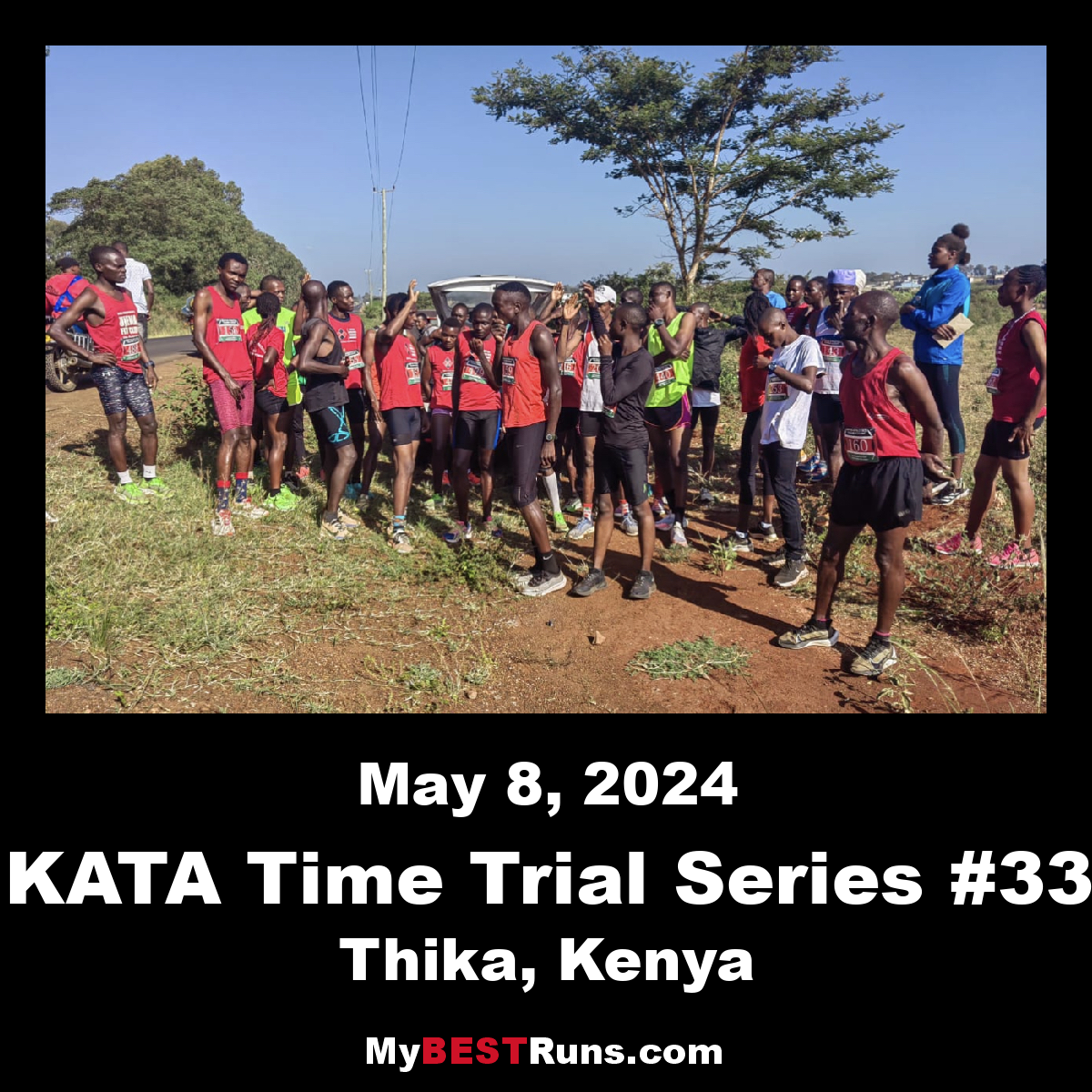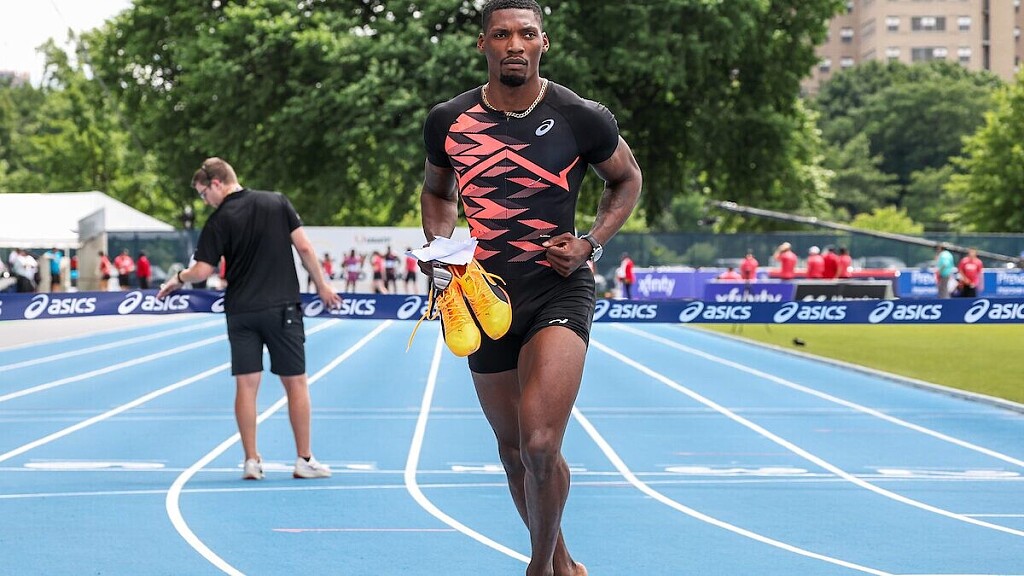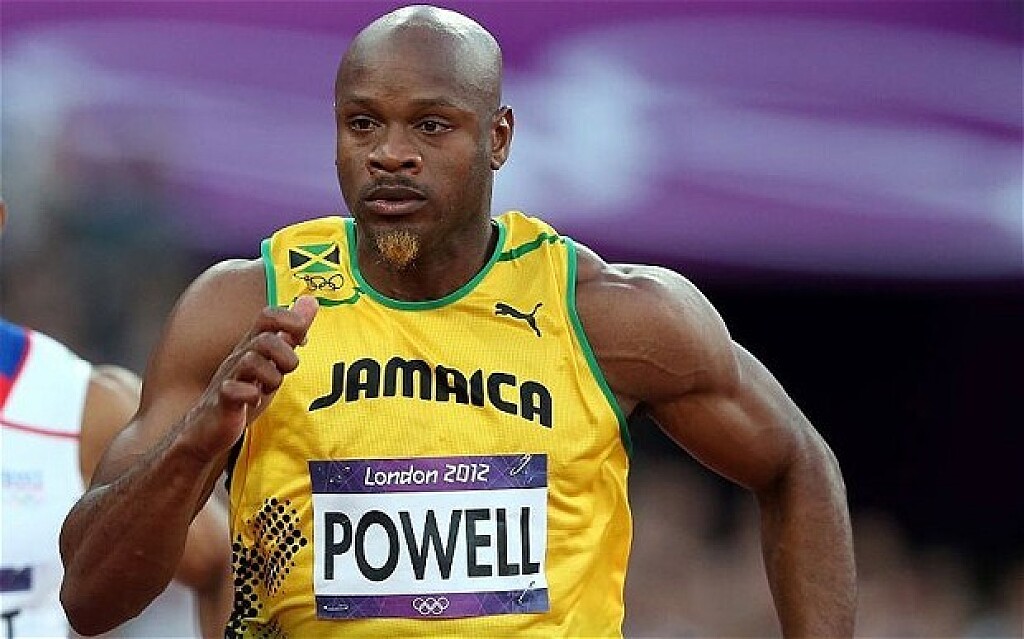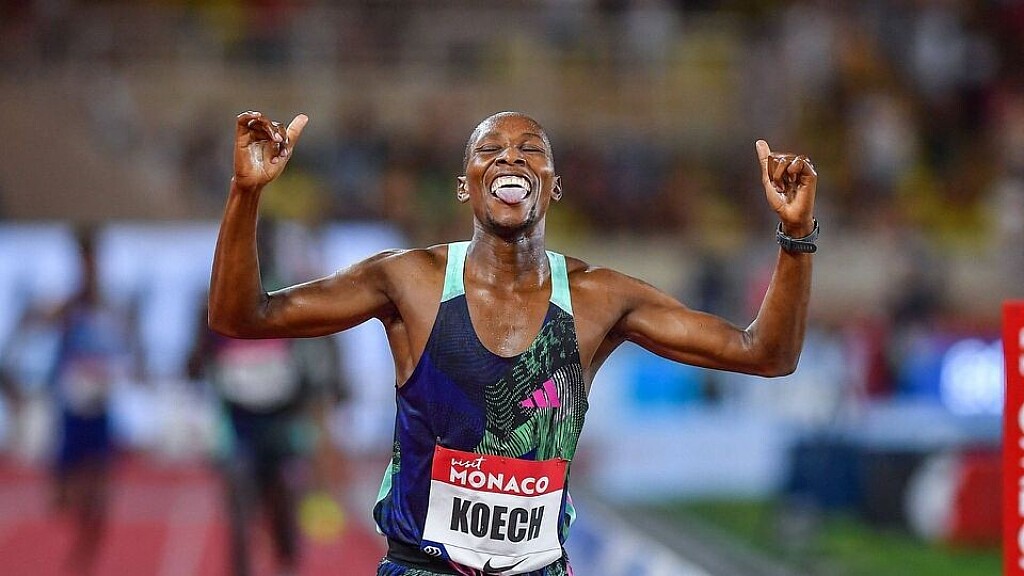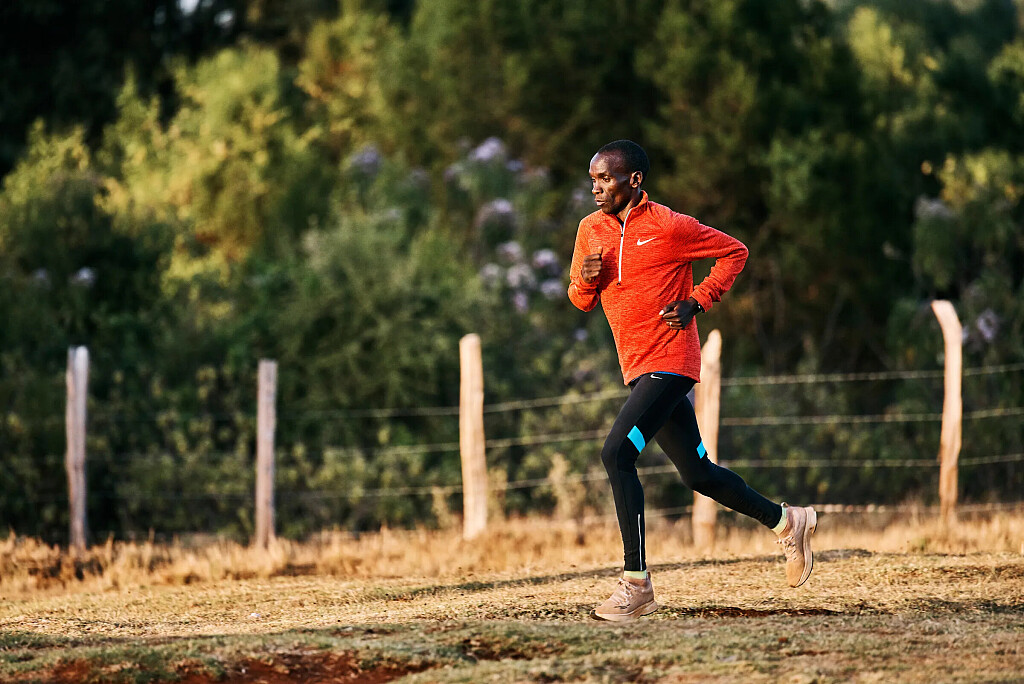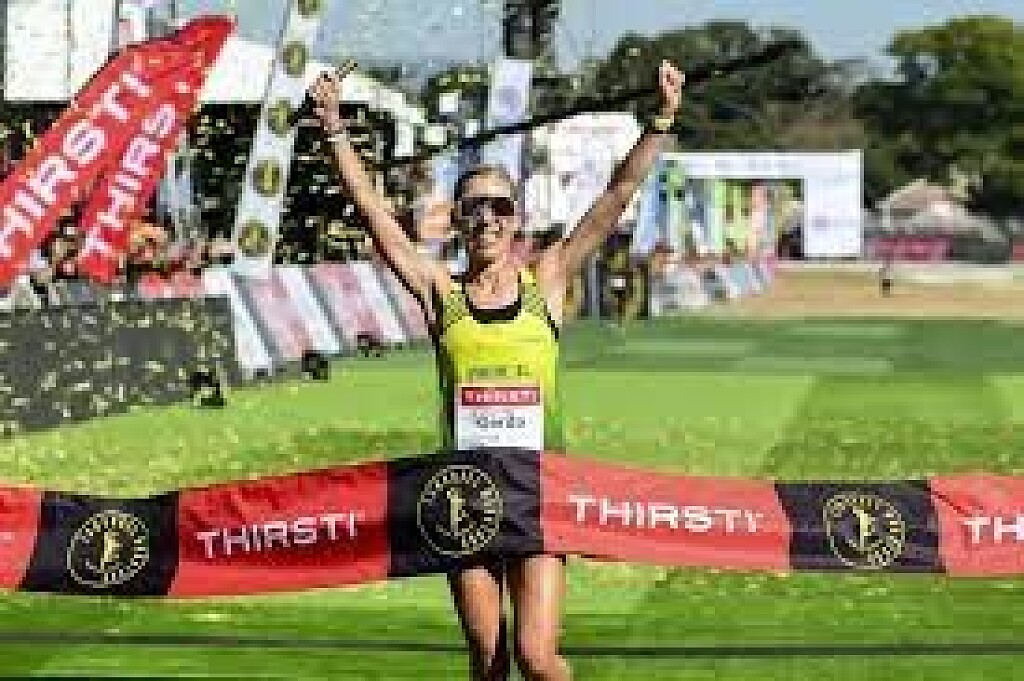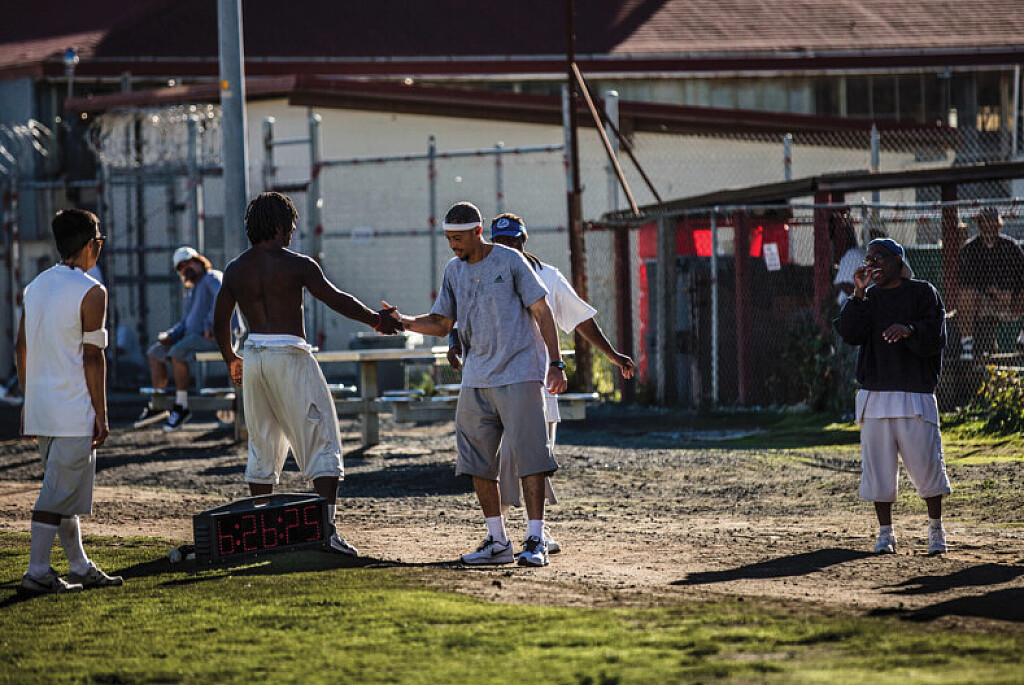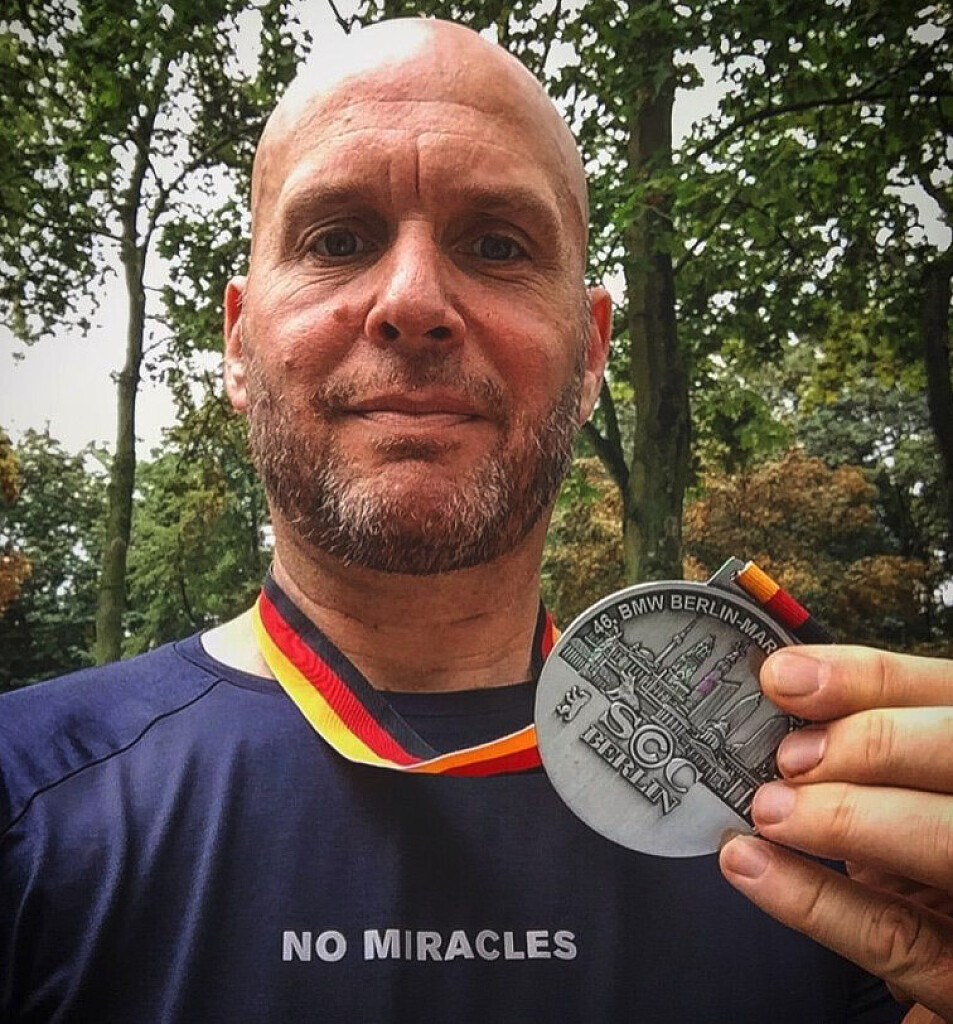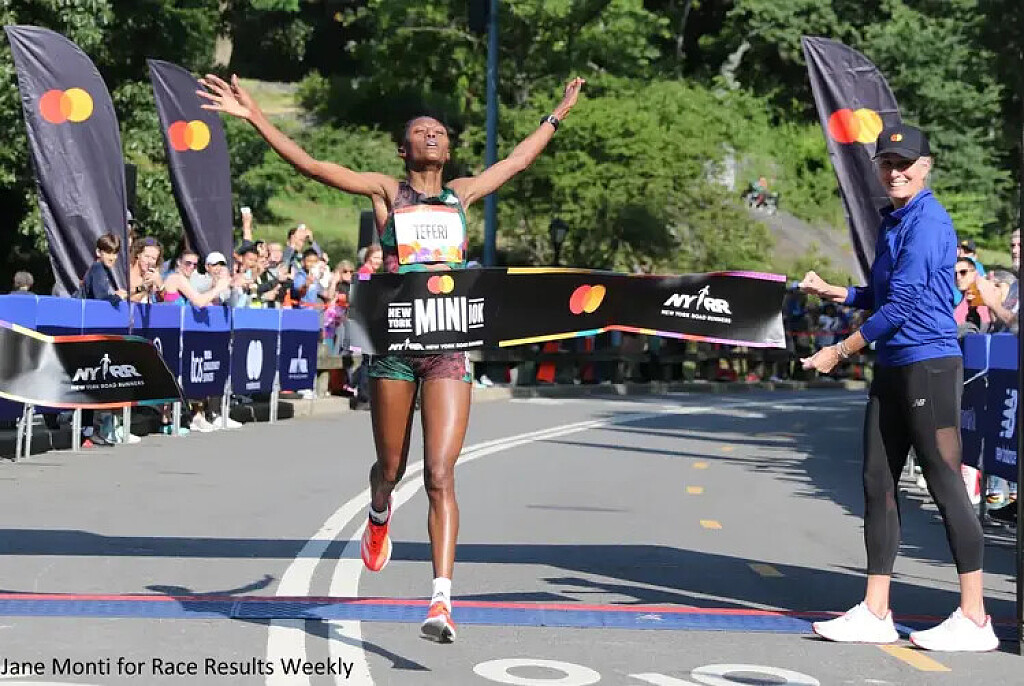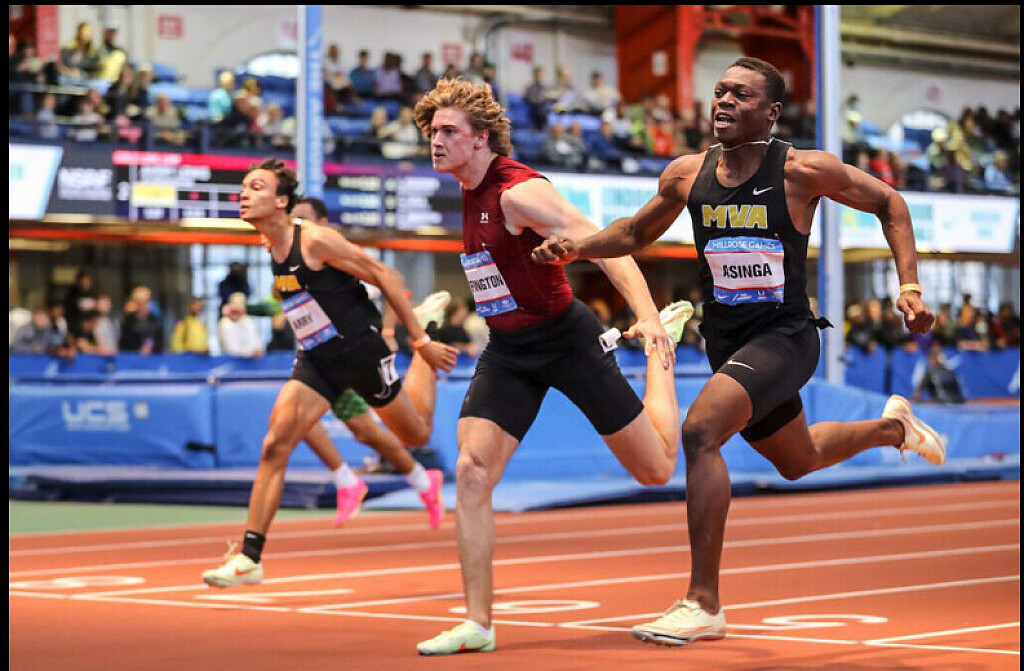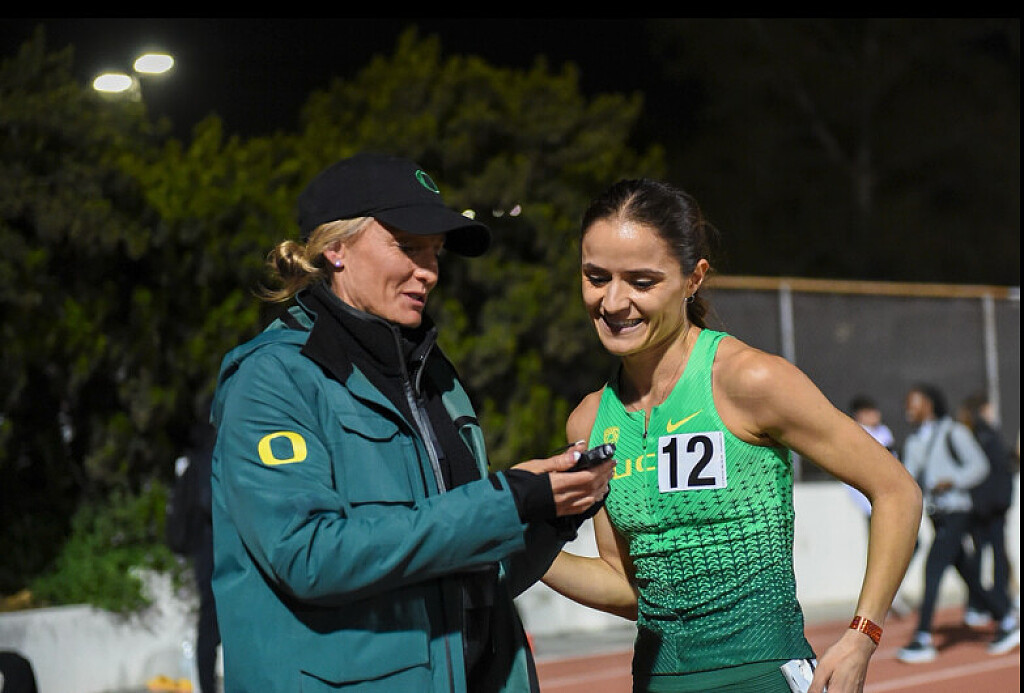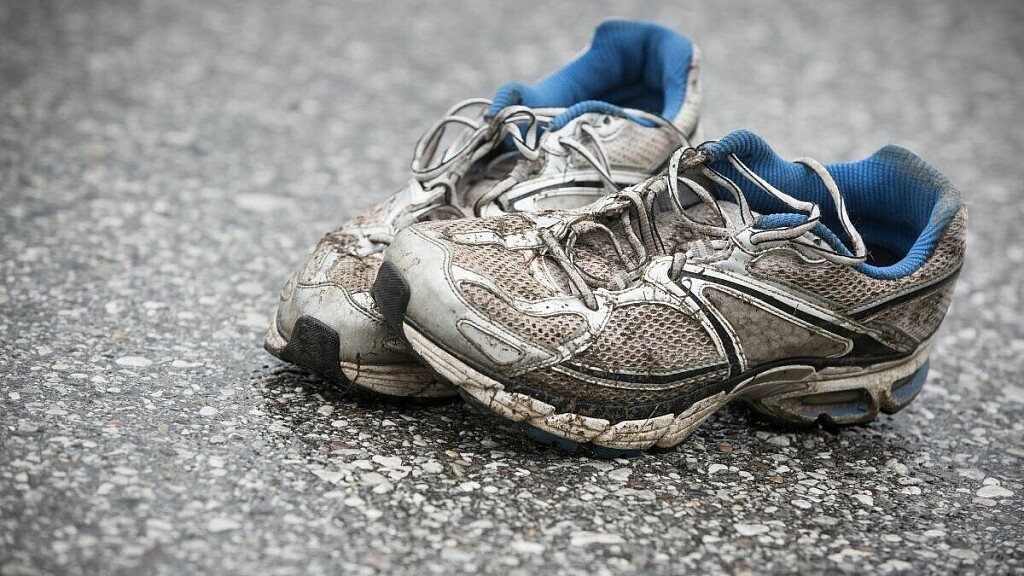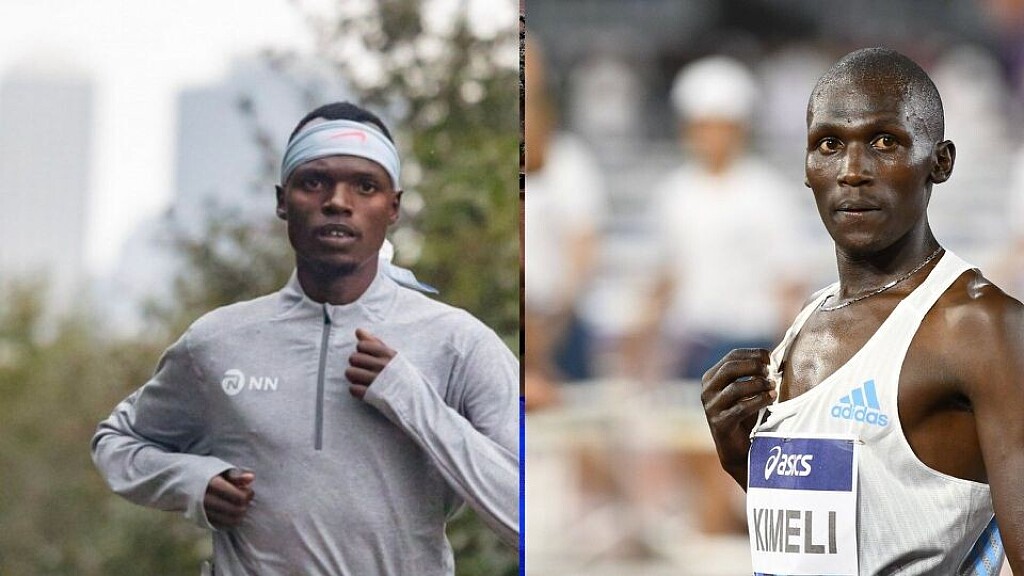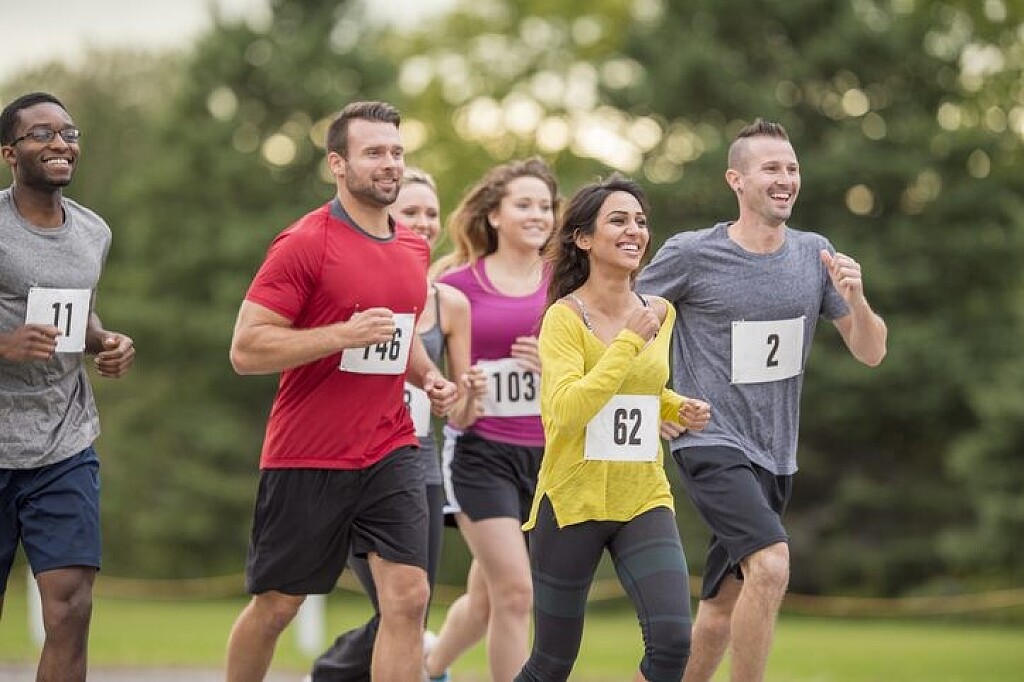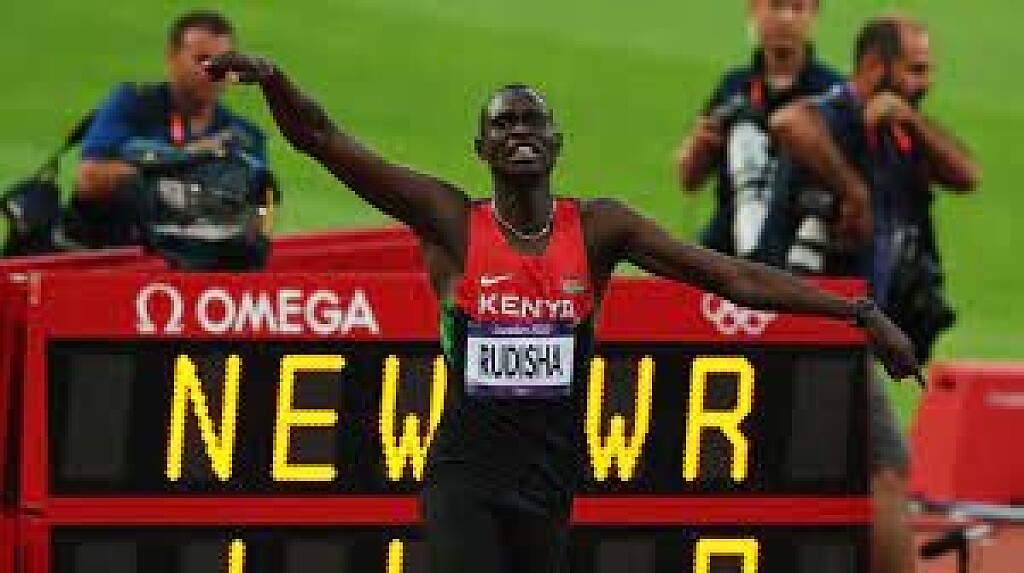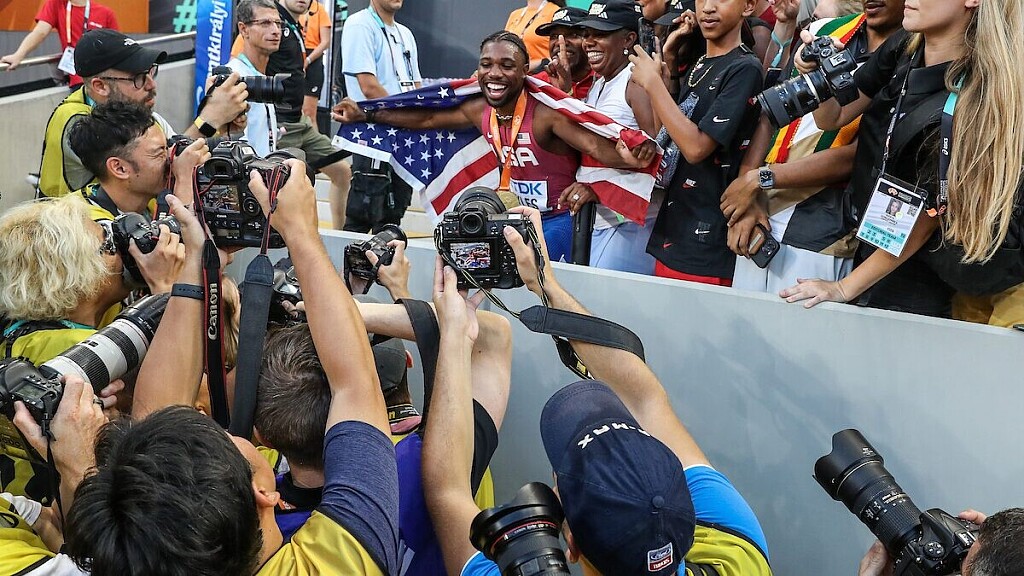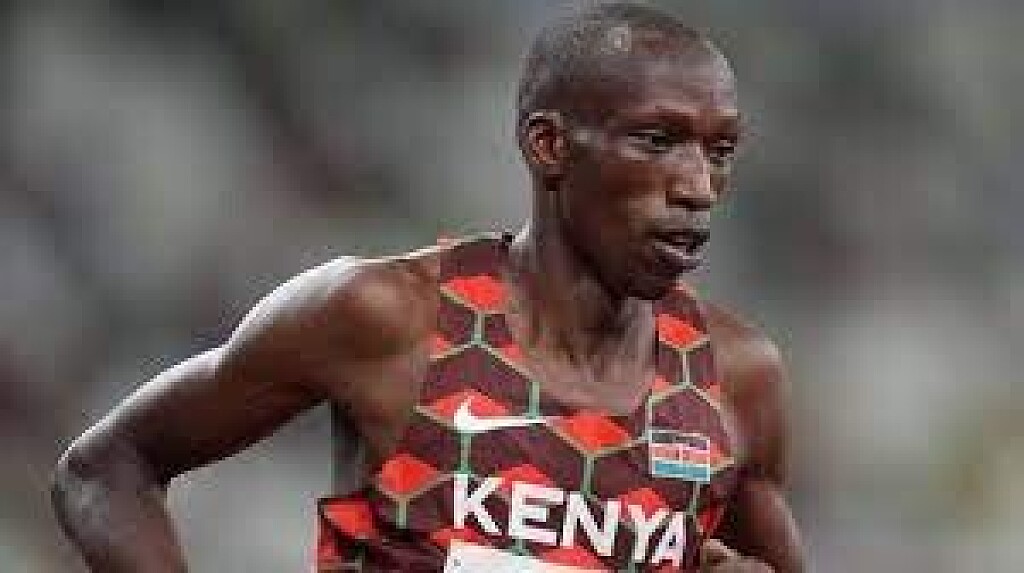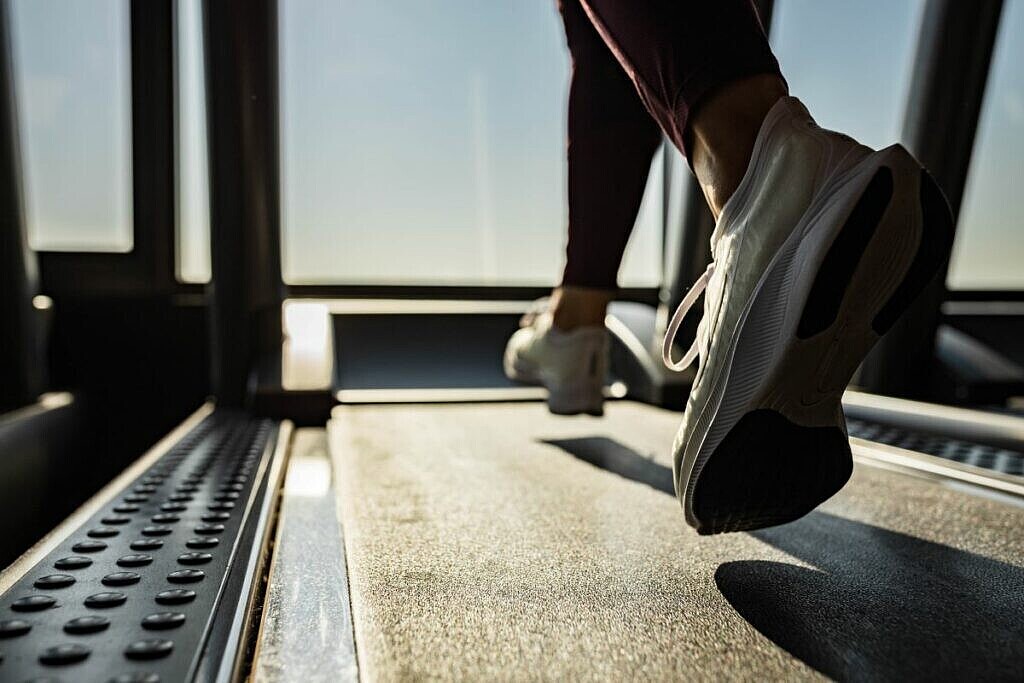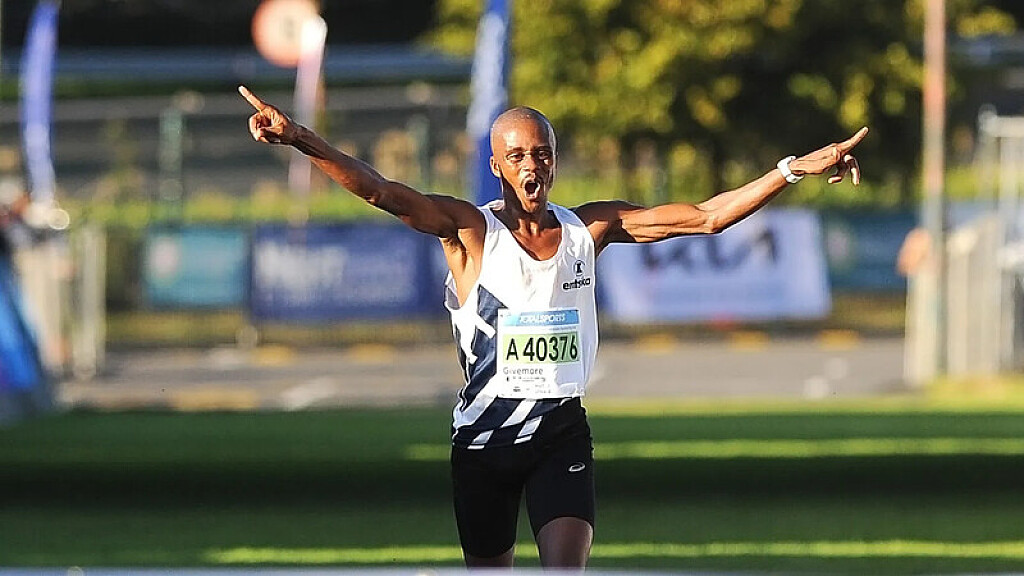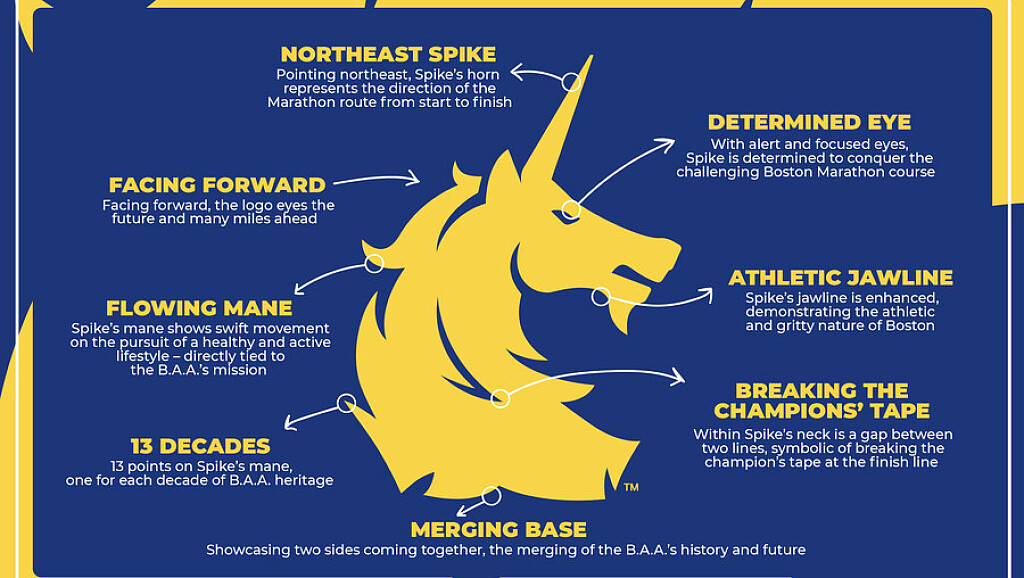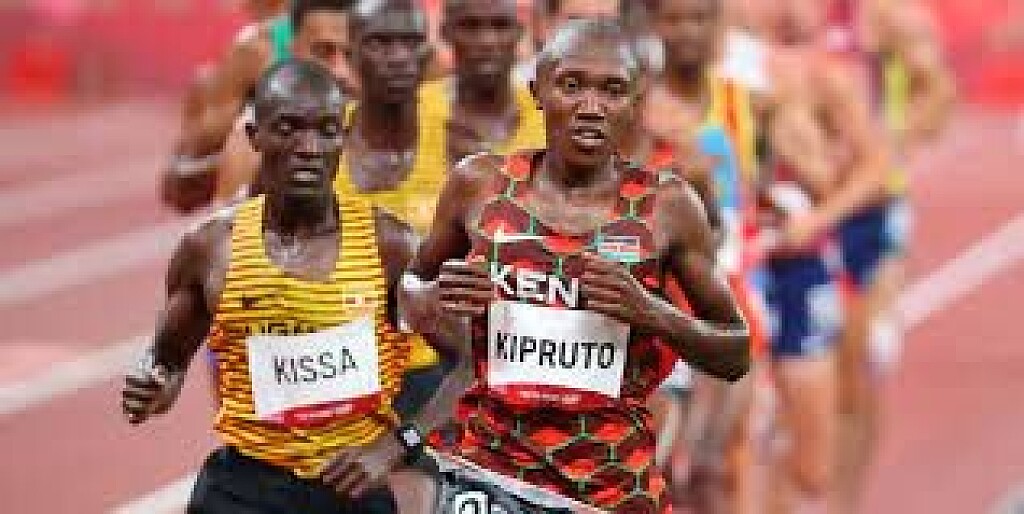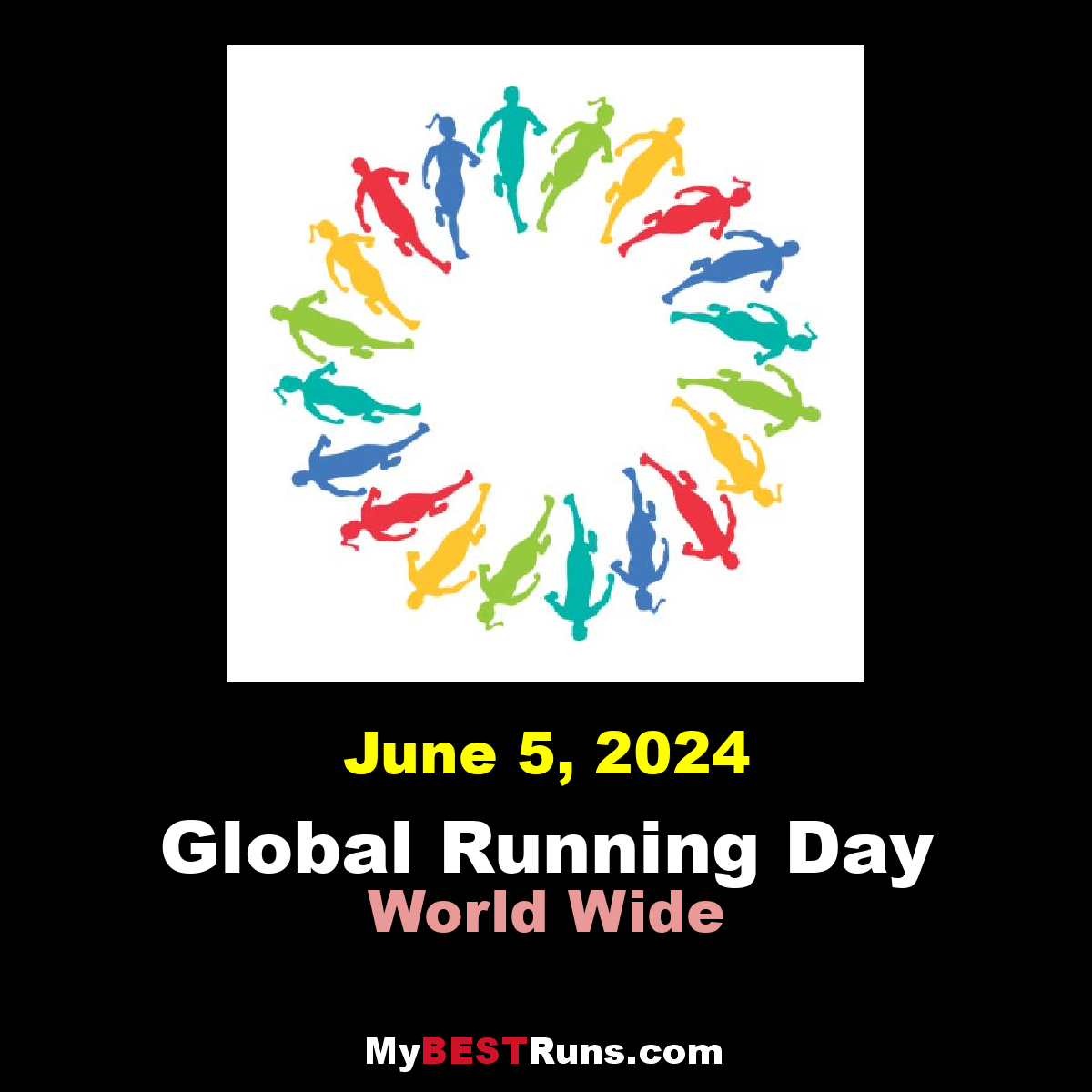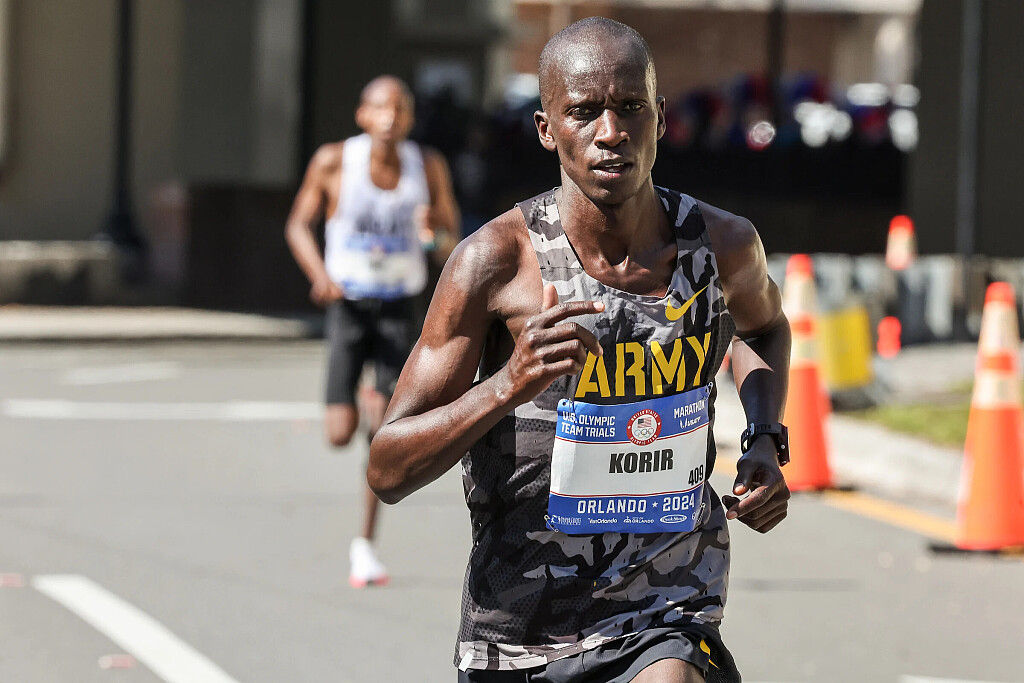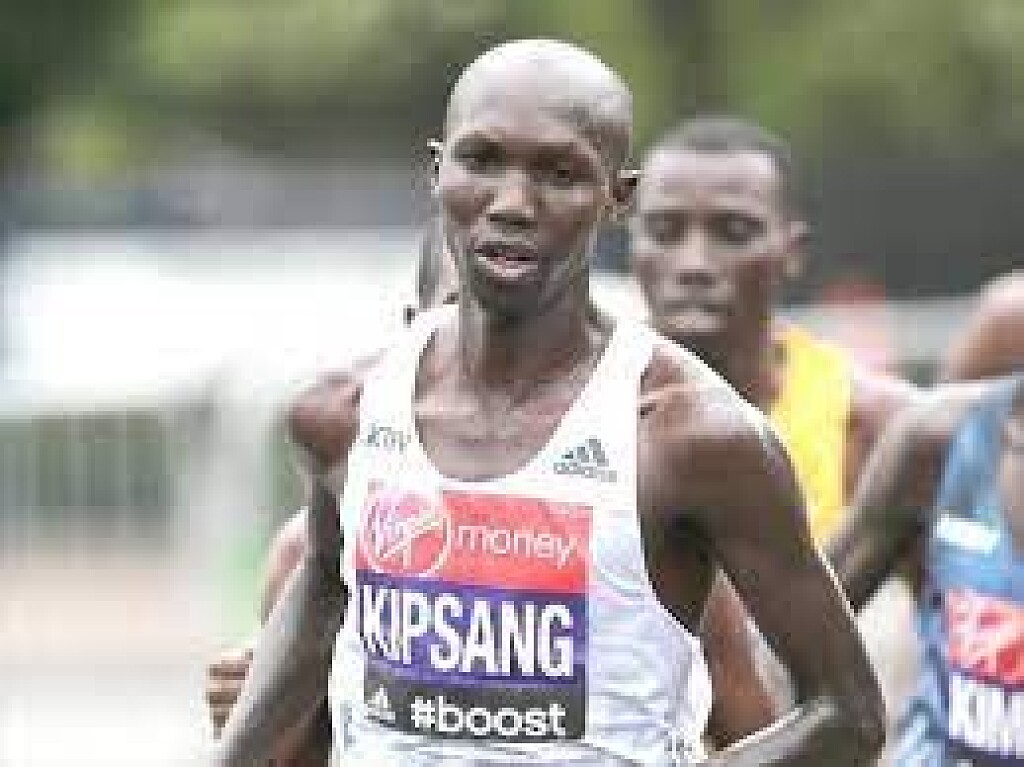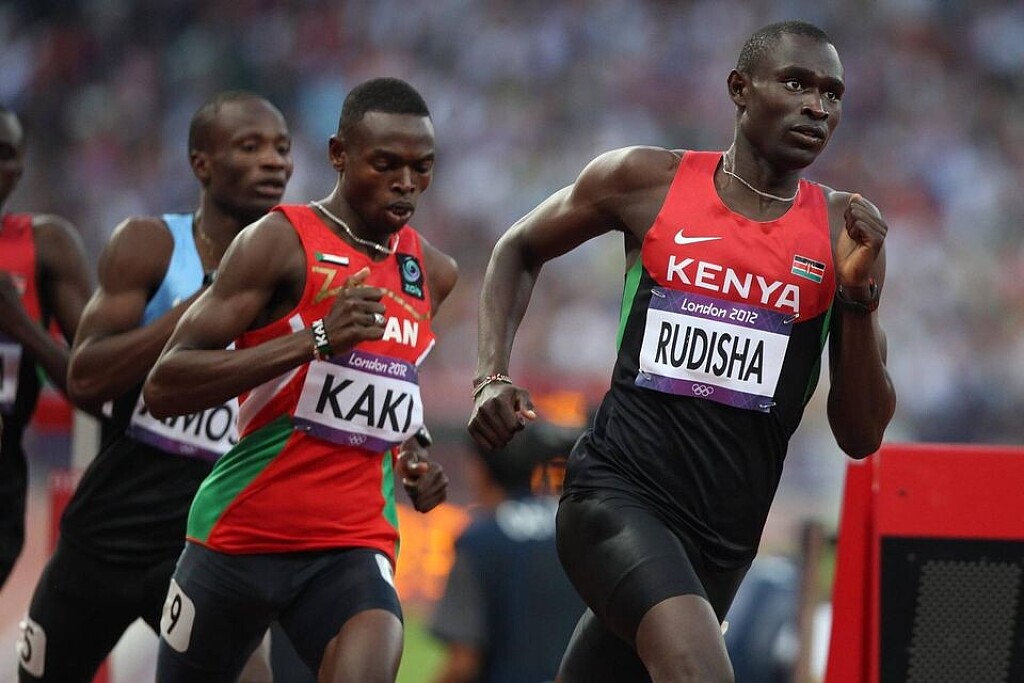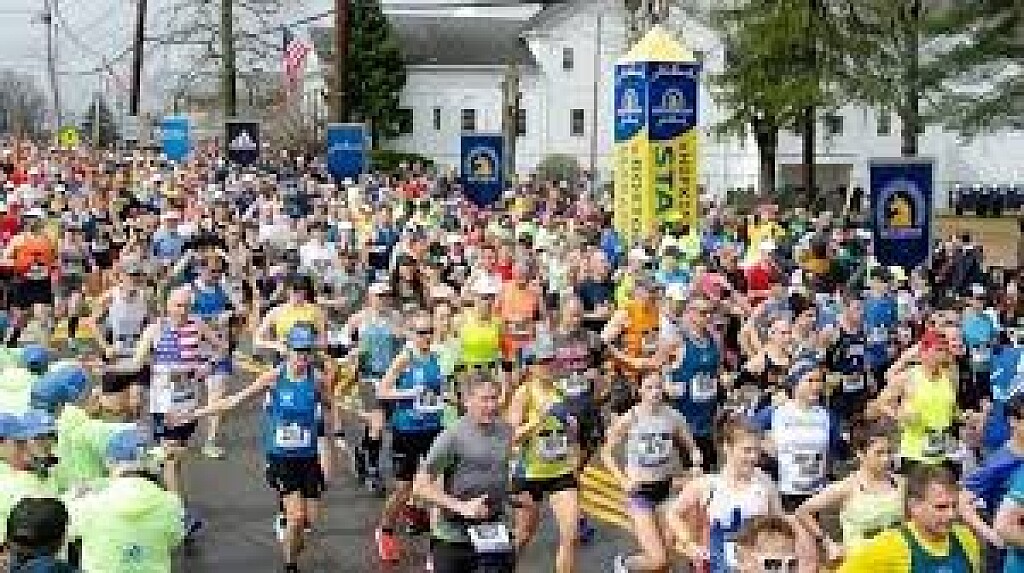Running News Daily
Running News Daily is edited by Bob Anderson. Send your news items to bob@mybestruns.com Advertising opportunities available. Train the Kenyan Way at KATA Kenya and Portugal owned and operated by Bob Anderson. Be sure to catch our movie A Long Run the movie KATA Running Camps and KATA Potato Farms - 31 now open in Kenya! https://kata.ke/
Index to Daily Posts · Sign Up For Updates · Run The World Feed
Julia Hawkins is 105 and still going strong
At 105 years old, Julia "Hurricane" Hawkins has just completed 100 meters in an official competition, making her the oldest woman ever to do so.
This incredible achievement shows that age is nothing but a number. It’s never too late to start at any age. Julia has dropped the excuses and kept moving, proving that fitness is for life.
Let her story inspire you to keep going, no matter where you are in your journey.
(06/14/2024) ⚡AMPEmmanuel Wanyonyi to execute different strategy for 800m final after being handed bye at Olympic trials
World 800m silver medallist Emmanuel Wanyonyi has received a major relief after being reinstated to Saturday’s 800m final, having missed out due to an unfortunate fall in the semi-final.
World 800m silver medallist Emmanuel Wanyonyi has earned a major relief after being reinstated to the 800m final at the Athletics Kenya Olympics trials on Friday.
Wanyonyi had been left in uncertainty having missed a place in the final after tripping and falling during Friday’s semi-final at Nyayo Stadium.
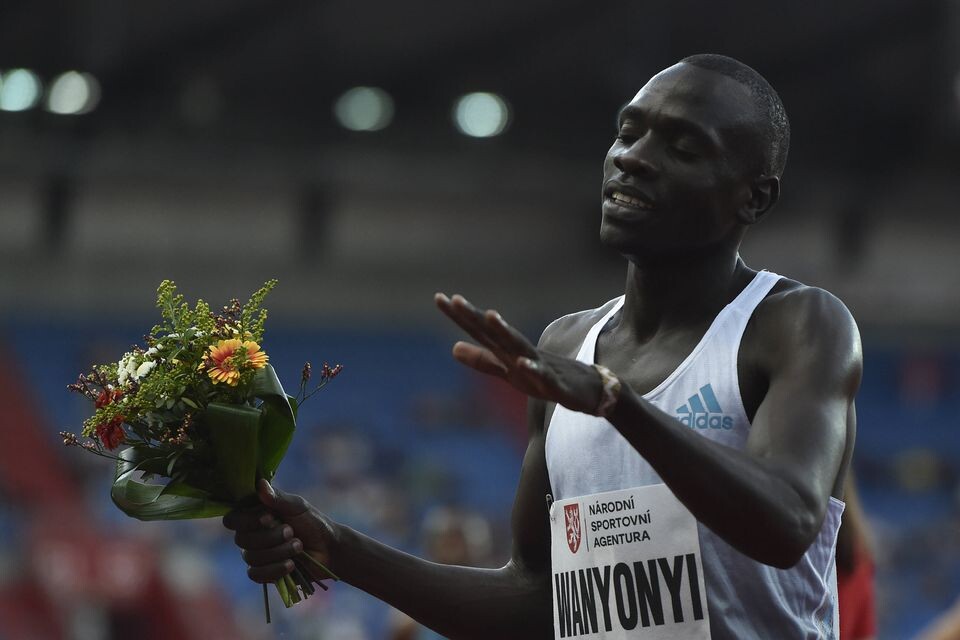
The 19-year-old took the lead then tried to slow down his semi-final but he got overtaken in the last 300m and as he tried to catch up, he tripped and fell.
It saw him miss out on a place in the final, after finishing last, and following an appeal, he was granted a chance in Saturday’s final, where he will now seek to make amends by claiming an automatic ticket to the final
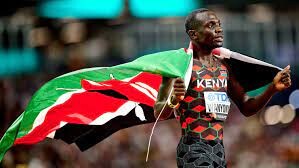
“I am in good shape and on Saturday, it will be about executing a good race. I have the desire to win and to make the team to the Olympics,” said Wanyonyi, who admitted that he will need a change of strategy on Saturday.
“I will have to think how I run in the final, I cannot use the same tactic I used today [Friday],” he added.
The 19-year-old is Kenya’s biggest hope for a medal in the men’s 800m at the Paris Olympics.
(06/14/2024) ⚡AMPby Joel Omotto
Kenyan Olympics trials
National trials to select a team to fly Kenya's flag at the Paris 2024 Olympics are underway at Nyayo National Stadium. The two-day event will culminate in the selection of a team from Kenya for this year's athletics showpiece in Paris. Day one has seen some thrilling performances, with athletes giving their all for a spot on Team Kenya. The...
more...Moraa's fate hangs in the balance as Athletics Kenya makes decision on Olympics 800m team
The 800m runner is keeping her fingers crossed following a dramatic race at the Olympics trials on Friday.
Mary Moraa put family first when she allowed her cousin Sarah Moraa a podium place in the 800m at the Olympic trials at Nyayo Stadium on Friday.
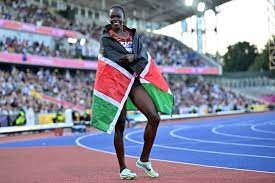
With the world champion a shoo-in for the Olympics given her status and the fact that she already has the qualifying mark, Mary Moraa still stayed in the leading pack but at the final stretch, she slowed down to allow her cousin to close in.
However, it is Lilian Odira who ended up as the main beneficiary as she claimed victory, and most crucially, secured the Olympic qualifying time after clocking 1:59.27.

For Sarah Moraa, the ‘through pass’ from her cousin was still not helpful as she finished in third -place in a time 1:59.39, falling behind the 1:59.30 required to qualify for the Olympics.
The world champion was second in 1:59.35, securing the final automatic qualifying spot.
Meanwhile for Odira, it is a massive boost for her after showing great signs since coming back from maternity break.
Odira finished fourth at the African Games in March and will hope to keep improving with a great performance at the Olympics.
Sarah Moraa’s fate now hangs in the balance as she will have to wait to know if she will be the third athlete who will be selected by Athletics Kenya, which would mean seeking a qualifying standard at other events before the June 30 deadline.
If that is not the case, another athlete with an Olympic standard will be selected to represent the country.
(06/14/2024) ⚡AMPby Joel Omotto
Kenyan Olympics trials
National trials to select a team to fly Kenya's flag at the Paris 2024 Olympics are underway at Nyayo National Stadium. The two-day event will culminate in the selection of a team from Kenya for this year's athletics showpiece in Paris. Day one has seen some thrilling performances, with athletes giving their all for a spot on Team Kenya. The...
more...15-year-old U.S. high schooler runs crazy 800m time
At 15, most teenagers are grappling with calculus homework or dreaming about getting their driver’s license. Cooper Lutkenhaus, however, is making history on the track. This high school freshman from Justin, Texas, shattered the American U18 800m record on Wednesday at the Brooks PR Invitational in Renton, Wash., clocking an astonishing 1:47.58, the fastest time ever recorded by a U.S. high school freshman.
Lutkenhaus broke the previous American U18 record of 1:47.96 set by Michael Granville in 1995, (thirteen years before Lutkenhaus was born.) He now ranks seventh all-time among U.S. high schoolers, (and only in ninth grade.)

Lutkenhaus reportedly opened with a 54.36-second first lap and closed with a negative split of 53.21 seconds over the final 400m.
This season, he is undefeated in the 800m, and his new personal best time is only eight-one-hundredths of a second off the world U16 record held by British 800m runner Max Burgin.
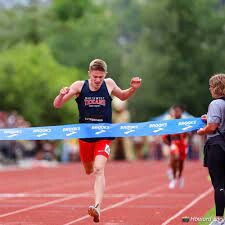
According to the Dallas Morning News, Lutkenhaus began his track career as a 400m runner but showed great potential when he moved up to the 800m. In the last three months, he has lowered his personal best by seven seconds (from 1:54 to 1:47), a massive margin for the distance.
Lutkenhaus will have three more years to pursue the U.S. high school record of 1:46.45 set by Granville in 1996. This achievement marks the third time this year that he has broken the national record for freshmen, with his previous best being 1:49.12 at the RunningLane Track Championships in May.
(06/14/2024) ⚡AMPby Marley Dickinson
Two B.A.A. Athletes Qualify For U.S. Olympic Team Trials
The Boston Athletic Association (B.A.A.) today announced that B.A.A. High Performance Team members Annie Rodenfels and Bethany Hasz have earned spots on the starting line for the U.S. Olympic Team Trials – Track & Field, to be held later this month in Eugene, Oregon from June 21-30.
Rodenfels will compete in the women’s 3000m steeplechase (preliminary round June 24/final on June 27), while Hasz will toe the line in the women’s 5000m (preliminary round on June 21/final on June 24).
The Trials will be held at historic Hayward Field in Eugene, Oregon, with top three finishers in each event slated to qualify for the Paris Olympic Games (so long as athletes have met the Olympic standard or earned enough qualifying points).
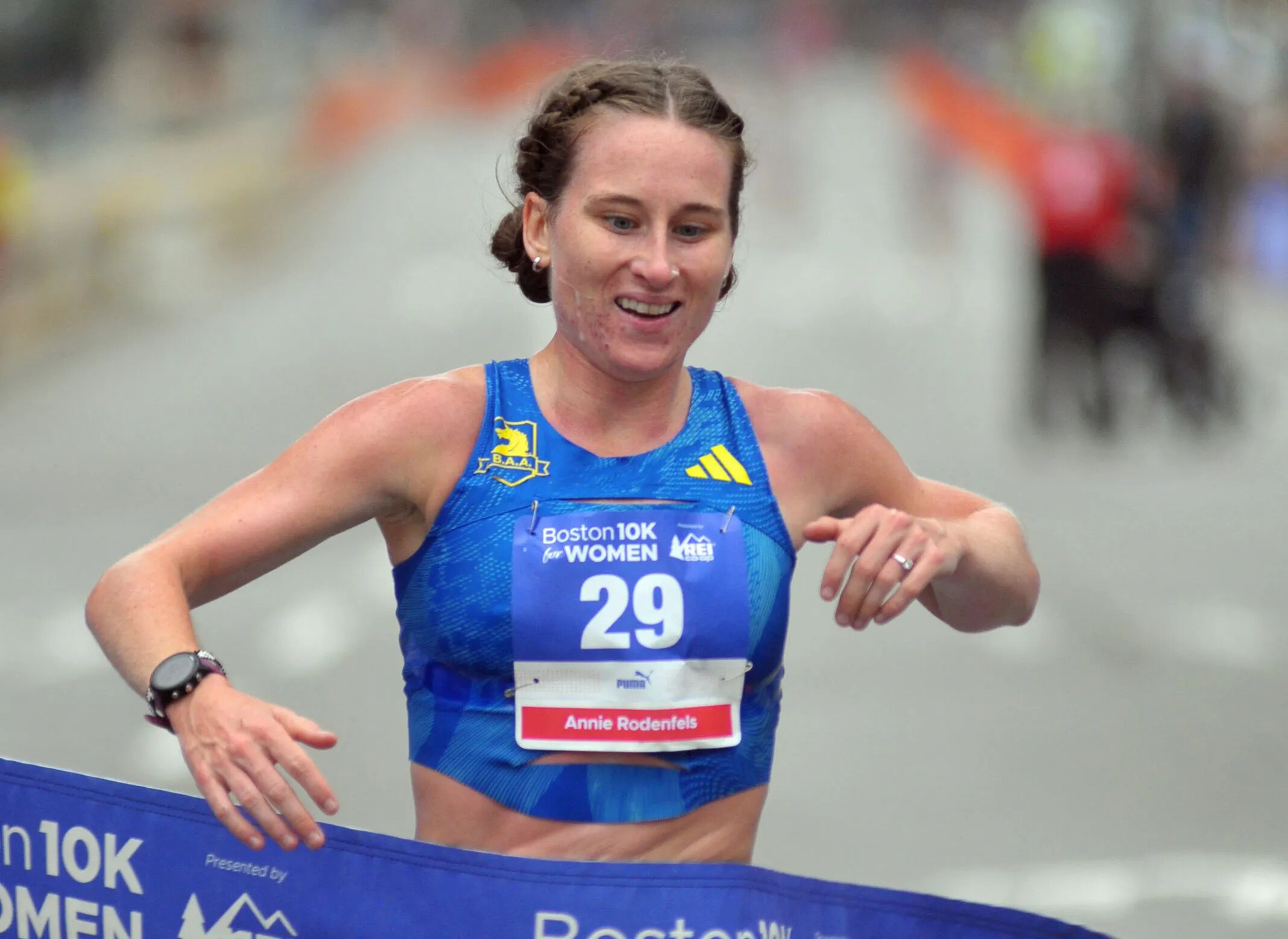
Rodenfels’ personal best in the steeplechase is 9:25.48, set last year. She won the steeplechase at the Drake Relays this year (9:31.03), was fourth at the Boston 5K in April, and clocked 15:03.97 indoors for 5000m in December 2023. Last fall she won the USATF 5K National Championship on the roads in New York City.
Hasz is coming off a 5000m lifetime best of 15:05.80 set May 17 in winning the Drake Relays 5000m. This year she’s also recorded personal bests in the road 5K (15:30), road 10K (32:03), and mile indoors (4:39.24). She earned a bronze medal at the 2023 USATF 5K National Championships, finishing third just behind Rodenfels and Olympian Rachel Smith.

The B.A.A.’s High Performance team supports runners on their way towards making international teams, with the goal of competing at the highest level: the Olympic Games, World Athletics Championships, and Abbott World Marathon Majors. The B.A.A. is sponsored by adidas, which provides comprehensive support for the organization’s High Performance team, running club, and mass-participatory events.
B.A.A HIGH PERFORMANCE TEAM ROSTER:
Eric Hamer
Bethany Hasz
Megan Hasz
Josh Kalapos
Barry Keane
Matt McDonald
Annie Rodenfels
Abbey Wheeler
ABOUT THE BOSTON ATHLETIC ASSOCIATION (B.A.A.)
Established in 1887, the Boston Athletic Association is a non-profit organization with a mission of promoting a healthy lifestyle through sports, especially running. The B.A.A. manages the Boston Marathon, and supports comprehensive charity, youth, and year-round programming. The 129th Boston Marathon presented by Bank of America is scheduled to take place on Monday, April 21, 2025. The Boston Marathon is part of the Abbott World Marathon Majors, along with international marathons in Tokyo, London, Berlin, Chicago, and New York City. For more information on the B.A.A., please visit www.baa.org.
(06/14/2024) ⚡AMPby B.A.A.
U.S. Olympic Team Trials Track And Field
Eugene, Oregon has been awarded the 2024 U.S. Olympic Team Trials - Track & Field, USA Track & Field and the U.S. Olympic & Paralympic Committee announced today. From June 21 to 30, Hayward Field at the University of Oregon will be home to one of the biggest track and field competitions in the country, as the U.S. Olympic Team...
more...Noah Lyles says his goal is to win four gold medals in Paris
The world 100m champion appeared on The Tonight Show with Jimmy Fallon and said he wants to become the first male sprinter to win four Olympic gold medals.
The world 100m champion, Noah Lyles, appeared on The Tonight Show with Jimmy Fallon on Monday night to discuss his role in the upcoming Netflix documentary series “Sprint” and his goals for the Paris Olympics. Lyles confidently stated his ambition to achieve something no male track and field athlete has done before: win four gold medals at a single Olympics.
“Everyone knows Usain Bolt; I want to be faster and more decorated than Bolt,” Lyles told Jimmy Fallon. “He’s done three. I want four, that’s the Mount Rushmore–now you’re the greatest of the great.”

At the 2023 World Championships in Budapest, Lyles became the first athlete to win the sprint double (100m and 200m) at a major championship since Bolt did so at Rio 2016. He added another gold medal in the men’s 4x100m, where Team USA redeemed themselves after finishing second to Canada in 2022 on home soil.
For Lyles to win four gold in Paris, he would need to win the 100m and 200m, 4x100m relay and 4x400m relay.

Only two athletes have won four medals at one Olympic Games: U.S. sprint icon Florence Griffith-Joyner won three golds and one silver medal (in the 4x400m) at Seoul in 1988. Fanny Blankers-Koen of The Netherlands is the only athlete to win four golds–at the 1948 Olympics in London, where she won the 100m, 200m, 4x100m relay, and 80m hurdles.
When Fallon asked Lyles why he wanted to put extra pressure on himself for Paris, Lyles said his goal is to win Olympic medals and break world records. “It’s been a long time since someone has done it, but growing up, I’ve always felt like that title belongs to me.” Bolt’s world records of 9.58 in the 100m, and 19.19 in the 200m have been untouched for the past 15 years.
Despite being the world champion in the 100m and 200m, Lyles’s first test will come at the USATF Olympic Trials from July 21-30 in Eugene, Ore., where he will aim to make his second Olympic team. The top three finishers in each event at trials will secure a spot on the U.S. Olympic team, provided they have met the Olympic standard or are in the World Athletics rankings quota.
(06/13/2024) ⚡AMPby Marley Dickinson
Paris 2024 Olympic Games
For this historic event, the City of Light is thinking big! Visitors will be able to watch events at top sporting venues in Paris and the Paris region, as well as at emblematic monuments in the capital visited by several millions of tourists each year. The promise of exceptional moments to experience in an exceptional setting! A great way to...
more...Sha'Carri Richardson looking to make her Olympic debut
At the very end of Sha’Carri Richardson's road to redemption lies a gold medal.
The track and field star, whose 2021 disqualification cost her a chance to compete in the Tokyo Olympics, is quickly making her way down that road as she looks to secure her spot on Team USA for the 2024 Olympics in Paris.
"What would it mean to make it to Paris? Just literally all the training, all of the support, all of the naysayers, it pays off," Richardson told NBC. "It pays off in that moment when you realize when you made that Olympic team."

Richardson, a Dallas native, made the 2021 Olympic team after winning 100m event at the trials to qualify, but she later test positive for THC, the chemical in cannabis. She was disqualified for one month, which prevented her from competing in on sports' grandest stage during the Tokyo Games.
The Olympics went on without her.

She returned to the track at the 2021 Prefontaine Classic, finishing ninth. She returned to Olympic form nearly two years later, officially kicking off her revenge tour.
She won the 100m at the U.S. Track and Field Championships in a time of 10.82 seconds. She then claimed the title of fastest woman in the world with her 100m win at the 2023 World Athletic Championships in Budapest. She went on to kick off the Olympic year with a win at the Prefontaine Classic in a time of 10.83 seconds.
"I'm better, I'm stronger and I'm wiser," Richardson said. "I just knew that I was in a different position that I've never been in my entire life."
That soon could lead the 24-year-old to other places she has not yet been: the Olympics, and possibly the top of the podium.
Richardson is scheduled to run in her first Olympic trials preliminary on June 21 in Eugene, Oregon.
If she qualifies for the Games, she'll look to become the first American woman to win gold in the 100 meter since Florence Griffith-Joyner in 1988.
Richardson is back on track, literally and figuratively, and she credits her family for helping to lead her down the road to Paris.
"My family is so special to me, only for the fact that they know me, supported me and been there for me much longer than I even knew I was going to be who I was," Richardson said. "They knew who I was going to be before I even put it together."
(06/13/2024) ⚡AMPby Mike Gavin
Paris 2024 Olympic Games
For this historic event, the City of Light is thinking big! Visitors will be able to watch events at top sporting venues in Paris and the Paris region, as well as at emblematic monuments in the capital visited by several millions of tourists each year. The promise of exceptional moments to experience in an exceptional setting! A great way to...
more...Walmsley and Schide favorites as Western States line-ups are finalized
Americans Jim Walmsley and Katie Schide, both UTMB winners, will head the finalized fields for the 51st edition of Western States 100 Endurance Run at the end of this month.
Western States is the oldest and arguably the most iconic 100-mile trail run in the world and the stars are again out in force Auburn on June 29-30.
Can Walmsley make it four?
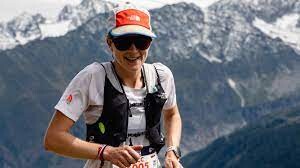
Last year Walmsley memorably ended his quest to finally add a UTMB title in Chamonix to his CV and he’s the current course record holder at Western States, which he’s already won three times.
His time of 14:09:28 from 2019 hasn’t been bettered since and he’s the highest-ranked runner in terms of the UTMB index at 934 (Kilian Jornet is top on 941).
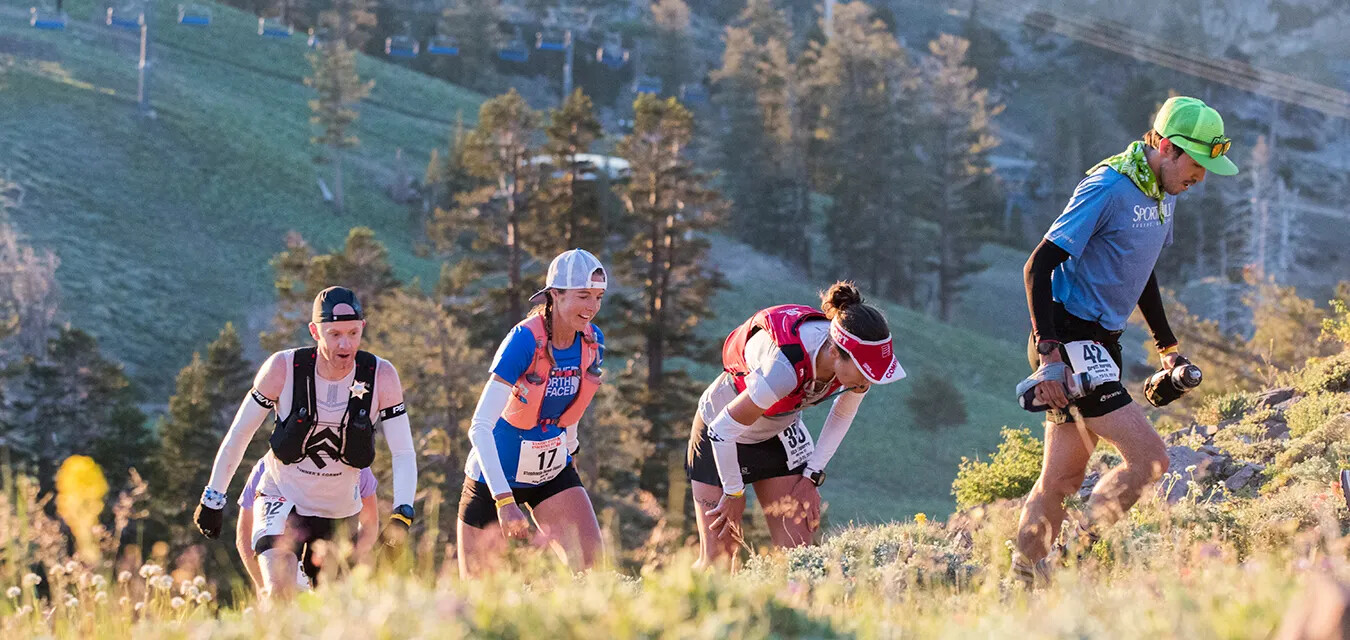
But he’ll face a raft of strong rivals including the 2023 runner-up Tyler Green (USA, UTMB Index 880) and several other top finishers from 2023, including fourth-placed Jiasheng Shen (CHN, UTMB Index 906).
Dakota Jones (USA, UTMB Index 902), Ji Duo (CHN, UTMB Index 889) and Hayden Hawks (USA, UTMB Index 910) booked their spots alongside Walmsley via Golden Tickets from top-three performances at other big events.
Schide the one to beat
And on the women’s side the 2022 UTMB winner Katie Schide (UTMB Index 825) will be looking to go one better than last year’s second place at Western States.
Only superstar Courtney Dauwalter on 847 is ahead of Schide on the UTMB Index but the reigning Western States champion (who smashed the course record time when beating Schide) won’t be back to defend her title.
That means that Schide, who underlined her form with victory at the Canyons Endurance Runs by UTMB at the end of April, starts as the clear favourite.
But she too will face tough opposition from the likes of Eszter Csillag (HUN, UTMB Index 768), who finished third 12 months ago, and three-time finisher Emily Hawgood (ZWE, UTMB Index 757).
Other big names lining up include former professional IRONMAN athlete Heather Jackson (USA, UTMB Index 764), Eleanor Davis (GBR, UTMB Index 753) and Emily Schmitz (USA, UTMB Index 736).
Jackson recently advertised her gravel racing prowess in a thrilling sprint finish at the famed Unbound event.
We’ll build up to the big event over the next couple of weeks here at RUN247.
(06/13/2024) ⚡AMPby Jonathan Turner
Western States 100
The Western States ® 100-Mile Endurance Run is the world’s oldest and most prestigious 100-mile trail race. Starting in Squaw Valley, California near the site of the 1960 Winter Olympics and ending 100.2 miles later in Auburn, California, Western States, in the decades since its inception in 1974, has come to represent one of the ultimate endurance tests in the...
more...Abel Kipsang puts slow start to season behind as he gears up for tough Olympic trials
Africa 1500m champion Abel Kipsang has disclosed the reason behind his slow start to the season and exuded confidence ahead of the Olympic trials scheduled for this weekend.
Africa 1500m champion Abel Kipsang has exuded confidence ahead of the Olympic trials scheduled for Friday and Saturday at the Nyayo National Stadium.
Kipsang has been off to a mixed start to his season and he explained that his body took sometime to respond to training hence the slow start to his season. He opened his season at the national cross-country championships before make his season debut on the track during the African Games national trials.
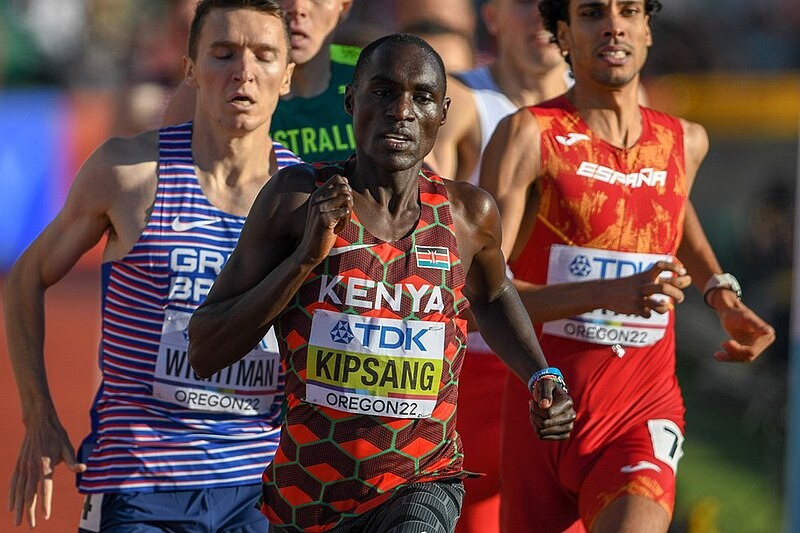
He went to the African Games in Accra, Ghana where he finished second behind Brian Komen and then jetted back into the country for the Kip Keino Classic where she finished fifth in the 800m.
Kipsang then competed in the National Police Service Championships, where he won the race, before finishing 13th at the Diamond League Meeting in Doha. The Kenyan then finished 14th at the USTAF Los Angeles Grand Prix.
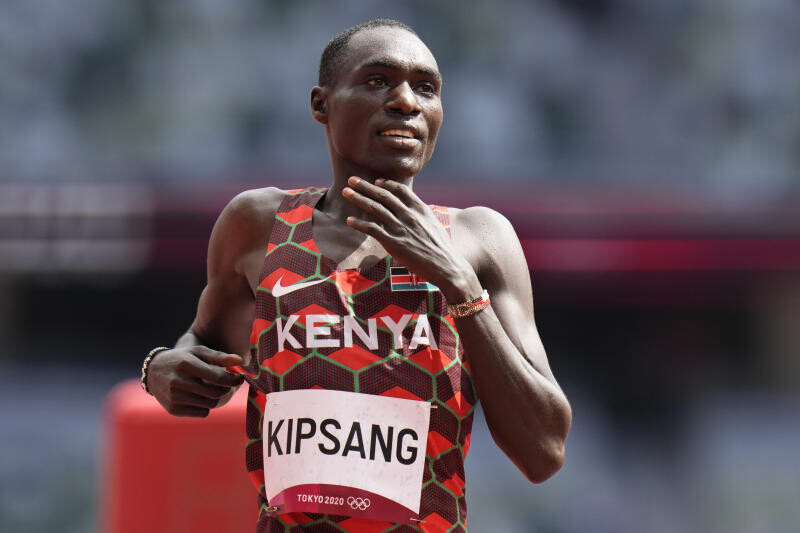
The 27-year-old also competed in the mile at the Prefontaine Classic, the Diamond League Meeting in Eugene, where he finished 12th.
“I know the trials are coming and this season I have not been at my best but I will fight hard and I’m very confident that I’ll make the cut to the Olympics team,” he told Pulse Sports.
“I didn’t have an injury but my body struggled to keep up the pace and was not responding to training the way I wanted. I sat down with my coach and trained well and I feel like my body is doing well at the moment."
The Alex Sang-coaches athlete added that the 1500m at the moment is very unpredictable and anyone can carry the day.
“You cannot win everyday because now in the 1500m, everybody is doing well and they will all be fighting for that Olympic slot,” Kipsang said.
“If I make the cut to the Olympics team, it will be something very nice. I can’t promise right now because I’m yet to qualify but if I do, I will work very hard.”
(06/13/2024) ⚡AMPby Abigael Wuafula
Paris 2024 Olympic Games
For this historic event, the City of Light is thinking big! Visitors will be able to watch events at top sporting venues in Paris and the Paris region, as well as at emblematic monuments in the capital visited by several millions of tourists each year. The promise of exceptional moments to experience in an exceptional setting! A great way to...
more...Jakob Ingebrigtsen wins historic sixth European gold in record time
On Wednesday night at the 2024 European Championships in Rome, Norway’s Jakob Ingebrigtsen became the first track athlete in history to earn six European gold medals, winning the men’s 1,500m with a championship record of 3:31.95. This marks his third consecutive European 1,500m title.
Ingebrigtsen showcased his tactical prowess by initially taking the back of the pack on the first lap. After a swift 56-second start, he surged to the front, slowed the pace, then accelerated again to win gold. He finished two seconds ahead of Belgium’s Jochem Vermeulen and Italy’s Pietro Arese, both of whom earned their first senior European championship medals.
The Ingebrigtsen family, including Jakob’s brothers Filip and Henrik, have dominated the men’s 1,500m at the European Championships, winning the last five gold medals since 2012. The last three European 1,500m titles have been won by Jakob.
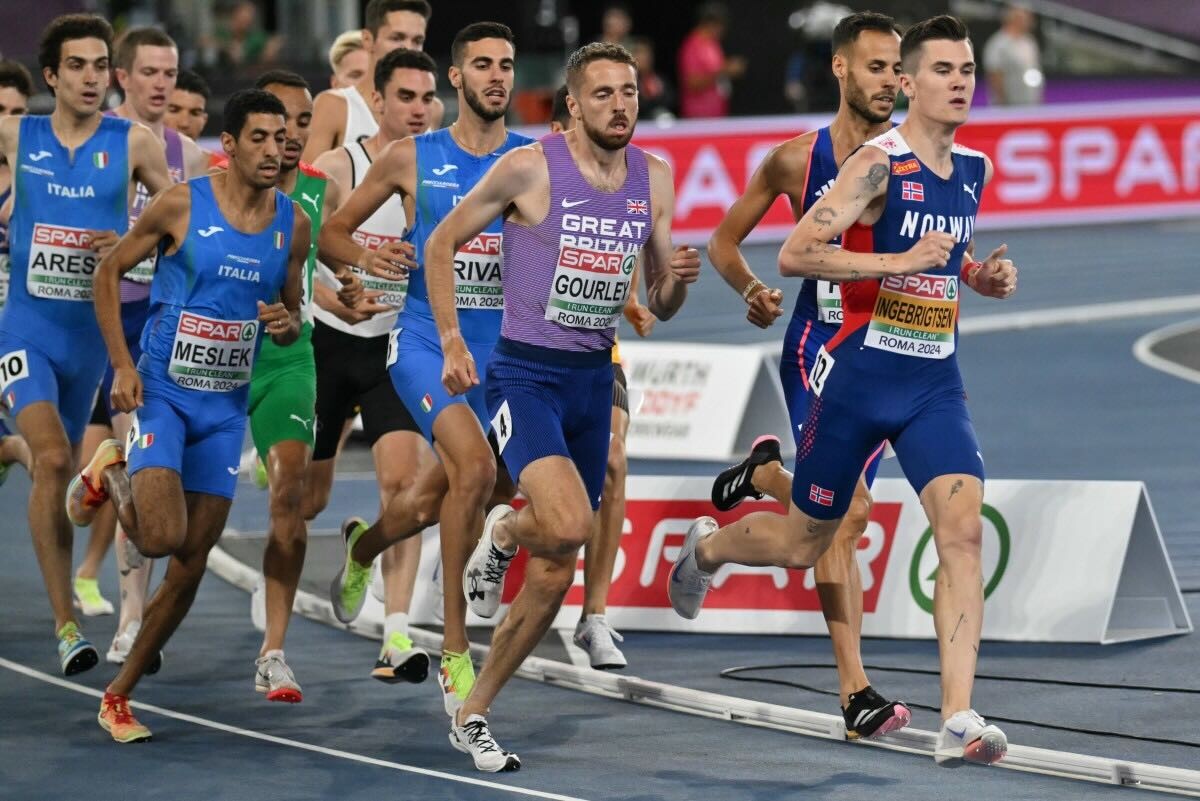
Earlier in the championships, Ingebrigtsen also won gold in the men’s 5,000m event. This is the third time he has achieved the 1,500m/5,000m double at the European Championships, having previously done so in Munich in 2022 and Berlin in 2018.
Notably absent from the championships was Ingebrigtsen’s rival, 1,500m world champion Josh Kerr, who opted to skip the 2024 European Championships to focus on the British Olympic Trials and the Olympics in Paris. Earlier this season, Kerr got the best of Ingebrigtsen in the Bowerman Mile at the Eugene Diamond League in Oregon. He is the only man to beat him twice. (Kerr also outran him at the 2023 World Championships in Budapest.)
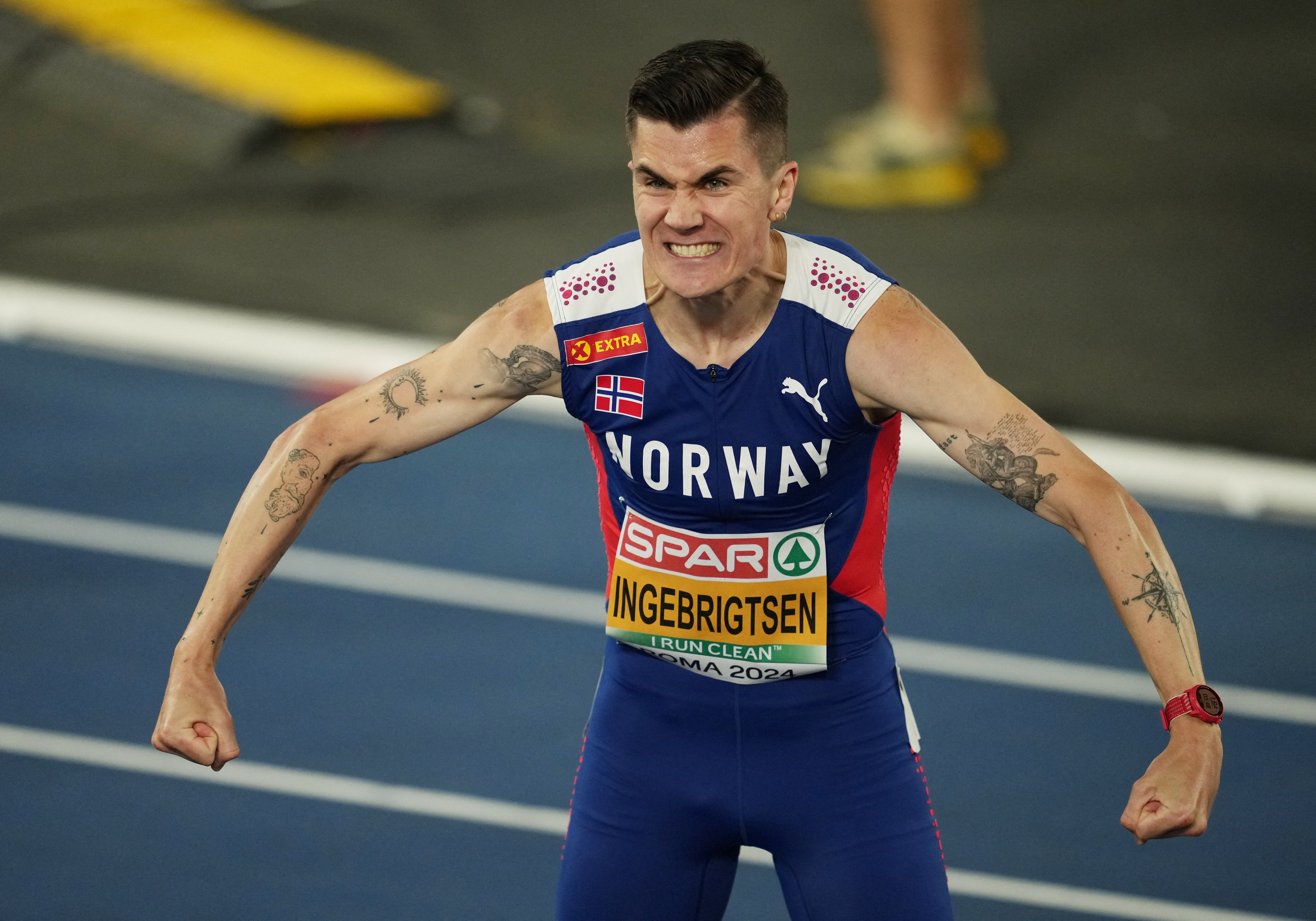
The next likely encounter between Ingebrigtsen and Kerr will be at the Paris Olympic Games.
(06/13/2024) ⚡AMPby Marley Dickinson
Paris Olympic athletes won’t have air conditioning in Village
Last summer, Paris experienced record-breaking heat in late July and early August, with temperatures exceeding 35 C for seven of 14 days.
Athletes competing at the 2024 Paris Olympic Games can look forward to some warm summer nights without air conditioning in the Olympic Village. According to InsideTheGames, to make Paris 2024 the most sustainable and environmentally friendly Games in history, the organizing committee has designed the Olympic Village to rely on natural resources and an innovative underground cooling system, instead of (traditional) air conditioning.
The Olympic Village’s cooling system will draw water from the River Seine to cool power plants. The chilled water will circulate through the buildings’ pipes to reduce room temperatures. It’s no surprise that many athletes are skeptical the system will sufficiently cool their living quarters for crucial rest periods.
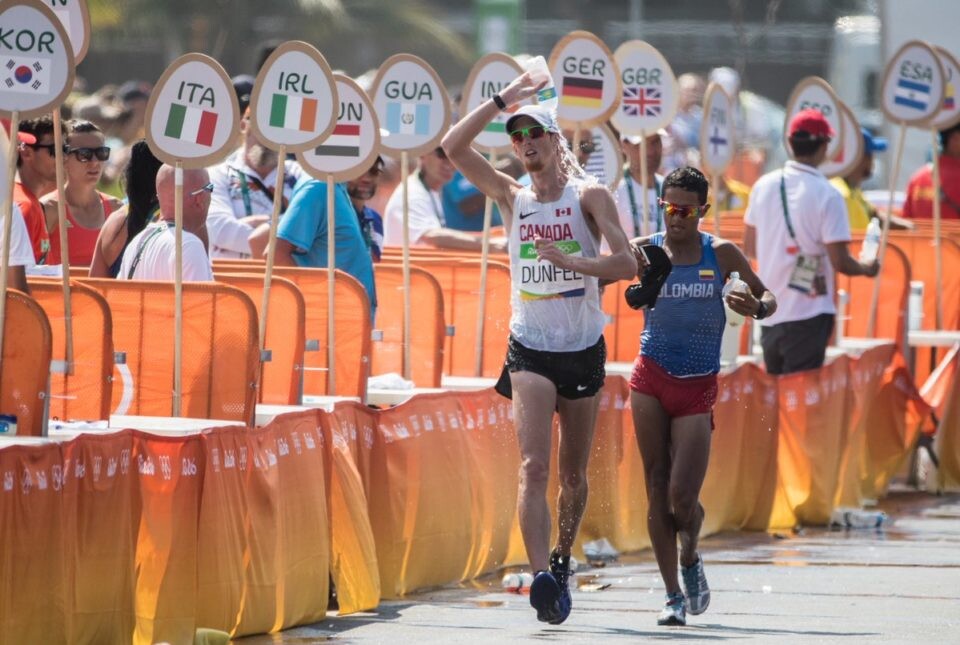
The average daily temperature in Paris for August is 26 C, with nightly lows around 14 C. Last summer, Paris experienced record-breaking heat in late July and early August, with temperatures exceeding 35 C for seven of 14 days.
Many athletes and national Olympic federations are reportedly taking matters into their own hands and threatening to bring their own portable air conditioners to the Olympic Village. The Australian Olympic Committee, in an effort to prioritize high performance, has decided to install air conditioning in all their athletes’ rooms. “This is strategic for high performance and will help them sleep,” said Anna Meares, head of the country’s delegation told The Guardian.

The Greek Olympic Committee will follow suit, further challenging the Paris 2024 organizers’ goal of reducing the carbon footprint of the Games by half, compared to previous editions. “Despite outside temperatures of 41 C, we had 28 C in most of these rooms,” said Laurent Michaud, director of the Olympic Village to InsideTheGames. “Air conditioning would only be necessary during extreme heat waves, as indoor temperatures rarely exceed 26 C.”
Several other countries, including Team USA, Great Britain and Italy, are considering portable air conditioning units for their athletes–a move that undermines the International Olympic Committee’s sustainability goal.
(06/12/2024) ⚡AMPby Marley Dickinson
Paris 2024 Olympic Games
For this historic event, the City of Light is thinking big! Visitors will be able to watch events at top sporting venues in Paris and the Paris region, as well as at emblematic monuments in the capital visited by several millions of tourists each year. The promise of exceptional moments to experience in an exceptional setting! A great way to...
more...Boston Marathon qualifying standards to remain the same for 2025
After much speculation, the Boston Athletic Association (B.A.A.) says marathon qualifying times will not change.
On Monday, the Boston Athletic Association (B.A.A.) announced that it will not raise the entry standards for the 2025 Boston Marathon. This news will be a sigh of relief for many runners who have already achieved a Boston qualifying time for next year.
According to the B.A.A., the qualifying standards across all age brackets will remain the same as they were for the 2024 Boston Marathon. However, achieving a qualifying standard does not guarantee entry into the marathon. If applications exceed capacity, those applicants who exceed their qualifying time standards by the smallest margins may not be accepted.
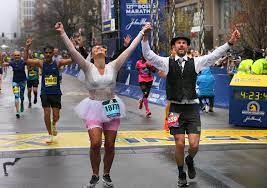
At the 2024 Boston Marathon, there was a cutoff time of five minutes and 29 seconds per age group, one of the largest since time cutoffs were introduced in 2012. There were more than 33,000 applicants last year, with more than 11,000 athletes turned down despite hitting qualifying times.
Due to the large number of athletes being turned down in 2024, there was much speculation about whether the B.A.A. would raise the entry standards for 2025. The field size for the 129th Boston Marathon will remain at 30,000 participants and the race will take place on Monday, April 21, 2025.
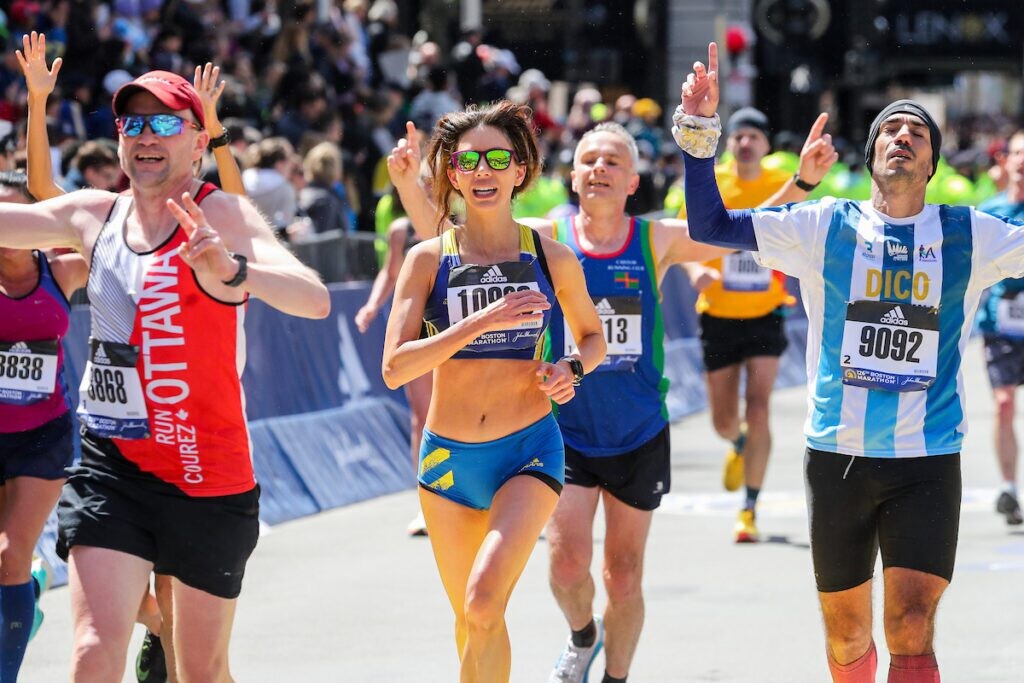
For those who have hit a qualifying time for 2025, mark your calendars and set a reminder. Registration will open on Monday, Sept. 9, 2024 at 10:00 a.m. ET, and will close on Friday, Sept. 13, 2024 at 5:00 p.m. ET. The 2025 Boston Marathon qualifying window opened on Sept. 1, 2023, and will close at 5:00 p.m. ET on Friday, Sept. 13, 2024. Any athlete who has achieved a qualifying time in this window may submit a registration application.
The qualifying window for the 130th Boston Marathon, scheduled for April 20, 2026, will open on Sept. 1, 2024. Registration details for the 2026 race will be announced following the 2025 Boston Marathon.
(06/12/2024) ⚡AMPby Marley Dickinson
Boston Marathon
Among the nation’s oldest athletic clubs, the B.A.A. was established in 1887, and, in 1896, more than half of the U.S. Olympic Team at the first modern games was composed of B.A.A. club members. The Olympic Games provided the inspiration for the first Boston Marathon, which culminated the B.A.A. Games on April 19, 1897. John J. McDermott emerged from a...
more...Lawrence Cherono: 2019 Chicago Marathon winner hit with new tampering charges by AIU
Two years ago, Cherono was suspended for doping and now he faces new AIU charges for allegedly tampering with the process.
Kenya's marathoner Lawrence Cherono has once again come under scrutiny by the Athletics Integrity Unit (AIU) this time for alleged tampering related to his doping case.
The revered long-distance runner, known for his triumphs in major marathons including the 2019 Chicago Marathon, is facing new challenges that could further tarnish his illustrious career.
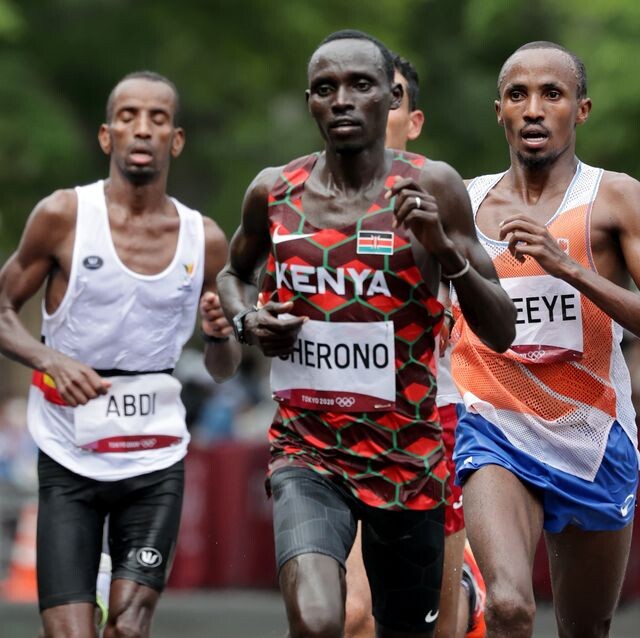
In July 2022, Cherono was provisionally suspended after testing positive for trimetazidine, a substance primarily used to treat angina and other heart-related conditions.
This medication is known to optimize the heart's use of oxygen, potentially giving athletes an unfair advantage by enhancing their endurance levels.
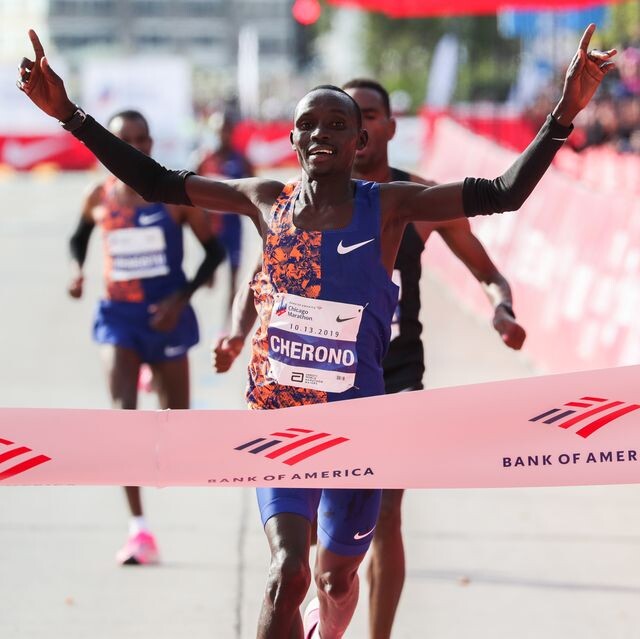
The initial findings placed Cherono in a precarious position, casting a shadow over his achievements, including his impressive fourth-place finish at the Tokyo Olympics and his victories in both the Boston and Chicago Marathons.
The latest charges brought forward by the AIU involve accusations of tampering with the doping control process.
The specifics of the tampering allegations have not been fully disclosed, but such charges typically involve attempts to obstruct or interfere with doping investigations.
Examples could range from manipulating test samples, intimidating witnesses, or providing false information to authorities.
This development adds a complex layer to Cherono's ongoing legal battles with the AIU.
If found guilty of tampering, he could face severe repercussions, including extended bans from competitive racing.
This would be a significant blow to his career, potentially ending his days as a top contender in world marathon events.
Cherono's legal team has yet to release a detailed response to these new allegations.
However, in previous statements, they have expressed their intent to fully cooperate with the AIU while maintaining Cherono's innocence in the matter of the initial doping charges.
The sports world has been closely watching Cherono's case, as it underscores the ongoing challenges within athletics regarding doping and the integrity of sportsmanship.
His case is particularly significant given his status as one of Kenya's most celebrated marathoners, whose record time of 2:03:04 at the 2020 Valencia Marathon highlighted his elite capabilities.
(06/12/2024) ⚡AMPby Festus Chuma
Sydney McLaughlin-Levrone on her U.S. Olympic Trials prep ahead of Paris 2024
With the U.S. Olympic Team Trials for track and field just few days away, the building blocks seem to be coming together for Sydney McLaughlin-Levrone.
"I'm feeling good," McLaughlin-Levrone told a small cluster of reporters at the USATF NYC Grand Prix on Sunday (9 June) after she soared to victory in the open 400m.
"Good" could be an understatement: She was just 0.05 seconds off of Sanya Richards Ross' 48.70 from 2006, the American record, in what was McLaughlin-Levrone's first outing in the event in the 2024 season.
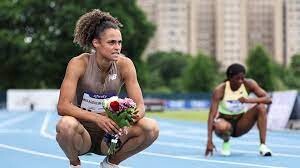
"OMG. That was unbelievable!" a more expressive - and perhaps somehwat relieved - Richards Ross said in the NBC commentary booth after Sydney's 48.75. "Wow. Wow. Wow! Great run by Sydney!"
The time was a world lead in the event.
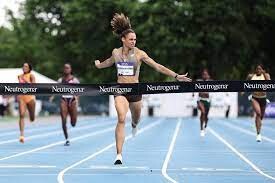
It came a little more than a week after her best-of-the-season 52.70 in the 400m hurdles - the event in which she is the world record holder and reigning Olympic champion.
"I'll take that," McLaughlin-Levrone said of the time and the victory, even if it wasn't exactly what she was going for. "[I wanted] the American record," she added when asked about the hope for the day.
The 24-year-old appears to have a one-track mind with the Olympic Games Paris 2024 drawing ever closer. The last five weeks have entailed five wins across four different events: The 400m flat, 200m, 100m hurdles and - her signature - 400m hurdles.
"I'm sure Bobby will have some notes for me," she said, cracking a smile when bringing up legendary coach Bobby Kersee after her New York win.
SYDNEY MCLAUGHLIN-LEVRONE: EYES ON PARIS 2024
McLaughlin-Levrone let her speed do the talking in New York with the 21 June start at Trials in Eugene, Oregon: "I'm just getting ready for the Trials... getting ready for the Games," she said.
She sat on the track for a good 10 minutes at Icahn Stadium in NYC after her win, catching her breath and doing a light amount of stretching. She's still cautious of the knee injury that interrupted her 2023 season, forcing her out of the World Championships.
The team is attacking from a technical perspective. Facing a headwind on Sunday, she was forced to dig deep in her training to finish strong.
"I wanted to get out there and get a race under me," she said on NBC of the 400m. "It's working on the back-end work. Working on coming home. I'm going to need it for those hurdles."
After her 52.70 world lead in the 400m hurldes on 31 May, Femke Bol, the Olympic bronze medallist from Tokyo 2020 in 2021, went 53.07 two days later at the Diamond League stop in Stockholm.
"I'm going to go back home and continue to plan some stuff," McLaughlin-Levrone said in New York.
A mere 0.05 off a national record, McLaughlin-Levrone shrugged it off in a way.
"I don't think I would count that as 'crazy,'" she said in response to one reporter.
A minute later, Sydney was thanking reporters and walking away... clearly determined to get to the next step in her path towards another Olympic podium.
(06/12/2024) ⚡AMPby Nick McCarvel
U.S. Olympic Team Trials Track And Field
Eugene, Oregon has been awarded the 2024 U.S. Olympic Team Trials - Track & Field, USA Track & Field and the U.S. Olympic & Paralympic Committee announced today. From June 21 to 30, Hayward Field at the University of Oregon will be home to one of the biggest track and field competitions in the country, as the U.S. Olympic Team...
more...Hardrock 100 extends pregnancy deferral for up to five years
While some runners complained the policy is long overdue, most greeted the news with cheers.
The ultra-trail world is applauding Hardrock 100’s progressive, new pregnancy/parental deferral policy, which the race announced on Instagram on Monday. The new policy encompasses both pregnancy and situations involving adoption and surrogacy.
The new policy allows any woman who has been selected to race (or who gets in off the waitlist) who was pregnant on lottery day (Dec. 2, 2023, for the 2024 race), or who becomes pregnant between lottery day and race day (July 12), or who has given birth anytime during the six-month period leading up to lottery day, to defer their entry for five years. It may also be claimed by the partner of women who give birth during the six months leading to race day, or up to two months after race day.

Further, the policy allows surrogate parents whose due date falls within the six-month period leading up to race day to claim a one-year deferral. This policy also applies to parents who adopt a child during the same six-month period (provided the child is under five years old).
“At Hardrock, we firmly believe that runners of all types shouldn’t have to choose between chasing their dreams on the trails and pursuing the option of becoming parents,” the race posted on Instagram. “That is why we have updated our Pregnancy Entry Deferral policy to provide a more generous deferral period for pregnant women and new mothers, and expanded coverage to include other types of new parents, such as in situations of surrogacy and adoption.”
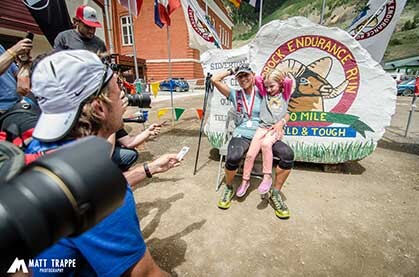
News of the new policy was greeted with mostly positive comments, though some decried the length of time it has taken for the race to finally acknowledge the realities of life for parents and those who are trying to have children. Canadian ultrarunner Stephanie Case (@theultrarunnergirl), who finished second in 2022, is a Hardrock board member and spoke to Canadian Running about her own fertility journey in a feature in the 2024 Trail Special Issue, commented “Proud to be on this board!”
The policy is somewhat less generous than that of the Western States Endurance Run (as an example of a comparable race), in that the eligibility period begins when a runner enters the lottery, and deferral may be for an indefinite period; however WSER’s policy applies only to pregnant women. The policy at Ultra-Trail du Mont Blanc (UTMB), like Hardrock’s, applies to surrogate and adoptive parents and partners of pregnant women, for up to five years (with certain restrictions).
(06/12/2024) ⚡AMPby Anne Francis
Hardrock 100
100-mile run with 33,050 feet of climb and 33,050 feet of descent for a total elevation change of 66,100 feet with an average elevation of 11,186 feet - low point 7,680 feet (Ouray) and high point 14,048 feet (Handies Peak). The run starts and ends in Silverton, Colorado and travels through the towns of Telluride, Ouray, and the ghost town...
more...Good times at the monthly KATA Time Trial this morning in Thika Kenya
The KATA (Kenyan Athletics Training Academy) June time trial was the best ever held today in Thika Kenya. The turn out was good. A total of 52 athletes registered for the two events.
Athanas kiroko took the victory in the men 10km race in a time of 28:58. Zachary kirika was the man of the day. He finished in 2nd place in a personal best time of 29:12 lowering his previous time by 27 seconds. Fredrick kiprotich finished in third place in a time of 31:11.

Kellen waithira took the crown in the women's 10km race in a time of 34:58. She was followed impressively by Jane wanja who finished in 2nd place in 35:45 lowering her personal best by over one minute. Karen chepkemoi placed third in 36:33 lowering her personal best by 14 seconds.
Job kamande finished first in men 5km race in 14:36. This was his first time in this distance. Charles ndirangu finished second in 15:24 lowering his personal best by 16 seconds. Amos chirchir finished third place in 15:49, lowering his previous time by 3 seconds. The improvement in women's 5km race was indeed astonishing. Lois wambui who finished in third place in 17:10 improved by 33 seconds. Jacinta kamau finished 4th in 17:14 improved by 35 seconds and Virginia wanjiru who finished in 5th position in 17:47 improved by 12 seconds.
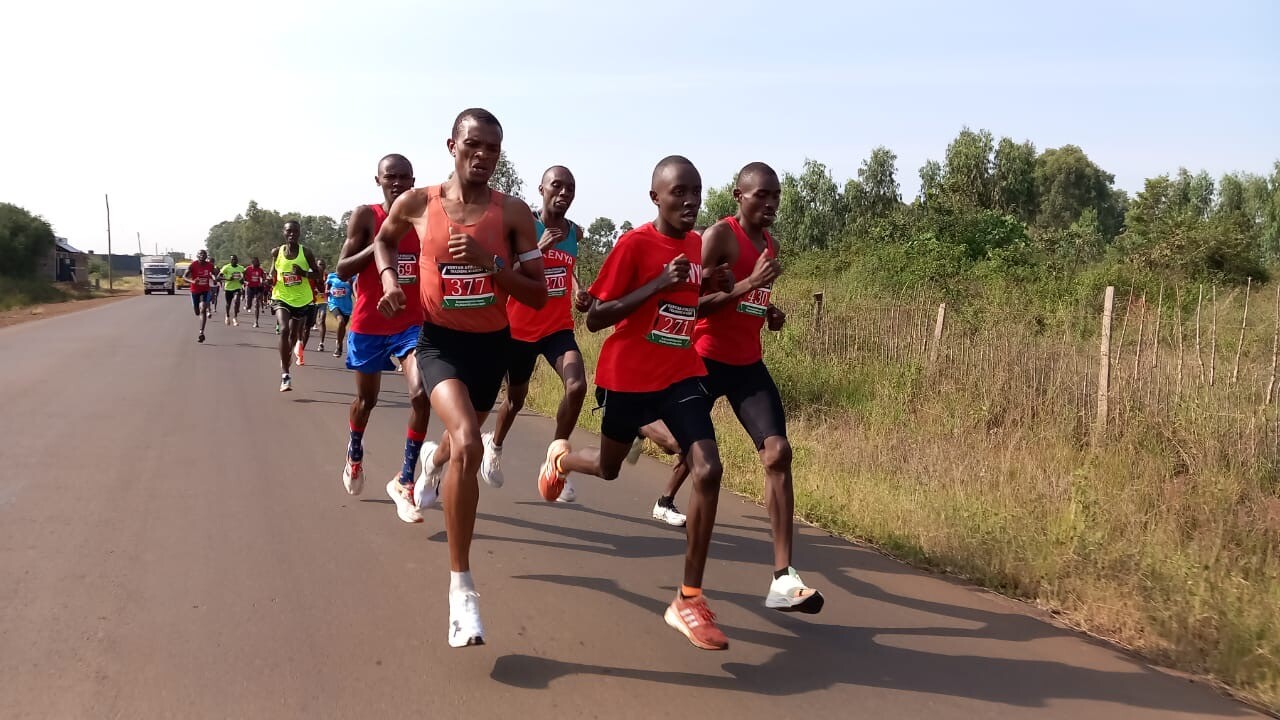
The next KATA time trial is July 17.
5k MEN
1 job kamande 24 430 14:36
2 Charles ndirangu 23 267 15:24
3 Amos chirchir 23 272 15:49
4 Raphael karita 24 392 15:52
5 Kelvin ragui 21 271 16:16
6 John makeri 27 227 16:26
7 Emmanuel rono 24 318 16:41
8 Collins maina 20 284 16:43
9 Brian njenga 20 390 16:44
10 Geoffrey ngama 50 384 17:26
11 Jeremiah obura 20 323 18:37
12 Anthony owino 28 382 19:10
13 Alex kamau 22 333 19:49
14 mavirine rotich 27 312 22:05
15 Kennedy mungai 25 375 22:10
5km WOMEN
1 Monica wanjiku 22 265 16:28
2 Nympha kiteta 18 266 16:58
3 Lois wambui 23 277 17:10
4 Jacinta kamau 22 276 17:14
5 Virginia wanjiru 22 275 17:47
6 Anastasia muthoni 21 283 19:12
7 Susan njuu 36 380 20:50
8 Sheila makungu 21 385 21:26
9 Ann kipchumba 33 331 22:14
10 Emily wanjiru 17 278 23:43
11 pory ngatha 35 374 29:44
10km MEN
1 Athanas kioko 29 377 28:58
2 Zachary kirika 22 269 29:12
3 Fredrick kiprotich 23 264 31:11
4 Stephen ngigi 20 280 31:27
5 Henry Komen 33 2:81 31:32
6 Shadrack kiprotich 33 332 31:52
7 Paul kibet 26 287 31:54
8 lewis kuria 22 459 32:13
9 Gabriel kahura 41 270 32:23
10 Fred kamande 24 286 32:55
11 Ismael mburu 23 391 33:00
12 Chris kamande 39 314 33:09
13 Ramadan ambani 24 279 34:20
14 Charles ndirangu 64 389 37:51
15 Paul Njoroge 28 383 38:05
16 Kelvin waiganjo 28 387 39:39
10km WOMEN
1 Kellen waithira 36 381 34:59
2 Jane wanja 34 273 35:45
3 Karen chepkemoi 22 274 36:33
4 Naomi wambui 39 388 36:51
5 Florence kiarie 33 379 37:07
6 Caroline kimoi 32 65 38:38
7 Lilian musenya 22 285 39:44
8 Lucy muritu 39 282 45:05
9 Ruth maina 21 386 46:14
(06/12/2024) ⚡AMPKATA Time Trial Series
Welcome to the KATA Monthly Time Trial Held at the Kenyan Athletics Training Academy in Thika, Kenya, the KATA Monthly Time Trial is a unique and inclusive event designed to support runners of all levels in achieving their goals and showcasing their fitness. This event offers both 10K and 5K distances on an accurate, certified course, providing participants with...
more...Eugene mile clash intensifies Kerr-Ingebrigtsen rivalry ahead of Paris
With a lap and a half to go in the Bowerman Mile at last month’s Prefontaine Classic, Josh Kerr made what he described as a “dumb decision” – on purpose.
The world 1500m champion raced to the front at the Wanda Diamond League meeting, ahead of Jakob Ingebrigtsen and Yared Nuguse, the third- and fourth-fastest milers of all time, a move whose intention was daring them to chase him down. When neither could, Kerr burst through the line with a world-leading British record of 3:45.34 and bragging rights – for now.
Having said at the pre-event press conference that he was racing to win, not settle tension between himself and Ingebrigtsen after months of banter between the overnight rivals, Kerr settled who was best over one mile at least on this day at Hayward Field. As to who will be the best in the long run, that remains to be seen – because each runner left declaring confidence for their presumed rematch at the Paris Olympics.

“I was just excited to go out and race against a world-class field and show that I’m still the best 1500m runner in the world,” Kerr said. “The training I’ve done is not anywhere near my peak. 3:45 right now is good enough but we’ve got to make some progress moving from here.”
“It’s a good fight,” Ingebrigtsen said. “Some of my competitors have clearly taken a step in the right direction but not a big step – not as big of a step that maybe is needed to be the favourite in Paris. But I think if anything, this is going to be an exciting summer. For me, I think it’s very good.”
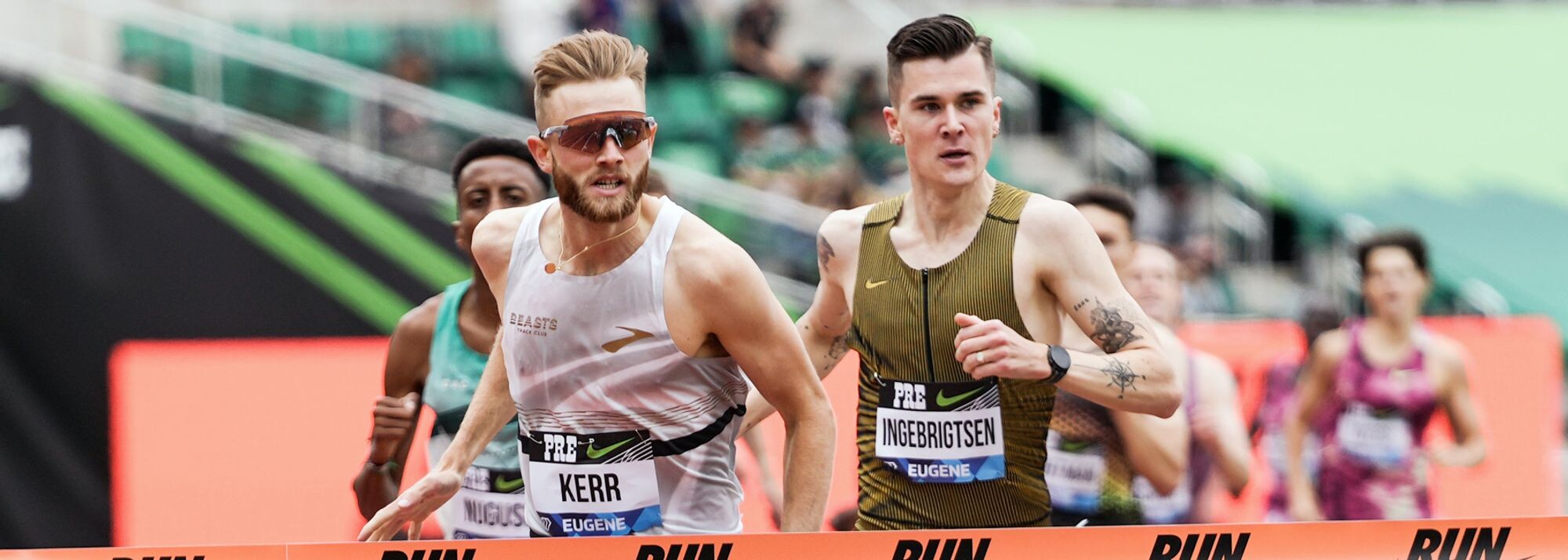
Kerr entered the race with full health and full confidence. After outkicking Ingebrigtsen, the Olympic champion, to win the world title in Budapest last year, Kerr set a world indoor best over two miles in February, then won the world indoor 3000m title in March in front of fans from his native Scotland.
Ingebrigtsen ended last season by winning the Prefontaine Classic mile in 3:43.73, just ahead of Nuguse, but then battled an achilles tendon injury during the winter. That did not necessarily mean he kept a low profile. Comments in the press by Ingebrigtsen began a back-and-forth.
When asked about his relationship with Ingebrigtsen at the press conference ahead of their recent clash in Eugene, Kerr responded: “I wouldn’t say this is a counselling session.”
No, but the race did prove to be a strategy session. The athletes at the front felt that the time through 800m, 1:53, was not too fast. With 600 metres to go, Kerr made his move.
“I thought it was a dumb decision and I knew if I thought it was a dumb decision then it probably was and that was going to scare myself and everyone else around me,” said Kerr, whose previous personal best of 3:48.87 was set two years ago.
Did such an early move surprise Ingebrigtsen?
“A little bit,” he said. “Because historically people have a tendency to not do what they say they’re going to do so they can feel very confident when they have to hold their mask but when we start racing everybody’s very insecure so I think it says a lot about their preparations. I think it was as expected but maybe still surprised that someone is deciding to all of a sudden start racing so I think that’s very good.”
Considering his delayed start to training, Ingebrigtsen was pleased with the time.
"If you do the conversion [to 1500m] it’s a pretty good start," he said. "I’m not a fan of the mile event by itself because it has nothing to do with my culture, definitely something British and American, which I’m not that familiar with, but I think it’s a very good start. I have lost quite a lot of training this winter."
While commentating inside the stadium for the BBC, Steve Cram watched as Kerr broke his 1985 British record of 3:46.32, then had a word with Kerr following the race.
“He said it was a long time coming and he was very proud of me and the way I raced today,” Kerr said.
Jake Wightman, the 2022 world champion at 1500m who missed nearly all of last season due to injury, was fifth in 3:47.87, just behind another British middle-distance specialist, Neil Gourley. Those fast times and gold medals since 2022 were the background to why Kerr said the sport is “heading into the golden era of 1500m running in the UK and in Europe”.
Ingebrigtsen, the day before, had said that being available to race often against top competition was something he considered part of an athlete’s job. Asked if he needed to reassess how to race Kerr tactically given Kerr’s bold and somewhat surprising early move to the front, Ingebrigtsen pointed to his literal track record.
“The last couple of years obviously I have been the only one racing for many of the races so when someone all of a sudden decides to participate other than just following, it’s something different,” Ingebrigtsen said. “So it’s not surprising but it’s just something different.”
Asked if he was suggesting Kerr – who claimed his first Diamond League victory Saturday – had not raced often enough, Ingebrigtsen asked a reporter about the September 2023 meeting in Eugene, when Nuguse was in the field, but not Kerr.
“What about the last time we were here?” Ingebrigtsen said.
Nuguse was third in Eugene in 3:46.22, and while that was behind his 3:43.97 personal best from September, that race occurred at the season’s very end. To run 3:46 in May, at the start of a long season, left Nuguse smiling afterwards, even as he noted he needs to train to be more capable of closing quicker in the final 100m.
“I definitely feel a lot stronger and more comfortable being closer to the front,” Nuguse said. “In a race with so many great guys I think just to come out with third and still be pulling away from it is really huge. I’m feeling really good compared to last year.”
(06/11/2024) ⚡AMPby Andrew Greif for World Athletics
Paris 2024 Olympic Games
For this historic event, the City of Light is thinking big! Visitors will be able to watch events at top sporting venues in Paris and the Paris region, as well as at emblematic monuments in the capital visited by several millions of tourists each year. The promise of exceptional moments to experience in an exceptional setting! A great way to...
more...U.S. sprinter Fred Kerley calls out track meet for bad starting blocks
This was supposed to be Kerley's first 100m since he stated he'd break Usain Bolt's world record the next time he raced the distance.
Former world 100m champion Fred Kerley was slated to be a headliner at Sunday’s USATF New York City Grand Prix in the men’s 100m. However, Kerley did not end up racing after he slipped in the starting blocks twice. Despite these mishaps, he chose not to race.
In a post-race interview with Citius Mag, Kerley said that one of his starting block pads was broken, and he had requested new blocks. “I slipped the first time, and then I slipped the second time. I wasn’t about to let it happen a third time,” Kerley said.

He took to Twitter after the race to criticize the World Athletics Continental Tour meet for using “high school level blocks.”
The 100m at the NYC Grand Prix ended up being won by Nigeria’s Udodi Onwuzurike, with a 10.24 second clocking into a -0.7 m/s headwind.

This race was supposed to be Kerley’s first 100m since he publicly stated he’d break Usain Bolt’s world record the next time he raced the distance. Kerley has not competed in the 100m since the Shanghai Diamond League on April 27 and has not yet broken the 10-second mark this season.
Kerley has a personal best of 9.76 seconds from the 2022 World Championships, which he won. He is also the reigning Olympic silver medalist in the 100 meters.
Before the race, Kerley drew attention in the warm-up area at Icahn Stadium, where he was spotted wearing Puma spikes (instead of his sponsor, Asics). It came out after the race that Kerley is now without a sponsor, as Asics announced that they had mutually parted ways with him after reaching a multi-year deal just last year. There has been no official statement on why the sponsorship ended, but Kerley was rumored to be frustrated with the custom “world champion” spikes the brand made for him.
The 29-year-old plans to compete in the 100m and 200m at the U.S. Olympic Trials in two weeks.
(06/11/2024) ⚡AMPby Marley Dickinson
MAHWINNEY AND DAVIES LEAD ELITES AT UNDER ARMOUR TORONTO 10K
Erin Mawhinney will defend her Under Armour Toronto 10K title Saturday June 15th the next stop on the 2024 Canada Running Series.
A year ago, the Hamilton resident won the race, which traces Toronto’s scenic Lake Shore Boulevard, in a personal best of 33 minutes 34 seconds. The result was a pleasant surprise and confirmed her arrival as one of Canada’s elite road racers.
“I would like to take a stab at defending my title I know there are some fast girls running,” the 27 year old says before adding, ”Truthfully I have struggled with some low iron the past couple of weeks. But being able to defend the win would be great. Running close to 33 minutes flat would also be great at this time.
Despite the medical hiccup - which is now behind her - Mawhinney has followed coach Reid Coolsaet’s training program closely and has gradually increased her training volume. Indeed, she has had weeks where she has run as much as 160km while working full-time as a nursing consultant.
Mawhinney completed her Master of Nursing degree last year after spending six years nursing in the intensive care unit at Hamilton’s St Joseph’s Hospital. Combining long, demanding shifts with her training program was challenging but she credits Coolsaet, a two-time Canadian Olympian, with providing a flexible plan.
“I did straight night shifts and I found that sticking on straight nights was a little bit easier for running,” she remembers. “I found the flipping back and forth between days and night was sort of chaotic.
“I would let Reid know and he was great with being flexible. I worked a lot of overtime during Covid because we were overwhelmed in the ICU during that time. There would be some days where I was too tired to double. There were even times when I had to sleep at the hospital between shifts because there was a risk of exposure in my apartment building.”
In addition to winning the 2023 Under Armour Toronto 10KMawhinney captured first place in the 2023 TCS Toronto Waterfront Half Marathon last October (1:13:50). Now she and Coolsaet are targeting a possible marathon debut this coming fall.
“We are thinking TCS Toronto Waterfront in the fall will be my marathon debut so that is the main focus for the rest of the year,” she reveals.
Recently Mawhinney’s concerns for the homeless crisis in the Hamilton neighbourhood she has called home the past seven years resulted in her penning an essay on her observations. Her advocacy is paying off.
“A big win recently was having City Housing Hamilton approve a new public health nurse role I proposed to them,” she adds. “(It is) to help those in higher social-need subsidized housing keep their tenancy and avoid needing to use the emergency room.”
Among those lining up against her Saturday are 2015 Pan Am Games marathon bronze medalist, Rachel Hannah, who was 3rd in the 2024 Ottawa Marathon last month and, most significantly, was 3rd in the Under Armour Toronto 10K last year and last year’s runner-up, Salome Nyirarukundo the 26 year-old Rwandan who has made Ottawa her home.
The men’s field is led by Andrew Davies, a second-year law student at the University of British Columbia. Although his 10k best is 29:32 last month he ran a superb 10,000m on the track recording 28:34.63.
“If you get one of the really fast road courses I definitely feel you can be just as fast, maybe even faster, on the roads (than on the track) with the new shoes,” he declares.
The 23-year-old Davies claims, however, he will focus more on the competition than on recording a fast time.
“I am not really going to focus on the time too much,” Davies, who hails from Sarnia, Ontario, says. “I have been transitioning now to focus on the 5,000m leading to the track Nationals at the end of the month. I will focus on racing whoever else is (at the Toronto 10k). I am not going in with a time goal.
“My 5,000m PB (13:37.39) is three years old and I would like to lower that into the (low) 13:30’s and run Nationals and then in the fall I’d like to run as well as I can in the Canadian cross countrychampionships. I was 4th there this past year. If I could medal there that would be awesome."
The fastest performer in the men’s field is Lee Wesselius whose personal best 29:13 earned him 7th in the 2021 Canadian 10k Championships held on a slightly modified Toronto Waterfront course. Also racing is Rob Kanko who was 3rd in the 2023 Under Armour Toronto 10K in a personal best of 30:02.
The race will once again serve as the Canadian Masters 10k championships. Baghdad Rachem will defend the title he won a year ago on this same course. The Verdun, Quebec resident won that day in 32:05 beating 44-year-old Reid Coolsaet by 13 seconds.
Edmonton’s Jay Smith finished 3rd in 2023 in 39:23 and leads the female master’s division entries.
(06/11/2024) ⚡AMPby Paul Gains
Asafa Powell opens up on the darkest moments of his career and how he managed to overcome them
The Jamaican sprint great has opened up on two dark moments in his career and how he managed to overcome those setbacks.
Jamaican sprint great Asafa Powell has opened up on how he dealt with the lowest moments of his career as an athlete.
Powell, a specialist in the 100 meters, set the world record twice with times of 9.77 and 9.74 seconds and has broken the 10-second barrier more than anyone else, doing so 97 times.
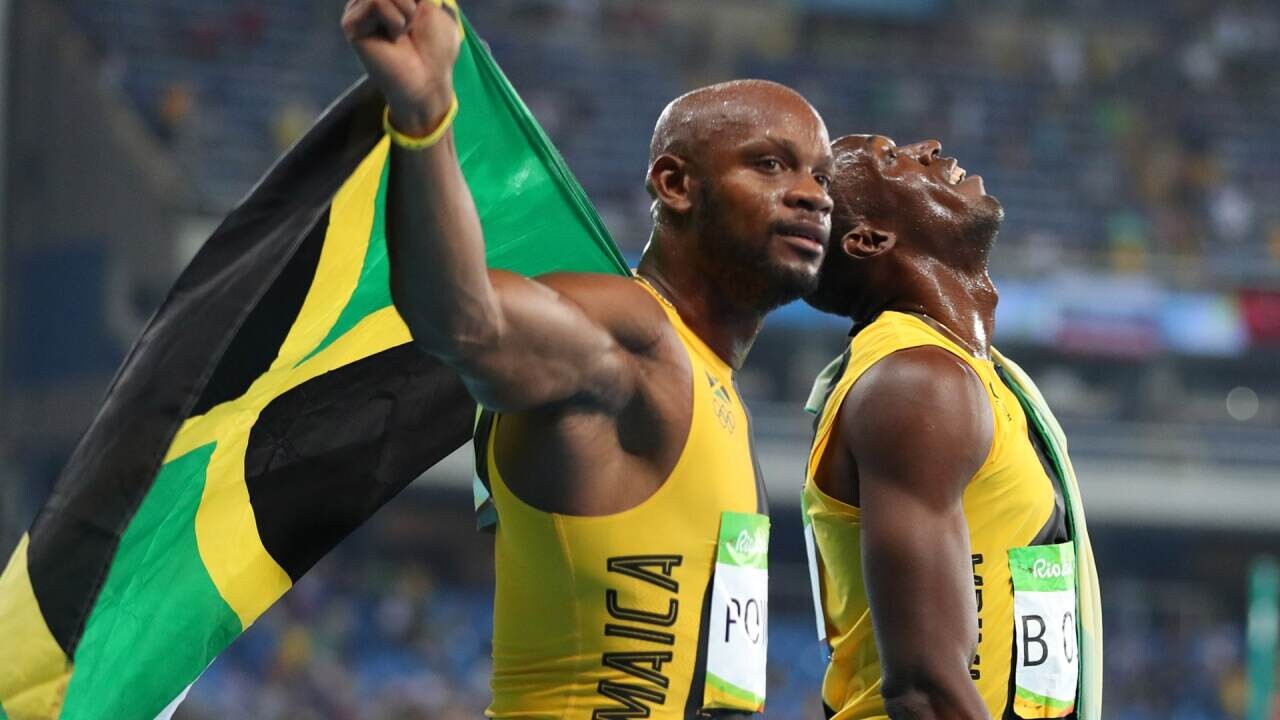
He also holds the world record for the 100-yard dash at 9.09 seconds and became an Olympic champion in the 4 x 100 meters relay in 2016.
Powell has consistently broken the 10-second barrier in competition, with his personal best of 9.72 s ranking fourth on the all-time list of men's 100-metre athletes.

By 2016, Powell had broken the ten-second barrier more times than anyone else—97 times.
However, he never managed to win a major individual title, with his two bronze medals in 2007 and 2009 his best finishes. He did however manage to win two gold medals at the World Championships and another at the 2016 Olympic games, but all were in the 4 by 100 m relays.
Now, he has opened up on the two darkest times of his career, which he has revealed were the World championships in 2007 in Osaka and the Olympic games in Beijing.
“I have had a few of those and they felt pretty much the same. I remember at the 2007 World Championships, there was no way I was supposed to lose the race, but things happened before and all that stuff and it caused me to lose the race,” Powell told The Mitchells YouTube channel.
“I tell myself some stuff and I have to really and then in 2008 at the Olympic games, I did not run like I was supposed to and I was really tough on myself. Those were my darkest moments.”
Powell has thanked his family for helping him get through those tough moments in his career.
“I had to pull myself out of the dark. They had to fly my father and brother to the games because I was in a (devastated) state.”
Powell has sent a message of encouragement to his fans, advising them to always do their best and not worry too much about situations that may be beyond their abilities to change.
“You cannot control what other people are doing. On the track, eight or nine people are on the track so you cannot control what they are doing. You have to focus on what you are doing.
“If everybody else breaks a world record and you also do one as well, you cannot be upset because you did your best at that time.”
(06/11/2024) ⚡AMPby Mark Kinyanjui
Youngster Simon Koech is plotting an Olympic debut
Steeplechaser Simon Koech is plotting an Olympic debut as he fights for a slot at the upcoming national trials.
African Games bronze medallist Simon Koech will be looking to bounce back as he eyes the Paris 2024 Olympic Games.
Koech’s main focus will be to qualify for the event at the Olympic trials coming up this weekend at the Nyayo National Stadium. The 21-year-old has been in fair shape this season, and he has hopes to rewrite history in the city of love.
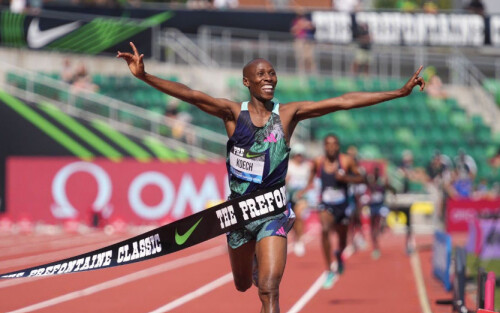
The former world under-20 bronze medallist is aware of the tough opposition awaiting him in the trials and he is ready to striker.
“For now, the most important thing for me is to work extra hard and get into the Kenyan team,” Koech said following his second-place finish at the National Championships that were held at the Ulinzi Sports Complex.
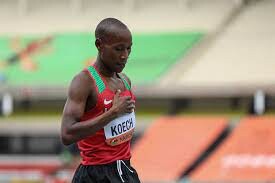
The event was also used as trials for the Africa Senior Athletics Championships in Douala, Cameroon, and Koech intends to also improve on his bronze medal from the African Games.
He opened his season with a second-place finish at the African Games trials before finishing third at the African Games. He also competed in the 5000m, where he finished eighth.
“Whenever I step foot on the track, I usually start planning on the best way to execute a race. It depends on the pace and hoe each lap is going. I expect to do much better with the help of God,” he added.
Meanwhile, Koech made an impact last season, with a qualification to the World Championships in Budapest, Hungary but did not live up to the billing, fading to finish seventh.
However, he bounced back at the Prefontaine Classic, the Diamond League Meeting final in Eugene, Oregon, where he claimed his first trophy. Koech clocked a stunning 8:06.26 to win the race, sending warning shots to Ethiopians and Moroccans this Olympic season.
The youngster launched his career in 2021, where he made his first national team, competing at the World Under-20 Championships. In 2022, Koech did not compete in any race and he made a comeback in 2023.
(06/11/2024) ⚡AMPby Abigael Wuafula
Paris 2024 Olympic Games
For this historic event, the City of Light is thinking big! Visitors will be able to watch events at top sporting venues in Paris and the Paris region, as well as at emblematic monuments in the capital visited by several millions of tourists each year. The promise of exceptional moments to experience in an exceptional setting! A great way to...
more...US High School 5000m Record smashed
Daniel Simmons smashes Lex Young’s U.S. high school 5000m record of 13:34.96 from last year as he runs 13:25.86 against a field of pros at the Portland Track Festival tonight.
(06/10/2024) ⚡AMPHere’s a sweat rate calculator to help you master your hydration game
Have you ever wondered exactly how much fluid you’re losing from sweat when you run? You’ve probably noticed you sweat at a different rate than your running buddies, but it can be tough to know how to hydrate to your specific needs. Enter the Sweat Loss Prediction Calculator, a new tool designed by researchers in Australia that aims to help athletes calculate their expected whole-body sweat rate.
Developed through extensive research conducted across two sites in Australia, this calculator is based on data from 182 outdoor running trials and 158 outdoor cycling trials. The aim was to test sweat rate prediction equations to help athletes during moderate to high-intensity outdoor activities, using monitored activities and environmental conditions.

How it works
The sweat loss calculator uses a prediction model developed from data gathered throughout the exercise trials. Participants’ whole-body sweat rates were measured over 60-minute sessions, with environmental conditions like temperature, wind speed and humidity recorded. These conditions were also rated subjectively by the participants.

Interestingly, the models worked well even when subjective environmental assessments were used instead of precise measurements. For runners, substituting subjective data slightly decreased the model’s accuracy (by less than 25 per cent), while for cyclists, the decrease was minimal, at around two per cent.
Practical benefits for athletes
With this calculator, available here, runners and cyclists can tailor their hydration strategies to their specific needs. The models offer 95 per cent confidence intervals that are within acceptable limits for maintaining body mass over a three-hour period, which is crucial for endurance athletes. By punching in simple activity details and your expected environmental conditions, you’ll receive personalized hydration advice, helping you stay hydrated and perform at your best, no matter the weather conditions.
(06/10/2024) ⚡AMPby Keeley Milne
Chesebe ready to defy odds to make Team Kenya to the Olympics
2011 All-African Games women's 800m bronze medalist, Sylvia Chesebe has warned her competitors not to underestimate her ahead of the Olympic trials.
Eleven athletes will vie for a spot in the women's 800 team at the Nyayo National Stadium this weekend. So far, only four have the Olympic qualification mark of 1:59.30.
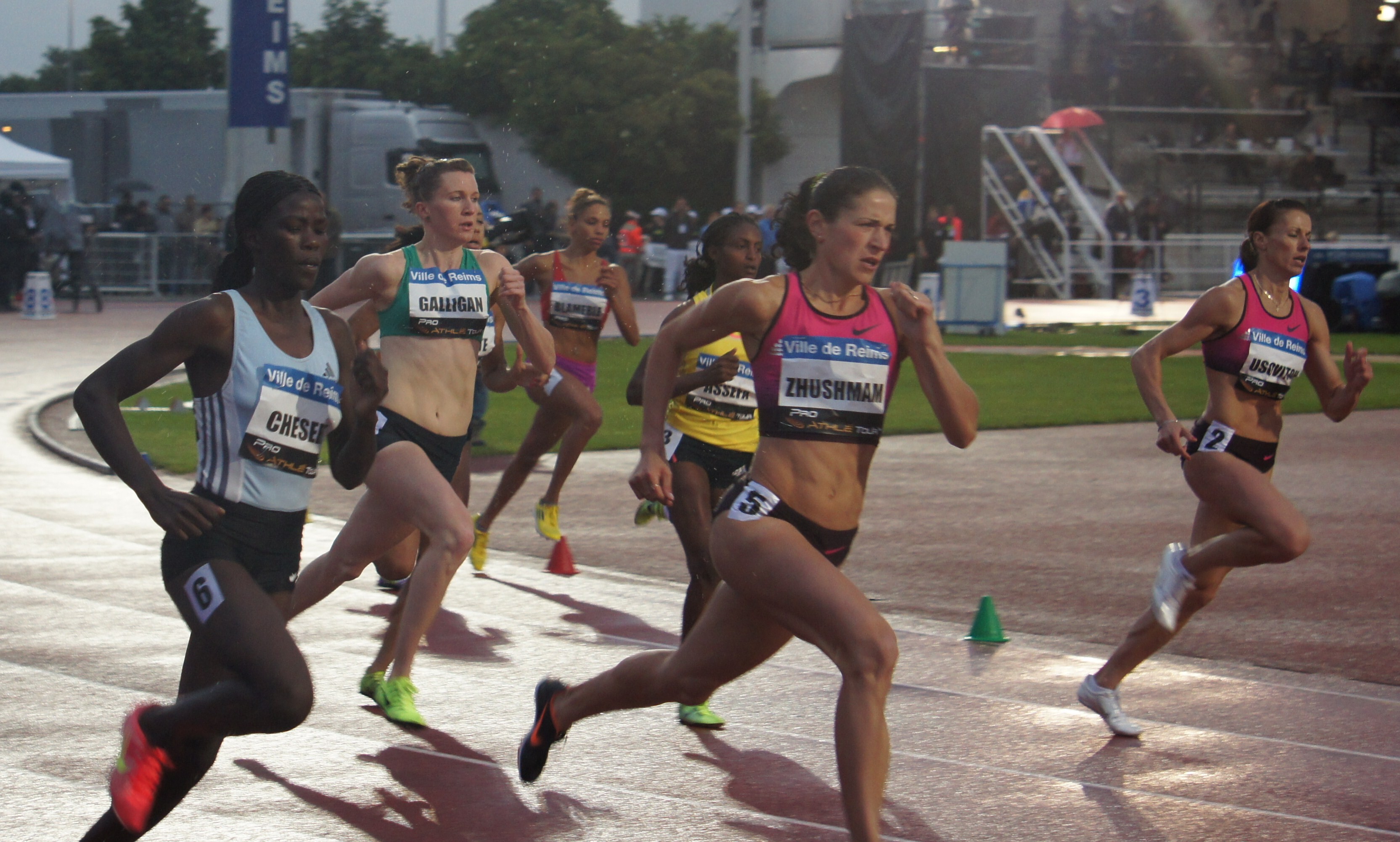
Chesebe is yet to qualify as her fastest time this year is 2:03.92— set at last month's National Championships.
Motivated to make her Olympic debut, Chesebe exuded confidence in posting the qualification time at Nyayo Stadium.
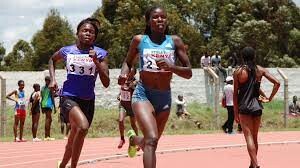
“I am confident I will attain the Olympic qualification time and make Team Kenya. Competition will no doubt be tough but winning depends on preparations and I am well prepared,” Chesebe stated.
Chesebe, however, acknowledged her competitors but also warned them not to overlook her.
“I am not underrating anybody and they should not underestimate me either. I am here to push everyone to the limit,” she added.
Headlining the list is world champion Mary Moraa, who already has the qualification mark of 1:56.03 posted in Budapest, Hungary, last year.
Vivian Kiprotich is the other athlete to watch having qualified after clocking 1:58.26 during the Kip Keino Classic, where she placed second behind Moraa (1:57.96).
21-year-old Nelly Chepchirchir clocked 1:58.98 for fourth place at the same event while Naomi Korir clocked 1:59.19 during the Grifone meeting in Italy last month.
Others on the list include national champion Lilian Odira, Dorcas Ewoi, Sarah Moraa, Mweni Kalimi, Winnie Kipsang and Naumglorious Chepchumba.
Chesebe emphasised that making the Olympics team would be a dream come true and will be hoping to end Kenya’s 16-year wait for gold in the two-lap race.
"The Olympics are a dream for every athlete. It is the biggest stage to display your talent. It would mean a lot for me to make my first appearance and also win gold for Kenya,” she stated.
Kenya’s only gold medal in the women’s 800m came at the 2008 Beijing Olympics through Pamela Jelimo, who clocked 1:54.87 to clinch the title. She led leading compatriot Janeth Jepkosgei (1:56.07) and Morocco’s Hasna Benhassi (1:56.73) to the podium.
Jelimo won bronze at the 2012 London Olympics in 1:57.59) while Margaret Wambui (1:56.89) posted the same at the Rio Olympics.
Coached by her husband, Michael Cheren, Chesebe is focusing on fine-tuning her speed to ensure she is in prime condition for the trials.
“I am working on my speed. I already have the endurance, but I need to improve my speed, especially my finishing, to ensure I make the Olympic time at the trials,” she stated.
On Friday, Chesebe took part in the World Masters Athletics Trials at the Ulinzi Sports Complex, winning the 400m W35 category in 54.24 secs.
She hopes that competing in the 400m race will help her in improving her finishing.
“I took part in the 400m at the World Masters trials to work on my finishing. I hope it will pay off come the trials,” she stated.
During the 2011 All-Africa Games in Maputo, Mozambique, Chesebe clocked 2:04.16 behind Ethiopia's Fantu Magiso (2:03.22) and Uganda's Annet Negesa (2:01.81).
The 37-year-old is also a silver medallist at the 2014 World Relay Championships in Nassau, Bahamas, in the 4x800m clocking 8:04.28 together with Agatha Jeruto, Janeth Jepkosgei and Eunice Jepkoech.
(06/10/2024) ⚡AMPby Teddy Mulei
Paris 2024 Olympic Games
For this historic event, the City of Light is thinking big! Visitors will be able to watch events at top sporting venues in Paris and the Paris region, as well as at emblematic monuments in the capital visited by several millions of tourists each year. The promise of exceptional moments to experience in an exceptional setting! A great way to...
more...Why Eliud Kipchoge trains on a gravel track in Eldoret once a week as he gears up for Paris Olympics
Experts have explained why Eliud Kipchoge and his teammates regulary train on a gravel track once a week as preparations for the Paris 2024 Olympics hit top gear.
Eliud Kipchoge's head coach Patrick Sang and training expert Louis Delahaije have explained why the legendary marathoner and his training mates train at the Moi University Law School track in Annex, Eldoret as they gear up for the Olympic games.
Kipchoge will be hoping to claim his third Olympic title in the marathon after securing wins at the 2016 Rio Olympics and the delayed 2021 Tokyo Olympic Games.
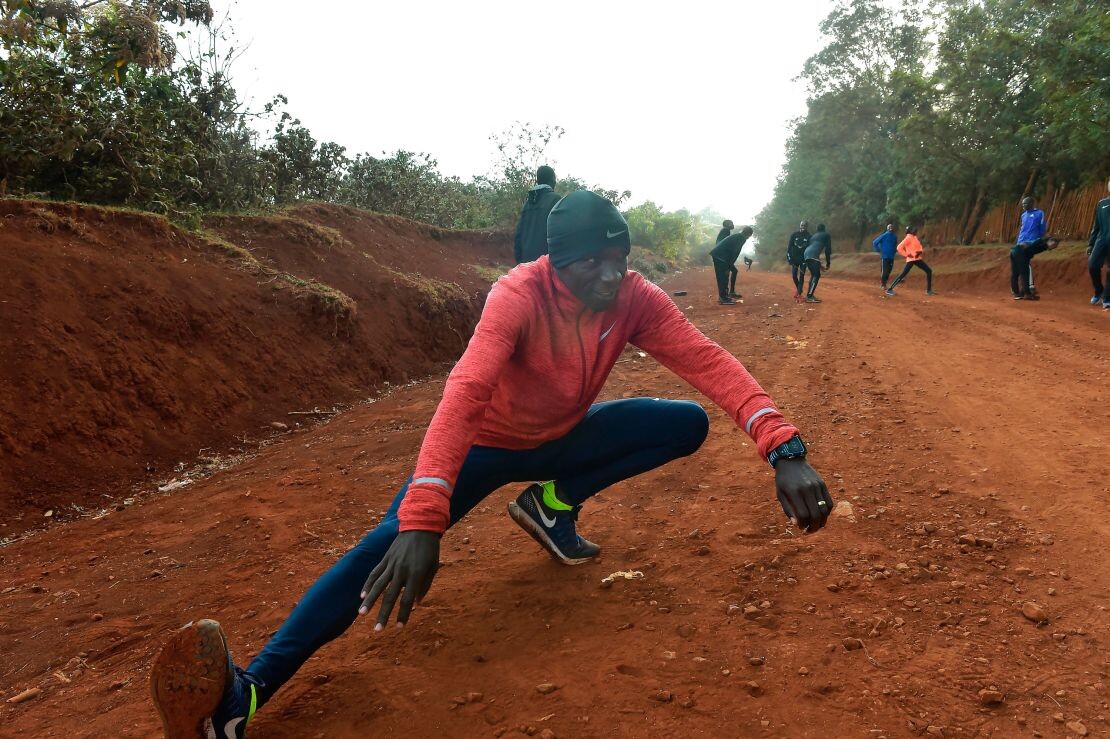
His management, the NN Running team, is also making sure the five-time Berlin Marathon champion is in the right shape to achieve his goals. One way has been to normalize training athletes on the gravel track.
Sang explained that the track helps in recovery especially when one is going for tougher sessions and it also does not affect the legs a lot.
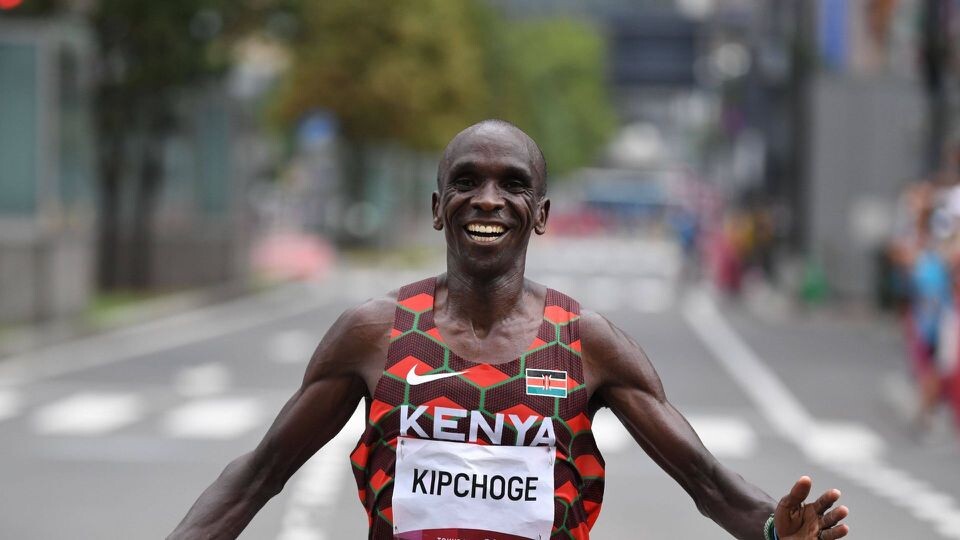
“We are at Moi University, Law School, a place in Eldoret called Annex. This is where most of the athletes do their training. You can see it’s a big group training here.
“Today, we’ve had athletes run the 800m all the way to the marathon. Of course, they come here to do specific sessions, specific to their event.
“The surface is good, I mean generally when you train on tartan or the road and train here, which is a dirt track, the recovery and the stress on the legs is less and recovery for the next hard session is quicker.
“We train here twice in a week for the track runners and for the marathoners, we do it once a week,” the veteran coach said in a documentary posted by NN Running team.
On his part, Delahaije was also quick to note that Eldoret being closer to the equator is a plus for athletes and insisted that competing on such a track reduced the risk of injury. He marveled at always finding athletes running before the crack of dawn.
“When you arrive on the track, let’s say at 6 o’clock, it’s already dark and one of the nice things is there are people running around the track and slowly by slowly, in let’s say, 10-15 minutes, the lights turn on.
“I think, when you look at injuries, it’s much safer to run at a gravel track, like Annex. Obviously, it’s a 400m track and it’s in Eldoret, so it’s a little bit lower than our grounds in Kaptagat. It’s about 2000m of altitude which I think is also perfect to do some speedwork.
“Well, Eldoret is very close to the Equator which means that there is a very stable climate, first of all. The runners also feel comfortable let’s say around 20 degrees. Well, you have that more or less all year round over there,” he added.
(06/10/2024) ⚡AMPby Abigael Wuafula
Paris 2024 Olympic Games
For this historic event, the City of Light is thinking big! Visitors will be able to watch events at top sporting venues in Paris and the Paris region, as well as at emblematic monuments in the capital visited by several millions of tourists each year. The promise of exceptional moments to experience in an exceptional setting! A great way to...
more...Comrades Marathon: Gerda Steyn Sets Course Record; Piet Wiersma Wins Men’s Race
At the 2024 Comrades Marathon, South African Gerda Steyn sets a course record in her third win while Dutchman Piet Wiersma gets his first victory.
At 5:30 a.m. on Sunday, June 9, in the raucous darkness of Durban, South Africa, more than 20,000 runners, powered by nerves, adrenaline, and the “Chariots of Fire” theme song, crossed the start line of the 2024 Comrades Marathon to take part in the oldest and largest ultramarathon in the world: nearly 86 kilometers of road running throughout the hills of South Africa’s KwaZulu-Natal province. It was the 97th running of the event, which has only missed four editions since World War I veteran Vic Clapham started it in 1921 to commemorate the lives of South African soldiers.
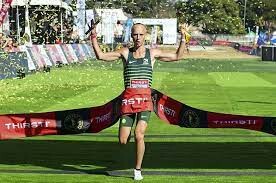
Two of the runners — Gerda Steyn, of South Africa but who lives in the United Arab Emirates, on the women’s side and Piet Wiersma of The Netherlands on the men’s — cemented their names in race lore by taking home wins, and sizable paydays, in their respective races. The race has a massive prize purse, with a total 4,092,000 Rand ($217,000) on the line.
Steyn, the defending champion, broke her own course record for the Up run direction by more than nine minutes for her third win at Comrades. She also holds the women’s course record for the Down run when the race is held in the opposite direction, which she set in 2023.
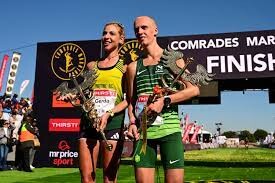
Wiersma, meanwhile, backed up his impressive Comrades debut last year — where he finished second only three seconds behind the winner — with his first win at the race.
The Comrades Marathon famously alternates the direction each year, and this year’s race, which was run in relatively ideal conditions with temperatures ranging from the mid-50s to low-70s Fahrenheit, was the 49th Up race, meaning runners began in the lower-altitude Durban and ended in the higher-altitude Pietermaritzburg. The race featured around 1,750 meters of elevation gain, with most of it during the first half of the race, when the course runs through three of its “Big Five” hills. The Up run, therefore, demands a smart, measured racing strategy.
For the race’s first half, Piet Wiersma (The Netherlands) seemed content to stay conservative and save his energy for the back half. A two-man pack of Jobo Khatoane (Lesotho), looking for his first Comrades finish, and Aleksei Beresnev (Russia), back for a second time after debuting inside the top 10 last year, were within a minute of each other at Drummond, around the halfway mark, with the next runner more than five minutes back and Wiersma sitting in 10th, almost nine-and-a-half minutes off the lead.
But then Wiersma dropped the hammer, increasing his pace to 3:37 per kilometer from 3:58 per kilometer to jump into the top five by the Cato Ridge checkpoint at 56.6 kilometers into the race. That seemingly set the tone for big moves for the race’s second half, where Beresnev was still holding the lead and followed by Degefa Yohannese Lafebo (Ethiopia). With this race, Lafebo was moving up in distance following two top-10 finishes at the Two Oceans Marathon, a 50k race.
South Africans Tete Dijana, the two-time defending champion, and Dan Moselakwe, a prior Comrades podium finisher, sat in third and fourth, respectively.
Wiersma continued to run strong and moved into the lead by Umlaas Road, 67.5k, passing Lafebo, and by Mkondeni at 79.1k, he had increased to nearly a minute. Behind him, Beresnev dropped off the pace, while Dijana couldn’t hang on, either. The pair would finish, but outside the top 10 this year.
Moselakwe took advantage of fading runners to move himself into second. Joseph Manyedi (South Africa), meanwhile, methodically moved his way up to finish in fourth, his eighth and best Comrades finish, while Andrew Davies (U.K.) jumped from 12th to fifth over the course of the second half of the race. This was Davies’ first Comrades finish.
At the finish line, Wiersma would stay clear of Moselakwe by 45 seconds and third-place finisher Lafebo by nearly three minutes.
(06/10/2024) ⚡AMPby Robbie Harms
Comrades Marathon
Arguably the greatest ultra marathon in the world where athletes come from all over the world to combine muscle and mental strength to conquer the approx 90kilometers between the cities of Pietermaritzburg and Durban, the event owes its beginnings to the vision of one man, World War I veteran Vic Clapham. A soldier, a dreamer, who had campaigned in East...
more...TWENTY-ONE YEARS AGO, HE WAS INCARCERATED FOR LIFE. LAST YEAR, HE RAN THE NYC MARATHON A RADICALLY CHANGED MAN.
RAHSAAN ROUNDED THOMAS A CORNER. Gravel underfoot gave way to pavement, then dirt. Another left turn, and then another. In the distance, beyond the 30-foot wall and barbed wire separating him from the world outside, he could see the 2,500-foot peak of Mount Tamalpais. He completed the 400-meter loop another 11 times for an easy three miles.
Rahsaan wasn’t the only runner circling the Yard that evening in the fall of 2017. Some 30 people had joined San Quentin State Prison’s 1,000 Mile Club by the time Rahsaan arrived at the prison four years prior, and the group had only grown since. Starting in January each year, the club held weekly workouts and monthly races in the Yard, culminating with the San Quentin Marathon—105 laps—in November. The 2017 running would be Rahsaan’s first go at the 26.2 distance.

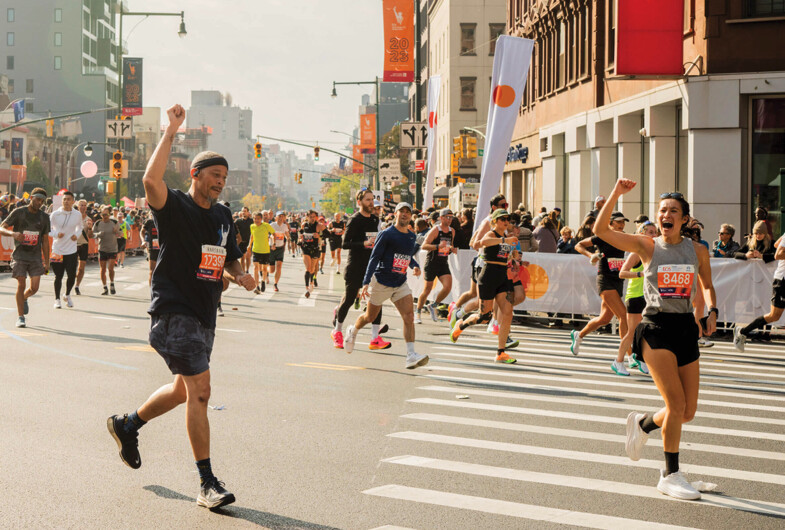
For Rahsaan and the other San Quentin runners, Mount Tam, as it’s known, had become a beacon of hope. It’s the site of the legendary Dipsea, a 7.4-mile technical trail from Mill Valley to Stinson Beach. After the 1,000 Mile Club was founded in 2005, it became tradition for club members who got released to run that trail; their stories soon became lore among the runners still inside. “I’ve been hearing about the Dipsea for the longest,” Rahsaan says.
Given his sentence, he never expected to run it. Rahsaan was serving 55 years to life for second-degree murder. Life outside, let alone running over Mount Tam all the way to the Pacific, felt like a million miles away. But Rahsaan loved to run—it gave him a sense of freedom within the prison walls, and more than that, it connected him to the community of the 1,000 Mile Club. So if the volunteer coaches and other runners wanted to talk about the Dipsea, he was happy to listen.
We’ll get to the details of Rahsaan’s crime later, but it’s useful to lead with some enduring truths: People can grow in even the harshest environments, and running, whether around a lake or a prison yard, has the power to change lives. In fact, Rahsaan made a lot of changes after he went to prison: He became a mentor to at-risk youth, began facing the reality of his violence, and discovered the power of education and his own pen. Along the way, Rahsaan also prayed for clemency. The odds were never in his favor.
To be clear, this is not a story about a wrongful conviction. Rahsaan took the life of another human being, and he’s spent more than two decades reckoning with that fact. He doesn’t expect forgiveness. Rather, it’s a story about a man who you could argue was set up to fail, and for more than 30 years that’s exactly what he did. But it’s also a story of navigating the delta between memory and fact and finding peace in the idea that sometimes the most formative things in our lives may not be exactly as they seem. And mostly, it’s a story of transformation—of learning to do good in a world that too often encourages the opposite.
RAHSAAN “NEW YORK” THOMAS GREW UP IN BROWNSVILLE, A ONE-SQUARE-MILE SECTION OF EASTERN Brooklyn wedged between Crown Heights and East New York. As a kid he’d spend hours on his Commodore 64 computer trying to code his own games. He loved riding his skateboard down the slope of his building’s courtyard. On weekends, he and his friends liked to play roller hockey there, using tree branches for sticks and a crushed soda can for a puck.
Once a working-class Jewish enclave, Brownsville started to change in the 1960s, when many white families relocated to the suburbs, Black families moved in, and city agencies began denying residents basic services like trash pickup and streetlight repairs. John Lindsay, New York’s mayor at the time, once referred to the area as “Bombsville” on account of all the burned-out buildings and rubble-filled empty lots. By 1971, the year after Rahsaan was born, four out of five families in Brownsville were on government assistance. More than 50 years later, Brownsville still has a poverty rate close to 30 percent. The neighborhood’s credo, “Never ran, never will,” is typically interpreted as a vow of resilience in the face of adversity. For some, like Rahsaan, it has always meant something else: Don’t back down.
The first time Rahsaan didn’t run, he was 5 or 6 years old. He had just moved into Atlantic Towers, a pair of 24-story buildings beset with rotting walls and exposed sewer pipes that housed more than 700 families. Three older kids welcomed him with their fists. Even if Rahsaan had tried to run, he wouldn’t have gotten far. At that age, Rahsaan was skinny, slow, and uncoordinated. He got picked on a lot. Worse, he was light-skinned and frequently taunted as “white boy.” The insult didn’t even make sense to Rahsaan, whose mother is Black and whose father was Puerto Rican. “I feel Black,” he says. “I don’t feel [like] anything else. I feel like myself.”
Rahsaan hated being called white. It was the mid-1970s; Roots had just aired on ABC, and Rahsaan associated being white with putting people in chains. Five-Percent Nation, a Black nationalist movement founded in Harlem, had risen to prominence and ascribed godlike status to Black men. Plus, all the best athletes were Black: Muhammad Ali. Reggie Jackson. Kareem Abdul-Jabbar. In Rahsaan’s world, somebody white was considered physically inferior.
Raised by his mother, Jacqueline, Rahsaan never really knew his father, Carlos, who spent much of Rahsaan’s childhood in prison. In 1974, Jacqueline had another son, Aikeem, with a different man, and raised her two boys as a single mom. Carlos also had another son, Carl, whom Rahsaan met only once, when Carl was a baby. Still, Rahsaan believed “the myth,” as he puts it now, that one day Carlos would return and relieve him, his mom, and Aikeem of the life they were living. Jacqueline had a bachelor’s degree in sociology and worked three jobs to keep her sons clothed and fed. She nurtured Rahsaan’s interest in computers and sent him to a parochial school that had a gifted program. Rahsaan describes his family as “upper-class poor.” They had more than a lot of families, but never enough to get out of Brownsville, away from the drugs and the violence.
Some traumas are small but are compounded by frequency and volume; others are isolated occurrences but so significant that they define a person for a lifetime. Rahsaan remembers his grandmother telling him that his father had been found dead in an alley, throat slashed, wallet missing. Rahsaan was 12 at the time, and he understood it to mean his father had been murdered for whatever cash he had on him—maybe $200, not even. Now he would never come home.
Rahsaan felt like something he didn’t even have had been taken from him. “It just made me different, like, angry,” he says. By the time he got to high school, Rahsaan resolved to never let anyone take anything from him or his family again. “I started feeling like, next time somebody tryin’ to rob me, I’m gonna stab him,” he says. He started carrying a knife, a razor, rug cutters—“all kinds of sharp stuff.” Rahsaan never instigated a fight, but he refused to back down when threatened or attacked. It was a matter of survival.
The first time Rahsaan picked up a gun, it was to avenge his brother. Aikeem, who was 14 at the time, had been shot in the leg by a guy in the neighborhood who was trying to rob him and Rahsaan. A few months later, Rahsaan saw the shooter on the street, ran to the apartment of a drug dealer he knew, and demanded a gun. Rahsaan, then 18, went back outside and fired three shots at the guy. Rahsaan was arrested and sent to Rikers Island, then released after three days: The guy he’d shot was wanted for several crimes and refused to testify against Rahsaan.
By day, Rahsaan tried to lead a straight life. He graduated from high school in 1988 and got a job taking reservations for Pan Am Airways. He lost the job after Flight 103 exploded in a terrorist bombing over Scotland that December, and the company downsized. Rahsaan got a new job in the mailroom at Debevoise & Plimpton, a white-shoe law firm in midtown Manhattan. He could type 70 words a minute and hoped to become a paralegal one day.
Rahsaan carried a gun to work because he’d been conditioned to expect the worst when he returned to Brownsville at night. “If you constantly being traumatized, you constantly feeling unsafe, it’s really hard to be in a good mind space and be a good person,” he says. “I mean, you have to be extraordinary.”
After high school, some of Rahsaan’s friends went to Old Westbury, a state university on Long Island with a rolling green campus. He would sometimes visit them, and at a Halloween party one night, he got into a scrape with some other guys and fired his gun. Rahsaan spent the next year awaiting trial in county jail, the following year at Cayuga State Prison in upstate New York, and another 22 months after that on work release, living in a halfway house in Queens. He got a job working the merch table for the Blue Man Group at Astor Place Theater, but the pay wasn’t enough to support the two kids he’d had not long after getting out of Cayuga.
He started selling a little crack around 1994, when he was 24. By 27 he was dealing full-time. He didn’t want to be a drug dealer, though. “I just felt desperate,” he says. Rahsaan had learned to cut hair in Cayuga, and he hoped to save enough money to open a barbershop.
He never got that opportunity. By the summer of 1999, things in New York had gotten too hot for Rahsaan and he fled to California. For the first time in his 28 years, Rahsaan Thomas was on the run.
EVERY RUNNER HAS AN ORIGIN STORY. SOME START IN SCHOOL, OTHERS TAKE UP RUNNING TO IMPROVE their health or beat addiction. Many stories share common themes, if not exact details. And some, like Rahsaan’s, are absolutely singular.
Rahsaan drove west with ambitions to break into the music business. He wanted to be a manager, maybe start his own label. His new girlfriend would join him a week later in La Jolla, where they’d found an apartment, so Rahsaan went first to Big Bear, a small town deep in the San Bernardino Mountains 100 miles east of Los Angeles. It’s where Ryan Hall grew up, and where he discovered running at age 13 by circling Big Bear Lake—15 miles—one afternoon on a whim. Hall has recounted that story so many times that it’s likely even better known than the American records he would go on to set in the half and full marathons.
Rahsaan didn’t know anything about Ryan Hall, who at the time was just about to start his junior year at Big Bear High School and begin a two-year reign as the California state cross-country champion. He didn’t even know there was a lake in Big Bear. Rahsaan went to Big Bear to box with a friend, Shannon Briggs, a two-time World Boxing Organization heavyweight champion.
Briggs and Rahsaan had grown up together in Atlantic Towers. As kids they liked to ride bikes in the courtyard, and later they went to the same high school in Fort Greene. But Briggs’s mom had become addicted to drugs by his sophomore year, and they were evicted from the Towers. Briggs and Rahsaan lost touch. Briggs began spending time at a boxing gym in East New York; often he’d sleep there. He had talent in the ring. People thought he might even be the next Mike Tyson, another native of Brownsville who was himself a world heavyweight champ from 1986 to 1989.
Briggs went pro in 1991, and by the end of that decade he was earning seven figures fighting guys like George Foreman and Lennox Lewis. Rahsaan was at those fights. The two had reconnected in 1996, when Rahsaan was trying to rebuild his life after prison and Briggs’s boxing career was on the rise. In August 1999, Briggs was gearing up to fight Francois Botha, a South African known as the White Buffalo, and had decamped to Big Bear to train. “He was like, ‘Yo, come live with me, bro,’” Rahsaan recalls.
Briggs was running three miles a day to increase his stamina. His route was a simple out-and-back on a wooded trail, and on one of Rahsaan’s first days there, he decided to join him. Rahsaan hadn’t done so much as a push-up since getting out of prison, but he wanted to hang with his friend. Briggs and his training partners set off at their usual clip; within a few minutes they’d disappeared from Rahsaan’s view. By the time they were doubling back, he’d barely made it a half mile.
Rahsaan never liked feeling physically inferior. So back in La Jolla, he started running a few times a week, going to the gym, whatever it took. Before long he was up to five miles. And the next time he ran with Briggs, he could keep up. After that, he says, “Running just became my thing.”
FOR YEARS, RAHSAAN HAD BUCKED AT TAKING RESPONSIBILITY for the murder that sent him to prison. The other guys had guns, too, he insisted. If he hadn’t shot them, they’d have shot him. It was self-defense.
In the moment, he had no reason to think otherwise. It was April 2000. A friend had arranged to sell $50,000 worth of weed, and Rahsaan went along to help. They met in the parking lot of a strip mall in L.A., broad daylight. The buyers brought guns instead of cash, things went sideways, and, in a flash of adrenaline, Rahsaan used the 9mm he’d packed for protection, killing one man and putting the other in critical condition. He was 29 and had been in California eight months.
After awaiting trial for three years in the L.A. County jails, Rahsaan was sentenced to 55 years to life. But for the crushing finality of it, the grim interminability, the prospect of never seeing the outside world again, he was on familiar ground. Even Brownsville had been a kind of prison—one defined, as Rahsaan puts it now, by division and neglect, a world unto itself that societal forces made nearly impossible to escape. He was used to life inside.
Rahsaan spent the next 10 years shuttling between maximum security facilities, the bulk of those years at Calipatria State Prison, 30 miles from the Mexican border. By the time he got to San Quentin, he was 42.
As part of the prison’s restorative justice program, Rahsaan met a mother of two young men who’d been shot, one killed and the other critically injured. Her pain, her dignity, her ability to forgive her sons’ shooters prompted Rahsann to reflect on his own crime. “It made me feel like, damn, I did this to his mother,” he says. “I did this to my mother. You don’t do that to Black mothers. They go through so much.”
ABOUT 2 MILLION PEOPLE ARE INCARCERATED IN THE UNITED States today, roughly eight times as many as in the early 1970s. Nearly half of them are Black, despite Black Americans representing only 13 percent of the U.S. population.
This disparity reflects what the legal scholar and author Michelle Alexander calls “the new Jim Crow,” an invisible system of oppression that has impeded Black men in particular since the days of slavery. In her book of the same title, Alexander unpacks 400 years of policies and social attitudes that have created a society in which one in three Black males will be incarcerated at some point in their lives, and where even those who have been paroled often face a lifetime of discrimination and disenfranchisement, like losing the right to vote. If you hit a wall every time you try to do something, are you really free? More than half of the people released from U.S. jails and prisons return within three years.
After Rahsaan got out of Cayuga back in 1992, with a felony on his permanent record, he’d had trouble doing just about anything legit: renting an apartment, finding a decent job, securing a loan. Though he’d paid for the Mercedes SUV he drove to California, the lease was in his girlfriend’s name. Selling crack had provided financial solvency, and his success in New York made him feel invincible. One weed deal in California seemed easy enough. But he wasn’t naive. Rahsaan packed a gun, and if he felt he had to use it, he would.
Today Rahsaan feels deep remorse for what transpired from there. But back then he saw no other way. “When we have a grievance, we hold court in the street,” he says of growing up in the Brownsville projects. “There’s no court of law, there’s no lawsuits.” Even while incarcerated, Rahsaan continued to meet threats with violence. But he also found that in prison, as in Brownsville, respect was temporary. “If you stab somebody, people leave you alone,” he says. “But you gotta keep doing it.”
Not long after Rahsaan got to Calipatria, around 2003 or 2004, an older man named Samir pulled him aside. “Youngster, there’s nobody that you can beat up that’s gonna get you out of prison,” Rahsaan remembers Samir saying. “In fact, that’s gonna make it worse.” Rahsaan thought about Muhammad Ali, how he would get his opponents angry on purpose so they’d swing until they wore themselves out. He realized that when you’re angry, you’re not thinking clearly or moving effectively. You’re not responding; you’re reacting.
The next time Rahsaan saw Samir was in the yard at Calipatria. They were both doing laps, and the two men started to run together. Rahsaan told Samir about the impact his words had on him, how they helped him see he’d always let “somebody else’s hangup become my hangup, somebody else’s trauma become my trauma.” Each time that happened, he realized, he slid backward.
Rahsaan began exploring various religions. He liked how the men in the Muslim prayer group at Calipatria encouraged him to think about his past, and the way they talked about God’s plan. He thought back to that day in April 2000 and came to believe that God would have gotten him out of that situation without a gun. “If I was meant to die, I was meant to die,” he says. “If I’m not, I’m not.” He started to see confrontations as tests. “I stopped feeding into the negativity and started passing the test, and I’ve been passing it consistently since,” he says.
CLAIRE GELBART PLACED HER BELONGINGS IN A PLASTIC TRAY AND WALKED THROUGH THE METAL detectors at the visitors’ entrance at San Quentin. She crossed the Yard to the prison’s newsroom. It was late fall of 2017, and Gelbart had started volunteering with the San Quentin Journalism Guild, an initiative to teach incarcerated people the fundamentals of newswriting and interviewing techniques.
Historically infamous for housing people like Charles Manson and Sirhan Sirhan, the man convicted of killing Robert Kennedy, and for having the only death row for men in California, San Quentin has in recent years instituted reforms. By the time Rahsaan arrived, the facility was offering dozens of programs, had an onsite college, and granted some of the individuals housed there considerable freedom of movement. Hundreds of volunteers pass through its gates every year.
Rahsaan was in the newsroom working on a story for the San Quentin News, where he was a staff writer. Gelbart and Rahsaan started to chat, and within minutes they were bonding over running. They talked about the San Quentin Marathon—in which Rahsaan was proud to have placed 13th out of 13 finishers in 6 hours, 12 minutes, and 23 seconds—and Gelbart’s plans to run her first half marathon that spring. “It was like I lost all sense of place and time,” Gelbart says, “like I could have been in a coffee shop in San Francisco talking to someone.”
In weekly visits over the next year, Gelbart and Rahsaan talked about their families, their hopes for the future. Gelbart had just graduated from Tufts University with dreams of being a writer. Rahsaan was working toward a college degree, writing for numerous outlets like the Marshall Project and Vice, and learning about podcasting and documentary filmmaking. In 2019, when Gelbart was offered a job in New York, she told Rahsaan she felt torn about leaving—they’d become close friends. They made a pact that if Rahsaan ever got out of prison, they would run the New York City Marathon together. “We couldn’t think of a better thing to celebrate him coming home,” Gelbart says.
When Rahsaan was sentenced, he still had hope for a successful appeal. But when his appeal was denied in 2011, he realized he was never going home. His parole date was set for 2085.
At the time, though, the political appetite for mass incarceration was starting to shift. Gray Davis, who was governor of California from 1999 to 2003, had never granted a single pardon; and his successor, Arnold Schwarzenegger, granted only 15. Then, between 2011 and 2019, Governor Jerry Brown pardoned or commuted the sentences of more than 1,300 people. Studies show that the recidivism rate among those who had been serving life sentences is less than 5 percent in a number of states, including California. And according to the U.S. Bureau of Justice, 98 percent of people convicted of homicide who are released from prison do not commit another murder.
In the fall of 2018, Governor Brown approved Rahsaan for commutation, but it was now up to his successor, Gavin Newsom, to follow through. And until a release date was set, there were no guarantees.
Back at San Quentin, Rahsaan was busier than ever. He was working on his fourth film, Friendly Signs, a documentary funded by the Marshall Project and the Sundance Institute; it was about fellow 1,000 Mile Club member Tommy Lee Wickerd’s efforts to start an ASL program to aid a group of deaf and hard-of-hearing newcomers to the prison. He had recently been named chair of the San Quentin satellite chapter of the Society of Professional Journalists and became a cohost and coproducer of Ear Hustle, a popular podcast about life in San Quentin that in 2020 was a finalist for a Pulitzer Prize. He was also sketching out plans for a nonprofit, Empowerment Ave, to build connections to the outside world for other incarcerated writers and artists and to advocate for fair compensation. And after five years, he was just one history class away from getting his associate’s degree from Mount Tamalpais College.
In January 2020, Rahsaan began his final semester, eager to don his cap and gown that June. MTC always organized a festive graduation ceremony in the prison’s visiting room, inviting families, friends, students, and staff. Then COVID-19 hit. Lockdown. All classes canceled until further notice. The 1,000 Mile Club suspended workouts and races as well, its 70-plus members scattering throughout the prison, not sure when or if they’d ever get together again. Covid would officially kill 28 people at San Quentin and make many more very ill. College graduation, let alone races in the Yard and parole hearings, would have to wait.
For the first time since arriving at San Quentin, Rahsaan felt claustrophobic in his 4-by-10-foot cell. He couldn’t work on his films or go to the newsroom. All he could do was read and write, alone. After George Floyd was murdered that May, Rahsaan fell into a depression. He remembered something Chadwick Boseman had said in a 2018 commencement speech at Howard University: “Remember, the struggles along the way shape you for your purpose.”
Rahsaan decided his purpose was to write. Outside journalists couldn’t enter the prison during the pandemic, but their publications were thirsty for prison Covid stories. Rahsaan saw an opportunity. Between June 2020 and February 2023, he published 42 articles, and thanks to Empowerment Ave, he knew what those articles were worth. As a writer for the San Quentin News, Rahsaan earned $36 a month; those 42 articles for external publications netted him $30,000.
DOZENS OF PEOPLE GATHERED OUTSIDE SAN QUENTIN’S GATES. IT WAS A FRIGID MORNING IN EARLY February 2023; the sun hadn’t yet risen. Among those assembled were two cofounders of Ear Hustle, Earlonne Woods and Nigel Poor, along with executive producer Bruce Wallace, recording equipment in hand. A procession of white vans, each carrying one or two men, arrived one by one. After three or four hours, the air had warmed to a balmy 60 degrees. Another van pulled up, Rahsaan got out, and the crowd erupted. Nearly 23 years after he’d been sentenced to 55 years to life, Rahsaan Thomas had been released.
Rahsaan got into a Hyundai sedan and was soon headed away from San Quentin. Wallace sat in the back, recording Rahsaan seeing water, mountains, and a highway from the front seat of a car for the first time in decades. “I feel like I’m escaping,” he joked. “Is anybody chasing us? This is amazing. This is crazy.”
Rahsaan called his mom, who wasn’t able to make it to California for his release.
“Hey, Ma, it’s really real,” he said, breathless with joy. “I’m free. No more handcuffs.”
Jacqueline’s exuberance can be heard in her laughter, her curiosity about what his first meal would be (steak and French toast), and her motherly rebuke of his plan to buy a Tesla.
“You ain’t been drivin’ in a while and I know you ain’t the best driver in the world,” she teased.
Rahsaan moved into a transitional house in Oakland and wasted no time adjusting to life in the 21st century. He got an iPhone, and a friend gave him a crash course in protecting himself from cyberattacks. He’s almost fallen for a few. “There’s some rough hoods on the internet,” he jokes. Earlonne Woods, who was paroled in 2018, and others taught Rahsaan how to use social media. He opened Instagram and Facebook accounts and worked on his own website, rahsaannewyorkthomas.com, which a friend had built for him while he was in San Quentin to promote his creative projects, Empowerment Ave, and even a line of merch.
Despite all the excitement and chaos, Rahsaan never forgot about the pact he’d made with Claire Gelbart. He found her on Facebook and sent a simple, two-line message: “Start training. We have a marathon to run.”
IN LATE MARCH, SIX WEEKS AFTER HIS RELEASE, RAHSAAN FLEW TO NEW YORK CITY. IT WAS THE FIRST time he’d been home in nearly a quarter century, and he hadn’t flown since before 9/11. The security protocols at SFO reminded him more of prison than of the last time he’d been in an airport. Actually, “it was worse than prison,” he jokes. They confiscated his jar of honey.
The changes to his home borough were no less surprising. He’d come to New York to take work meetings, see family, and catch a Nets game at Barclays Center in downtown Brooklyn. Rahsaan barely recognized Barclays; it had been a U-Haul lot the last time he was there, and skyscrapers now towered over Fulton Mall, where he used to buy Starter jackets at Dr. Jay’s and Big Daddy Kane tapes at the Wiz.
He met up with Gelbart on Flatbush Avenue, where come November they’d be just hitting mile 8 of the New York City Marathon. They hadn’t been allowed to touch at San Quentin and weren’t sure how to greet each other on the outside. “It was weird at first, because I was like, do we hug?” Gelbart recalls. But the awkwardness faded fast, and as they walked, Gelbart saw a different side of Rahsaan. “He seemed so much more relaxed,” she says. “Much happier, much lighter.”
Back in 1985, just a few blocks from where Rahsaan and Gelbart walked now, Rahsaan, his brother Aikeem, and his friend Troy had been on their way home from the Fulton Mall when out of nowhere, about a dozen guys rolled up on them. They started beating on Troy and, for a minute, left Rahsaan and Aikeem alone. Images of his father, throat slashed, flashed through Rahsaan’s mind. He pulled a rug cutter out of his pocket, ran to the smallest guy in the group, and jabbed it into the back of his head. “They looked at me like they were gonna kill me,” Rahsaan says. He threw the blade to the ground, slid his hand inside his coat, and held it there. “Y’all wanna play? We gonna play,” he said. The bluff worked; the guys ran. It was the first time Rahsaan had ever stabbed someone.
Change sometimes occurs gradually, and then all at once. That was a different Brooklyn, a different Rahsaan. He began to confront his own violence when he had met Samir some 20 years before, and continued to do so through his studies, his faith, his work in restorative justice, and his own writing. But the origin of his tendency toward violence, the death of his father, remained firmly rooted in his psyche. Then, in 2017, Rahsaan spoke for the first time with his estranged half-brother, Carl.
Carl had read Rahsaan’s work, and asked why he always said their father had been murdered.
“That’s what grandma told me,” Rahsaan said.
“But he wasn’t murdered,” Carl told him. “He killed himself.”
And it wasn’t in 1982, as Rahsaan remembered, but in 1985—the same year Rahsaan started carrying blades.
Rahsaan didn’t believe it until Carl sent him a copy of the suicide note. Even then he remained in shock. “To think I justified violence, treating robbery like a life-or-death situation, over a lie,” he says. Jacqueline was as surprised as Rahsaan to learn the truth of Carlos’s death. He never seemed troubled or depressed to her when they were together, but, “You can’t really read people,” she says. “You don’t know.”
Rahsaan still can’t account for why his grandmother told him what she did, nor for the discrepancy between his memory and the facts. Regardless, after more than 30 years, Rahsaan was finally able to let go of the one trauma that had calcified into an instinct to kill or be killed. And he has no intention of dredging it back up.
THE FASTEST RUNNER IN THE 1,000 MILE CLUB’S HISTORY IS MARKELLE “THE GAZELLE” TAYLOR, WHO was paroled in 2019 and went on to run 2:52 in the 2022 Boston Marathon. Rahsaan is the slowest. At San Quentin, he was often the last one to finish a race, but that wasn’t the point—he liked being out in the Yard with the guys. It gave him a sense of belonging, and not just to the 1,000 Mile Club, but to the running community beyond.
Like every other 1,000 Miler who gets released from San Quentin, Rahsaan had a rite of passage to conquer. On Sunday morning, May 7, 2023, he met a handful of other runners from the club and a few volunteer coaches in Mill Valley. After a decade of gazing up at Mount Tam from the Yard as he completed one 400-meter loop after another, Rahsaan was finally about to run over the mountain all the way to the Pacific.
The runners did a few final stretches, wished one another luck, and started to run. Almost immediately they had to climb some 700 stairs, many made of stone, and the course only got more treacherous from there. Uneven footing, singletrack paths, and 2,000-plus feet of elevation all conspire to make the Dipsea notoriously difficult. The giant redwoods and Douglas firs along the course were lost on Rahsaan; he never took his eyes off the ground.
One of the coaches, Jim Maloney, stayed with Rahsaan as his guide, and to help him if he slipped or fell. Markelle Taylor came too, but said he’d meet them in Stinson Beach. He knew how dangerous the trail was, Rahsaan says, and had vowed to never run it again. After his own initiation, Rahsaan decided that he, too, would never do it again. “I’ve been shot at,” he says. “I’ve been in physical danger. I don’t want to revisit danger.”
Rahsaan now logs most of his miles on a treadmill because of knee issues, but on occasion he ventures out to do the 3.4-mile loop around Lake Merritt, a lagoon in the heart of Oakland. He decided to use the New York City Marathon to raise money for Empowerment Ave, and to accept donations until he crossed the finish line in Central Park. Gelbart wrote a training plan for him and got him a new pair of shoes. In prison, Rahsaan had run in the same pair of Adidas for three years, and he was excited to learn about the maximalist shoe movement. Gelbart tried to interest him in Hokas, but Rahsaan thought they were ugly. He wanted Nikes.
In June, Gelbart went to the Bay Area to visit family and met Rahsaan for a six-mile run around Lake Merritt. As they looped the lake at a conversational 11:30 pace, they talked about work, relationships, and, of course, the New York City Marathon. Rahsaan was disappointed to learn that he would probably not be the last person to finish. (He still holds the record for the slowest San Quentin Marathon in its 15-year history, and he hopes no one ever beats it.) Besides, the more time he spent on the course in New York, he figured, the longer people would have to donate to Empowerment Ave.
On Sunday, November 5, Gelbart and Rahsaan made their way to Staten Island. Waiting at the base of the Verrazzano Bridge, Gelbart recorded Rahsaan singing along to Frank Sinatra’s “New York, New York” for Instagram, and captioned the video “back where he belongs.” They documented much of their race as they floated through Brooklyn, Queens, Manhattan, and the Bronx: greeting friends along the course, enjoying a lollipop on the Queensboro Bridge, beaming even as their pace slowed from 11:45 per mile for the first 5K to 16:30 for the last. Rahsaan finished in six hours, 26 minutes, and 21 seconds, placing 48,221 out of 51,290 runners. The next day, he sent me a text: “The marathon was pure love.” What’s more, he received more than $15,000 in donations for Empowerment Ave, enough to start a writing program at a women’s prison in Texas.
Every runner has an origin story. Every runner finds a reason to keep going. At Calipatria, Rahsaan liked to joke that he ran because if an earthquake ever came along and brought down the prison’s walls, he needed to be in shape so he could escape and run to Mexico. In San Quentin, he ran for the community. Today he has a new reason. “I heard that running extends your life by 10 years,” he says, “and I gave away 22.” Now that he’s out, his motivation has never been higher. He has so much to do.
(06/09/2024) ⚡AMPSix-Time Cancer Survivor Runs a Marathon on Every Continent
“Don’t let anyone tell you what you’re capable of. That’s for you to determine.”
For the last mile of the Antarctica Marathon, Jonathan Acott played one song on repeat. Trudging through snow and icy winds on the edge of the world, the runner from Surrey, United Kingdom, listened to Tim McGraw’s hit, “Live Like You Were Dying.” It was a fitting anthem for the six-time cancer survivor in his pursuit to run a marathon on all seven continents.
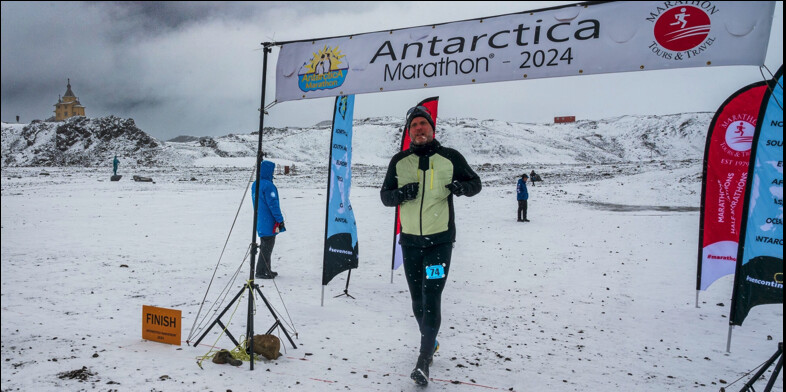
With 500 yards remaining in the race, Acott took his headphones out. He wanted to be fully present for the homestretch of the seventh marathon. Running downhill toward a small tent with a timer next to the Russian research station, the 48-year-old made his way to the finish line area, where a group of volunteers and fellow competitors cheered him on.
His legs sore from the descent, Acott took a moment to compose himself before stepping across the finish line, completing a challenge that seemed unimaginable five years ago. “The photographers are there and they say, ‘Put your arms up!’ But I don’t want to put my arms up. That’s not how I want to celebrate,” Acott said. “I needed to stop at that moment. There’ll be other mountains, but right now I just want to stop.”
Amid the devastation caused by multiple cancers and the arduous healing process that followed, Acott transformed his life, becoming a motivational speaker, coach, and avid runner intent on chasing epic goals. For Acott, becoming a member of the Seven Continents Club—645 men and 358 women who have completed 26.2 on all seven continents—is the latest example of the runner choosing to embrace every moment.
‘If I’m moving, I’m not dead.’
Acott’s cancer journey began 20 years ago. In 2004, he was diagnosed with testicular cancer at 29 years old. His first relapse occurred in 2007 when doctors discovered a tumor in his chest. He relapsed again in 2013 and 2016 and underwent back-to-back retroperitoneal lymph node dissections, a surgery to remove the lymph nodes in the back of the abdomen. In 2017, he was diagnosed with bowel cancer. The following year, doctors discovered he relapsed again. His final surgery in 2018 involved removing his kidney and spleen. The spleen ruptured during the procedure, which required an emergency blood transfusion on top of chemotherapy post-operation.
In a span of 14 years, Acott underwent numerous rounds of chemotherapy (he estimates about seven months total) and six surgeries that left his body riddled with lifelong side effects, including permanent nerve damage and hearing loss. The experience also took a heavy toll on his mental health. At his lowest, Acott suffered from suicidal ideation. Working with a psychiatrist helped him cope and reframe his perspective.
“Life is unfair to everybody. This just happens to be it,” Acott said. “And I can do two things. I can sit there and wallow about how miserable life is, or I can accept that life is difficult and hard and challenging, and you can make the most of it.”
Since 2018, Acott has been cancer free. After the last bout of the disease, his doctors encouraged him to start walking in the recovery process. He also lost his job after being unable to work during treatment. Walking not only gave him time to process his emotions, it also gave him something to work towards. In a few months, Acott was walking up to three hours at a time.
After spending months building up to long distances, Acott decided he wanted to be more efficient by running. “I push because if I’m moving, I’m not dead,” Acott said. “If I’m moving further each day, I am getting healthier.”
Because Acott is immunocompromised and his body takes longer to heal now, he trains every other day. He’s also battling pain most of the time from scars and neuropathy in his feet, among other ailments, and needs to run a conservative pace most of the time. “My body has been through a lot, but it’s still capable of doing so much," he said.
Choosing to live in optimism
In the fall of 2019—15 months after his last surgery—Acott raced the Berlin Marathon as a way to celebrate his comeback. He finished his first 26.2 in 4:58:38. Shortly after, he set out to complete the seven continents challenge.
“I chose to apply myself to making the most of my time because I don’t know how much time I have,” Acott said. “It’s a choice about how you live. You can live in fear, and I am always scared, or I can live in optimism that I’m going to have the best life I possibly can.”
The following year, he ran the Africa leg at the 2020 Marrakech Marathon in 4:45:48. In 2020, he also took up motivational speaking on top of his full-time job as the head of guest experience at a business complex.
After COVID restrictions were lifted, he finished the 2022 Austin Marathon in 5:15:28. The same year, he completed the South America portion by finishing the Curaçao Marathon in 5:09:16, trudging through flood waters on the course.
He ran the Asia leg with a 5:15:33 at the 2023 Dubai Marathon along a desert roadway. Last fall, he covered Australia at the 2023 Perth Marathon with a finishing time of 5:01:40. On March 21, he completed the Antarctica Marathon in 5:38:16.
Looking back on the experience, Acott remembered his surgeon’s warning after the last procedure. The doctor told him he wouldn’t be able to complete the same physical feats he used to do before cancer. Less than two months after completing the global marathon challenge, he’s already training for his next goal—breaking four hours in the marathon.
“Don’t let anyone tell you what you’re capable of,” Acott said. “That’s for you to determine. Find what the best version of you looks like, and make it happen.”
MORE FROM RUNNER'S WORLD ON APPLE NEWS
(06/09/2024) ⚡AMPby Runner’s World
American track star Parker Valby wins NCAA 10,000m title in controversial shoes
Valby wore customized Nike Vaporfly Next% 3 track spikes, which are 40 mm high.
There is no doubt University of Florida athlete Parker Valby is one of the best American distance runners on the scene today; on Thursday, she earned her fifth career NCAA track and field title, winning the women’s 10,000m event in a championship record 31:46.09. After the race, Valby told Citius Mag she had a boost from her custom 40 mm stack height Vaporfly Next% 3 track spikes, which, if the NCAA followed World Athletics competition rules, would be illegal.
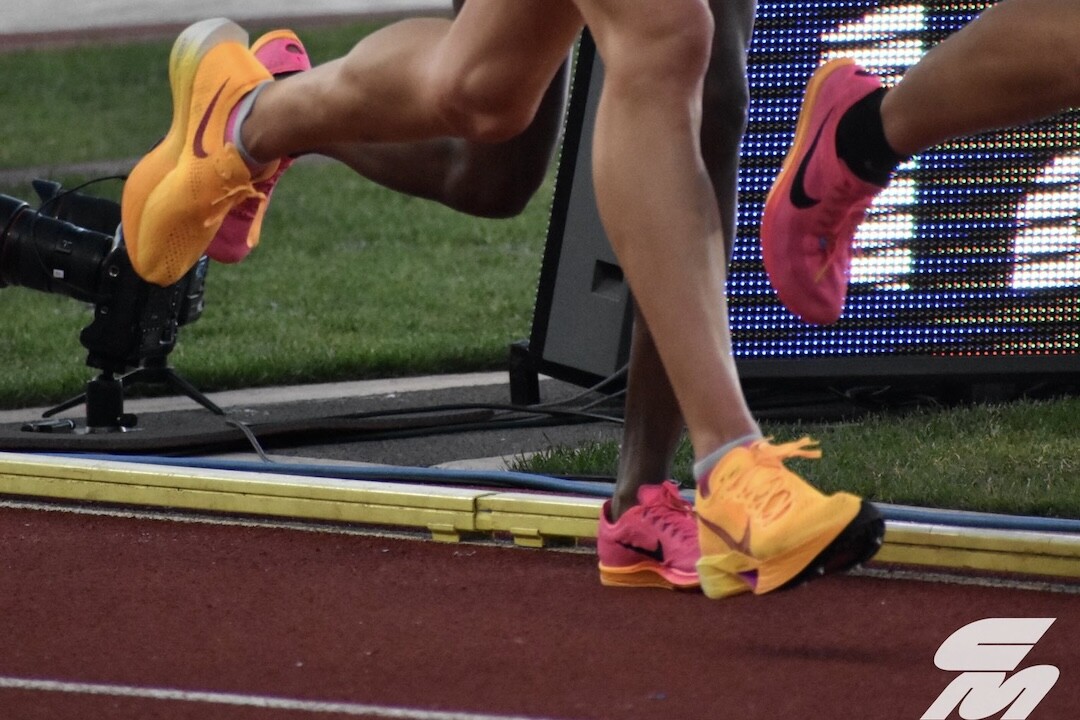
Since there are no rules against 40 mm shoes (with or without spikes) or prototypes in the NCAA, Valby was allowed to wear them. In World Athletics-accredited competitions, track spikes with a stack height over 25 mm are not allowed. When Valby was asked about her spikes post-race, she said Nike made them for her and presented several options for this race.
The Nike Vaporfly Next% 3 is typically used for road racing, and features a carbon-fiber plate and a max-cushioning midsole with a 40 mm stack height in the heel. This combination of the carbon-fiber plate and foam on impact increases energy return, meaning more of the runner’s exerted energy is converted into forward motion, improving speed and reducing fatigue. With spike pins added, this shoe would certainly enhance performance significantly on the track.
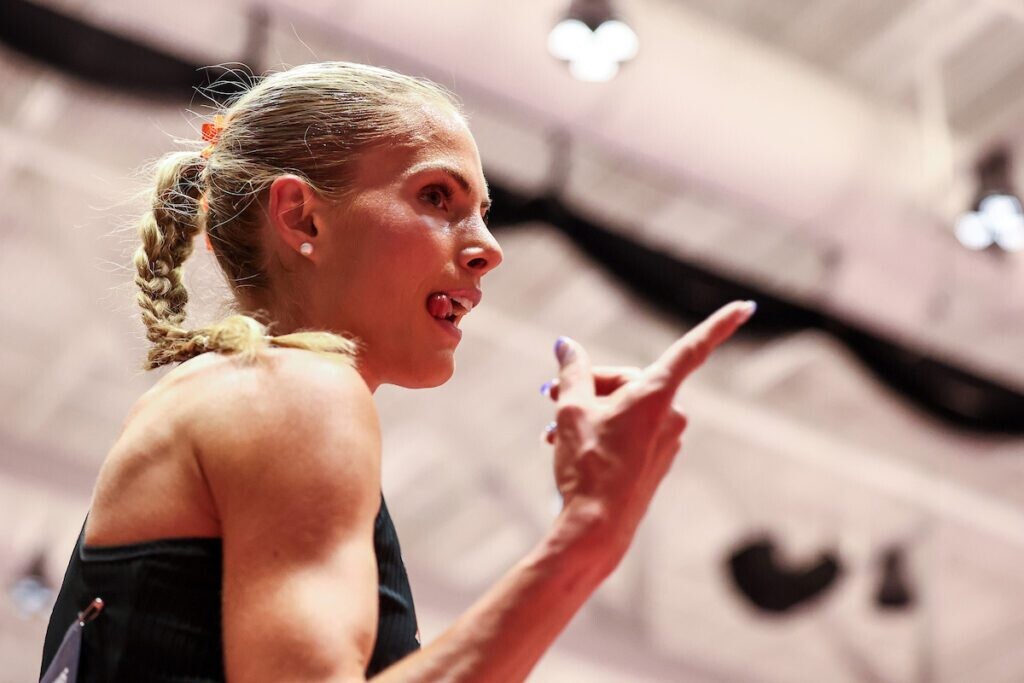
Valby will compete again at the 2024 NCAA Track and Field Championships on June 8 in the women’s 5,000m. She has not stated whether she will wear her personal prototype shoe. She is the reigning NCAA champion over the distance.
Valby, 21, was the only athlete in the women’s 10,000m final wearing these max-cushioned custom spikes, and she made it look easy, spending the first few laps of the 10,000m waving to herself on the Hayward Field jumbotron. Since USATF follows World Athletics competition rules, Valby’s winning time from this race would not be eligible for the U.S. Olympic Trials 10,000m qualification (though it doesn’t matter, since she has previously run a qualification time wearing a WA-legal pair of spikes).
World Athletics introduced in-competition stack height rules in 2021 to ensure fairness, maintain the integrity of the sport and address the performance advantages provided by technological advancements in footwear. As things stand in the NCAA, athletes who wear shoes with a heel stack height over the legal 25 mm will not have their times count for anything outside of the NCAA; this makes monitoring the issue extremely complicated, with hundreds of meets condensed over a 3.5-month season.
(06/08/2024) ⚡AMPby Marley Dickinson
New York Mini 10k 2024: Senbere Teferi wins third consecutive race
Senbere Teferi, a two-time Olympian and two-time World Championships medalist from Ethiopia, won her third consecutive Mastercard New York Mini 10K in a time of 30:47, just shy of the record she set in 2023 with a time of 30:12.
ABC 7 New York provided live streaming coverage of the New York Road Runners' Mini 10K race in Central Park with more than 9,000 runners expected this year.
Teferi also won 2019 UAE Healthy Kidney 10K in New York and the 2022 United Airlines NYC Half, which was the second-fastest time in the history of the event.
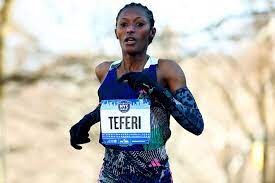
"It is such a special race because there is a bond that exists with thousands of women also running. Even though we are not related, I feel supported like we are all sisters in running," Teferi said prior to today's race.
2022 TCS New York City Marathon champion Sharon Lokedi finished second with a time of 31:04.
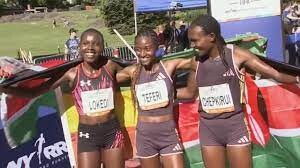
Lokedi was also the runner-up at both the 2022 Mastercard New York Mini 10K and the 2024 Boston Marathon.
"Although I have only run the Mini once before, I felt embraced by the many thousands of women who ran the race before me, and hope to inspire the many thousands more who will come after me," Lokedi said prior to today's race. "It's an awesome thing, how women from so many different places and life experiences can come and feel connected to each other through the simple act of running a loop in Central Park."
Sheila Chepkirui finished third (31:09) while American Amanda Vestri finished fourth (31:17).
The 2024 Mastercard New York Mini 10K will feature four past champions, five Paris 2024 Olympians, and seven of the top 10 finishers from the 2024 U.S. Olympic Marathon Trials.
The 52nd running of the event also featured members of 2024 U.S. Olympic Women's Marathon Team - Fiona O'Keeffe, Emily Sisson, and Dakotah Lindwurm.
New York Road Runners started the Mini 10K in 1972 as the first women-only road race, known then as the Crazylegs Mini Marathon. Seventy-two women finished the first race, and three weeks later Title IX was signed into law, guaranteeing girls and women the right to participate in school sports and creating new opportunities for generations of female athletes.
The Mastercard New York Mini 10K is now one of nonprofit NYRR's 60 adult and youth races annually and has garnered more than 200,000 total finishers to date.
The 2024 Mastercard New York Mini 10K offered $39,500 in total prize money, including $10,000 to the winner of the open division. Mastercard served as title sponsor of the event for the fourth year, and as part of its ongoing partnership with NYRR will also serve as the presenting sponsor of professional women's athlete field.
Eyewitness News provided live updates from the race and streamed the event live on abc7NY. An all-women team of WABC sports anchor Sam Ryan and meteorologist Dani Beckstrom, along with U.S. Olympian Carrie Tollefson, host of the Ali on the Run Show podcast Ali Feller, and running advocate Jacqui Moore anchored the coverage.
(06/08/2024) ⚡AMPNew York Mini 10K
Join us for the NYRR New York Mini 10K, a race just for women. This race was made for you! It’s the world’s original women-only road race, founded in 1972 and named for the miniskirt, and it empowers women of all ages and fitness levels to be active and to look and feel great on the run. Every woman who...
more...Suriname sprinter blames Gatorade for positive doping test
On Monday morning, Surinamese sprinter and current world U20 100m record holder Issam Asinga was issued a four-year doping ban by the Athletics Integrity Unit (AIU) after testing positive for the metabolites of GW1516 in an out-of-competition test on July 18, 2023. Asinga and his agent claimed the positive test resulted from ingesting Gatorade Recovery Gummies, which were given to him after he won the Gatorade U.S. Boys Track and Field Athlete of the Year award last July.
A few weeks later, at the South American Athletics Championships in São Paulo, Brazil, Asinga set a new U20 100m world record of 9.89 seconds, only to be provisionally suspended two weeks later, just before the start of the 2023 World Athletics Championships in Budapest.
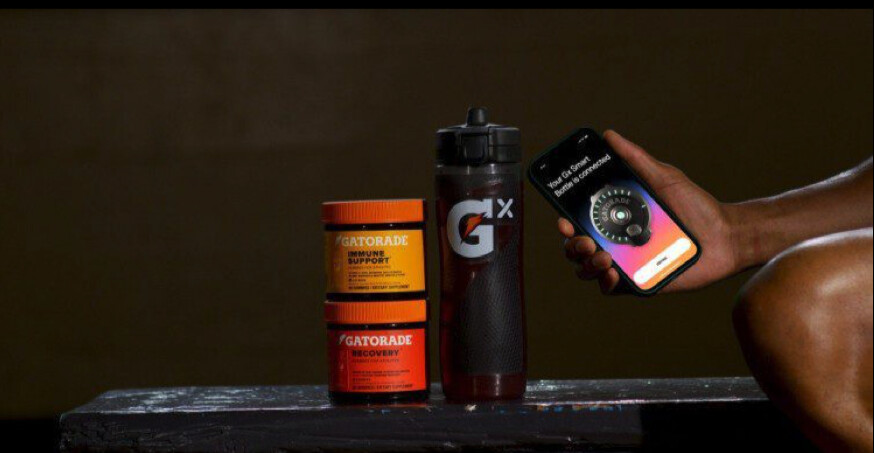

GW1516 was originally developed to treat obesity and diabetes, but is not approved for human use, due to its carcinogenic effects. It is banned both in and out of competition and is not eligible for a Therapeutic Use Exemption (TUE). A USADA bulletin from 2019 states that GW1516, also known as cardarine or endurobol, has been found in some supplements, despite being illegal.
Asinga claimed he took gummies from Gatorade that were supposed to help with recovery. He said two containers of the gummies revealed the presence of the banned substance, but the AIU panel stated he did not show proof that the gummies were the source of the drug found in his sample.
According to the AIU, Asinga claimed he took the Gatorade gummies the week before the positive test, and that subsequent testing of two unsealed containers of Gatorade gummies, provided by the athlete, revealed the presence of GW1516 and GW1516 sulfoxide. “The Disciplinary Tribunal found that Asinga did not satisfy his burden of proof to establish that the Gatorade Recovery Gummies were the source of the GW1516 metabolites detected in his sample.”
In making its decision, the AIU Disciplinary Tribunal stated that the Gatorade recovery gummies provided in unsealed containers by the athlete for testing contained significantly more GW1516 on the outside than on the inside, which practically excludes any contamination by raw ingredients during the manufacturing process. They also noted that the gummies were batch-tested by the National Sanitation Foundation (NSF), and that a sealed jar of the Gatorade recovery gummies, from the same batch taken by Asinga, tested negative for GW1516.
The 19-year-old sprinter plans to appeal the ban, which would take the case to the Court of Arbitration for Sport (CAS) in Switzerland.
All of Asinga’s results from July 18 onward will be disqualified, including his two South American Championships gold medals in the 100m and 200m, as well as his world U20 100m record of 9.89 seconds.
(06/08/2024) ⚡AMPby Running Magazine
Shalane Flanagan Finds Her Sweet Spot With College Coaching
She’s juggling the University of Oregon women’s distance runners, the Bowerman Track Club, and a young family.
Before she gives a new workout to her University of Oregon athletes, Shalane Flanagan will try it out herself.
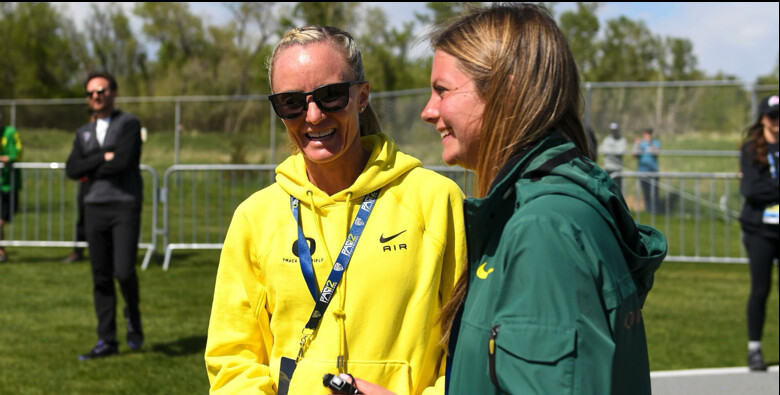
During cross-country season, it was a 5-mile tempo loop. Was it too hilly? Were the turns too sharp? In April, she was “messing around at the track one day,” as she described it, when she attempted a descending ladder of mile-800-600-400 at 10K-5K-3K-1500 pace with a short jog recovery.
“Yeah, that’s really hard,” she thought to herself. “But I think if they did that twice, it would make 10K runners feel really prepared.” Her goal with the experimentation is to make sure a workout is “feasible, but not outlandish” before her runners do it.
Few distance coaches in the NCAA are doing what she does, testing hard workouts, although Flanagan, 42, is quick to say that she does not hit the same splits her athletes do. Her boss, Oregon head coach Jerry Schumacher, is not so sure. “I see her out running every now and then, holy cow, she’s flying,” he told Runner’s World, quipping that it’s too bad she’s used up her NCAA eligibility.
Fewer still have the credentials that Flanagan, a four-time Olympian, has. She was the Olympic silver medalist in the 10,000 meters in 2008 and the 2017 New York City Marathon champion. Since she retired in 2019, she stayed on as an assistant coach with the Bowerman Track Club, a Nike pro group also coached by Schumacher that she ran for in the latter stages of her career.
That experience gives her credibility with her runners. So when she tells her athletes that they’re ready to handle a workout or race a certain time, they believe her.
“I don’t like to refer back to myself a lot,” she said in an interview at her home, a large 1920s colonial about a half mile from Hayward Field. “But I’ll say, ‘Hey, I’ve had experience with this,’ and I think they know, when I’m giving them advice, it’s not a hypothetical. I’m not projecting or guessing.
“They know it’s coming from a genuine place, because I’ve lived it,” she added. “I think that can be helpful with their confidence.”
Multiple full-time jobs
Flanagan had been living near Portland, Oregon, with her husband, Steve Edwards, and toddler son, Jack, when Schumacher was hired as the head coach of Oregon in Eugene, two hours south, in the summer of 2022. He brought Flanagan on as an assistant coach, while both kept their responsibilities with the Bowerman team, which also moved to Eugene. It was a lot.
Those early days for Flanagan—getting to know 11 female distance runners on the team, developing their training, learning the ever-changing NCAA rules, recruiting—were exhausting. And that was before they adopted a second child, Grace, as a newborn, in January 2023. They had only hours notice before Grace’s arrival.
Flanagan gets childcare help for Jack, almost 4, and Grace, 1, from a variety of babysitters and her parents. Her father, Steve Flanagan, and her stepmother visit often. One time, Flanagan had some team members’ parents visiting, and she turned around to see her dad showing them her Olympic medal. “What are you doing?” she asked him. “Put that away, that’s embarrassing.”
About three months in, when Schumacher asked her how she was handling the workload, she told him she was overwhelmed. “I’m really tired,” she said, “but this is the most fun I’ve ever had professionally. Like, I really love this job. I really love college athletics.”
Schumacher gave her full autonomy to write the training for Oregon’s women. And unlike with the Bowerman program, which former runners have said did not have much variation depending on the athlete, Flanagan has personalized training at Oregon for each individual. Some athletes on her team run as little as 25 miles per week, others go as high as 75.
One cornerstone of her training is the weekly long run on Sundays, and most weeks it has some structure to it, with tempo portions or a fartlek. For most of the team, the distance ranges from 12 to 16 miles, depending on the person.
When she first arrived in Eugene, she wrote the training with ranges in mileage. Easy days, for instance, she’d have her runners do 6 to 8 miles, depending on how they felt. They didn’t like that. They wanted an exact number. Getting them to trust themselves, listen to their bodies, and know the difference between muscle soreness and a potential injury has been one of her biggest challenges.
“I have tried to instill in them that they need to learn their body,” she said. “Like, I’m not in their body—they need to take stock and learn how to read their body. It’s one of the greatest skills and assets I felt like I had [as a runner].”
Flanagan tries to run with various groups at least one day per week on their easy runs. “It’s fun to run with the coach,” said Klaudia Kazimierska, who was fourth in the 1500 meters at the NCAA outdoor championships in 2023. “She’s a great inspiration, and she was a great athlete. She tries to give us a lot of information—and she tries to show us that running is so fun.”
Flanagan finds it easier to learn about her athletes when they’re on the run instead of sitting down and looking at one another. She’ll pick up vibes about what’s going on with them and urge them to limit their social media, especially when it comes to training.
“They devour information about what everyone else is doing,” Flanagan said. “I tell them, ‘You’ve got to be careful what goes in your head.’ I don’t follow any other kids from any other programs or any other coaches. I think it would undermine my intuitiveness. I don’t want to know.”
At the same time, she finds her college athletes much more professional than she was as an undergraduate at the University of North Carolina, when she worked hard, but also focused on her classes and other parts of college life. Not these women. “If anything, I’m like, ‘Yo, you’ve got to chill out. You’ve got to dial this back,’” she said. “They’re really into their running and I don’t have to nudge or push. They are really on top of it. It’s kind of freaky.”
Mixed results
Flanagan’s approach has yielded immediate results, but some athletes have had setbacks as well.
Last year, four qualified for the NCAA outdoor championships in the distance events, from 800 to 10,000, including three who made the final in the 1500.
Early in the 2024 outdoor season, the Ducks seemed destined to have more in this year’s championship meet, which started June 5 at Hayward Field.
At the end of March, Maddy Elmore set a school record in the 5,000 meters, running 15:15.79. Two weeks later, Şilan Ayyildiz, a transfer from the University of South Carolina who had been at Oregon for only about three months, ran 15:15.84.
Ayyildiz lines up at the NCAA championships this weekend, along with Kazimierska and Mia Barnett in the 1500 meters, and a freshman steeplechaser, Katie Clute. But Elmore sustained an injury to her soleus in late April and was unable to run in the qualifying meet for NCAAs. Flanagan’s total is again four athletes at NCAAs. She had hoped to have at least one qualifier in every event distance event.
In her short tenure, she has seen how college students have to grapple with stress, classes, finals, and in some cases, anxiety. They pick up illnesses. The big result doesn’t always come at the right time—if it comes at all. “I see these things and I see how they move and handle the work, but sometimes in this season, I may not get the performance in a race,” she said. The coach is still learning.
A busy summer
Elmore might be back in time to race the Olympic Trials, which begin on June 21. Kazimierska will go home to Poland and hope to make the Polish Olympic team in the 1500 meters. As soon as the season is over, Flanagan will turn more of her attention to the Bowerman team, which currently has three women: Karissa Schweizer, Christina Aragon, and Kaylee Mitchell. The club had several departures from the men’s and women’s side after Shelby Houlihan’s doping ban in 2021 and the move to Eugene in 2022.
It’s been difficult for Flanagan to watch the turnover, especially as some of the athletes she’d trained alongside for years, like steeplechaser Courtney Frerichs, left. They’re friends.
At the same time, Flanagan understands it. She changed coaches a few times herself during her career. It would be selfish for her to expect them to stay.
“Especially at the end of a career, to eke out those last big performances, sometimes you need a change of scenery,” she said. “I actually think it’s healthy to get different training, a different stimulus. Sometimes you can fall into this monotony and it feels stale especially if you’ve been doing it for a while.”
When she heard from athletes that they were thinking of leaving Bowerman, Flanagan jumped in with suggestions.
Her coaching brain took over to help.
“At the end of the day, I want them to be successful and happy,” she said. “So when they expressed maybe needing a change, I’m like, ‘Okay, let’s work through this. What are your plans? I don’t want you to leave and aimlessly not have a plan. What does that look like, what do you want to do?’ It’s a natural evolution.”
(06/08/2024) ⚡AMPby Runner’s World
Canadian ultrarunner Reid Coolsaet weighs in on Awesome Sauce controversy
Carbs, calories and conflicting labels have been the focus of ultra-trail talk on social media over the last few weeks, all circling around Spring Energy’s Awesome Sauce gel. In an Instagram post, Olympic marathoner and ultra-trail runner Reid Coolsaet weighed in on his less-than-ideal experience with the race fuel during the 2023 edition of Pike’s Peak Ascent 21K, in Manitou Springs, Colo.–his last competitive race.
“If I had been consuming Awesome Sauce in the peak of my career or in a race I was gunning for the podium, I’d be super pissed,” he said.
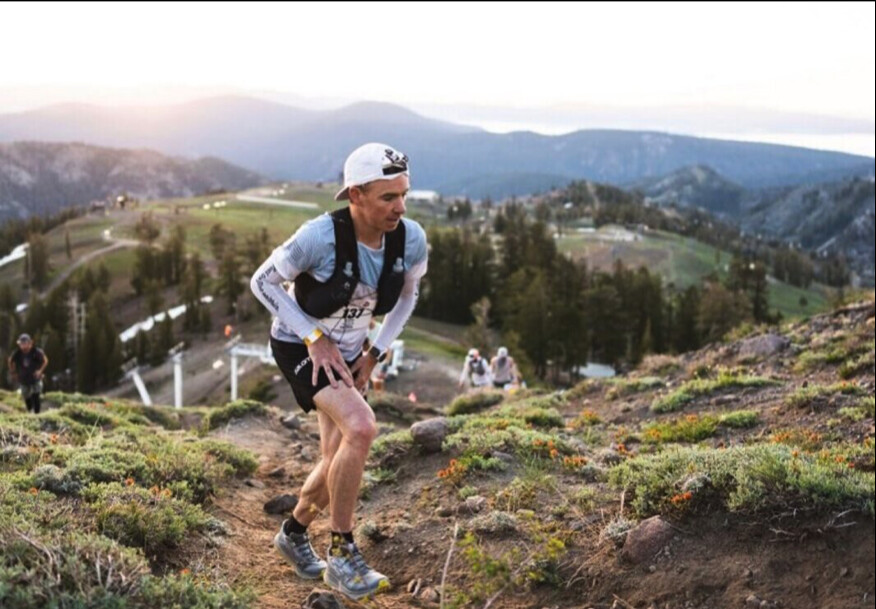
Coolsaet’s post comes on the tail of a controversy about Awesome Sauce that has been steadily gaining steam. In April, an ultrarunner on Reddit shared their doubts about Awesome Sauce’s energy content. The original poster, who stated that they worked as an environmental chemist, noticed that they experienced a “hollowed-out stomach” feeling after consuming an Awesome Sauce gel, which claims to pack 180 calories and 45 grams of carbohydrate. They performed an at-home experiment with a dehydrator and a kitchen scale, concluding that an Awesome Sauce gel provides a runner with only around 60 calories and 17 grams of carbohydrate.
While various elites, amateurs and Internet trolls weighed in on their beliefs around the content of Awesome Sauce, coach and pro ultrarunner Jason Koop purchased some gels and sent them to an independent lab for testing, then shared the results on his website and Instagram. The verdict? Koop reports that an Awesome Sauce gel contains 75 calories (not 180, as labelled), and 18 grams of carbohydrate (as opposed to the 45 grams claimed on the label).
Coolsaet explains the challenges that committing poor fuelling choices (unknowingly) caused him. While he struggled during the final third of Pike’s Peak, he assumed it was due to altitude (the race finishes at over 4,000m). “I didn’t think fueling had anything to do with falling apart because I thought I was consuming about 65 grams of carbs per hour,” said Coolsaet, who was drinking Tailwind and eating Awesome Sauce gels during the race. “Now it sounds like instead of 45 grams of carbs in each Awesome Sauce there are only 18 grams (check out @jasonkoop’s post). So I was really only getting 35 grams of carbs an hour, which isn’t going to cut it when racing for 2-3 hours.”
At the end of April, Spring Energy responded to the Reddit poster, stating that they value constructive criticism and input. “Our analysis supports the accuracy of our product labeling. However, we will reevaluate to make sure our data is accurate,” they wrote.
(06/08/2024) ⚡AMPby Running Magazine
Why You (Yes, You) Were Born to Run
A new analysis in Nature Human Behaviour bolsters the case that persistence hunting—and, by extension, running itself—is a key part of our collective history.The theory that human endurance evolved out of our need to outrun our prey has intrigued runners for four decades. After all, the idea of “persistence hunting” presents a much more romantic explanation for our otherwise pathological obsession with slogging through the Trial of Miles. According to the original endurance hunting theory laid out in a 1984 paper by David Carrier, modern runners are actually expressing the essential spirit of our species. It is running that, as the cliché goes, made us human—and that’s why so many of us still run.
It’s such a lovely theory that, in the running world at least, we mostly tried not to probe it too closely. In the scientific world, though, there have long been doubters. In particular, the hypothesis has two main weak points. One is that running incinerates calories, which is great if you’re trying to lose weight but highly problematic if you’re trying to eke out a precarious living on the savanna. The other is that, among the hunter-gatherer societies that maintained their traditions into the 20th century and beyond, persistence hunts seem to be rare novelties that only occur in a few special places. No one doubts that we can run down antelopes, but it doesn’t seem to be the kind of core pursuit that would shape our evolution.

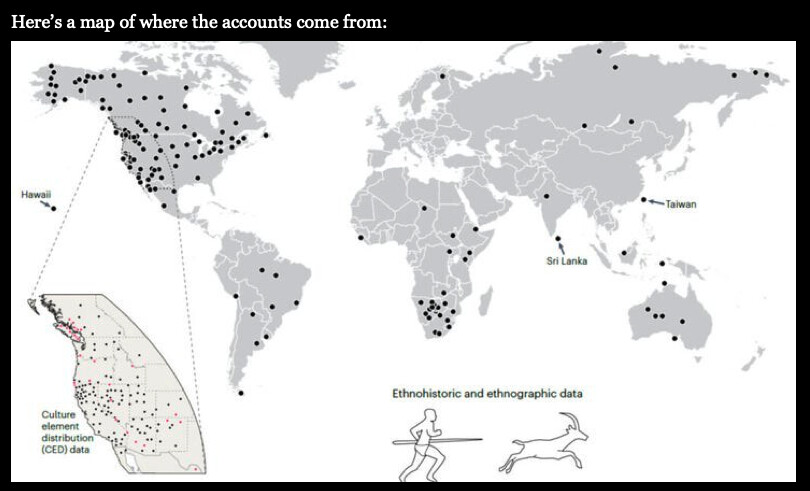
Happily, a new analysis in Nature Human Behaviour counters those criticisms with fresh data, bolstering the case that persistence hunting—and, by extension, running itself—is a key part of our collective history. Eugène Morin of Trent University and Bruce Winterhalder of UC Davis bring together several different lines of evidence to argue that persistence hunting was worth the caloric price, and took place in virtually every corner of the globe—not just on the African savanna, but in dense woodlands, on mountain slopes, and across snow-covered wastelands.David Carrier’s original endurance hunting theory was further fleshed out in 2004 by Daniel Lieberman and Dennis Bramble, then made famous in Christopher McDougall’s 2009 bestseller Born to Run. According to the theory, we have a bunch of traits that make us good long-distance runners. Most importantly, we have lots of efficient and fatigue-resistant slow-twitch muscle fibers in our legs, and we can cool ourselves by sweating from our mostly hairless body surfaces. There’s a long list of other potentially advantageous adaptations, from flexible breathing patterns to long Achilles tendons. These features suggest that our bodies were shaped by evolution to be good at endurance running.
There’s no doubt, though, that running burns more calories than walking to cover a given distance. If you’re tracking an antelope, wouldn’t it make more sense to be patient and stick to walking along its trail? Morin and Winterhalder calculate the return rate for various hunting scenarios, taking into account the calories you’ll burn in the pursuit, the chances of success or failure, and the calories you’ll get from the animal to produce an overall estimate of how many calories per hour each hunting method is “worth.”
Surprisingly, the faster you go, the more rewarding the hunt is. Faster speeds burn more calories per unit time but take less time to catch the animal; the time savings outweigh the extra cost of running. The benefits of ending the hunt sooner are so big that it’s still more efficient to run even if you have to cover twice the distance that you would if you walked.Morin and Winterhalder and their colleagues have done similar calculations for other types of hunting—“encounter” and “communal drive”—and find that the return rates are similar, or in some cases even better for persistence hunts, depending on the context. For example, the persistence hunter has an advantage when the terrain impedes the prey: pursuing game through deep or crusty snow is effective if you’ve got snowshoes or skis. Hot weather also favors humans over animals like deer, which cool themselves by panting, though it’s possible to run them to overheating even in moderate conditions.
All this is interesting but theoretical. How do these numbers translate to real-world behavior? The other part of the study is a new examination of old ethnographic sources that have been digitized in recent years, making them easier to search. The researchers assembled 8,000 publicly available “memoirs, travelogs, missionary accounts” and other documents, and used content analysis software to look for passages where words such as “run down,” “tiring,” “game,” and “animal” occurred close together. Amazingly, they turned up 391 descriptions of persistence hunts dating from the 1500s to the 1900s, occurring on every continent except Antarctica and in a wide variety of different environments and societies.
Most of the previously known accounts of persistence hunting came from hot, open plains in Southern African, the American Southwest, and Australia. The new accounts cover a much broader territory: native Hawaiians “jog-trotting” over rocky terrain until wild goats give up in exhaustion; single unaccompanied Beothuks in Newfoundland running down fat stags; Dayaks in Borneo taking advantage of hot, dry days to catch deer. Around 40 percent of the hunts were in forest, taiga, or rainforest, and another 20 percent were in environments with mixed vegetation.There’s a big gap in southern Eurasia, which is probably because hunter-gatherer societies in those regions were replaced by farmers long before there were written records or curious anthropologists. And there’s a big cluster along the west coast of North America, thanks to a massive ethnographic project undertaken by the University of California in the 1930s and 1940s. This Cultural Element Distribution project systematically surveyed 141 societies in the region; 114 of them, or 81 percent, reported persistence hunting, bolstering the claim that this was a widespread activity rather than a rarity. (In the inset, persistence-hunting societies from this survey are shown with black dots; non-persistence-hunting ones are red dots. If you can see the difference, your eyes are better than mine.)
The upshot of all this data-crunching is a much more robust claim that persistence hunting was a widespread human activity that could well have shaped our evolution. “The emergence of endurance running,” Morin and Winterhalder write, “also informs our predilection for recreational running.” In other words, yes, we were born to run. But don’t feel bad if you read these accounts and think, “Oh man, I’ve been training for all these years and there’s still no way I could run down a deer.” That, too, is a tale as old as time.
“In the old days we used to hunt with the bow and spear,” a Gwich’in elder in northwestern North America lamented in the 1850s. “Our young men were strong in those days. We hunted the moose by running him down on snowshoes, and we could run all day, such as wolves. Now our young men are become lazy and feeble. They prefer to hunt the moose in the fall, when he is easy to kill. They ride on their dog-sleds and are afraid to run all day.”
(06/08/2024) ⚡AMPby Outside online
How to prepare for a marathon, according to official Comrades coach
John Perlman speaks with Lindsey Parry, Official Comrades Marathon Coach.
Running a marathon is a massive task, and far more goes into it than just the actual running.
In the final two days of a race, there are a few things a runner needs to do for the best outcome.
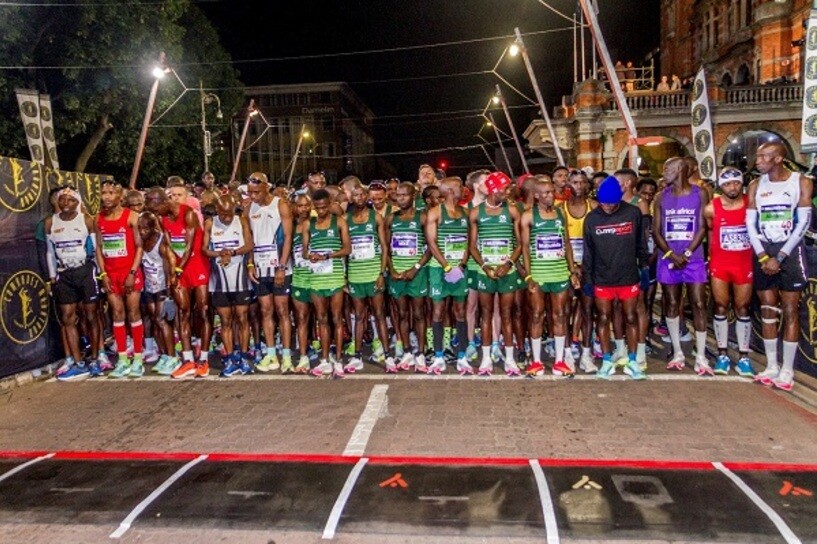
Eat at the right time:
Your biggest main meal leading up to the race should be two nights before the race.
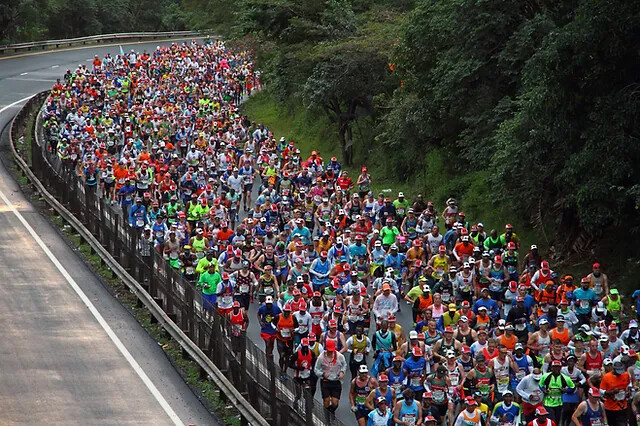
The night before you should not eat anything too heavy.
Get your sleep:
The few nights before running a marathon you should get a full night’s sleep.
Many people will not sleep that well the night before, so Parry says you should be sure to rest well two or three nights before.
“Night two and night three, those are really the nights to try and get yourself a good night’s sleep.”
- Lindsey Parry, Official Comrades Marathon Coach
Make a realistic race plan:
Before you start running you should look at what you have done with previous races or training, and plan accordingly.
This year the first 50km have a significant amount of climbing, so you should be conservative in this time.
Stay positive:
It can be easy to get overwhelmed by bad thoughts, especially if you have recently had a bad run.
Parry says you should just enjoy the day for what it is and focus on the run ahead.
(06/07/2024) ⚡AMPby Keely Goodall
Comrades Marathon
Arguably the greatest ultra marathon in the world where athletes come from all over the world to combine muscle and mental strength to conquer the approx 90kilometers between the cities of Pietermaritzburg and Durban, the event owes its beginnings to the vision of one man, World War I veteran Vic Clapham. A soldier, a dreamer, who had campaigned in East...
more...Five signs that you need new running shoes
Each year, warm weather brings out many new runners to run clubs or to start the sport. When you’re new to any sport, you work with the equipment you have. Running shoes are more than just footwear; they play a pivotal role in helping you become a better runner and chase your goals. Wearing worn-out shoes can lead to discomfort and injury, and can hurt your performance. Here are five dire signs that indicate it’s time to invest in a new pair of running shoes.
1.- They aren’t running shoes
This one may seem straightforward, but after attending a few run clubs, I’m amazed at how many individuals still run in worn-out skateboarding shoes or cheap trainers. Compared to other sports, running has a low entry cost. Even if you aren’t sure what you’re looking for, ask around or drop in to your local running store. You can tell them your goals, and the staff will recommend a few options for you to try out.
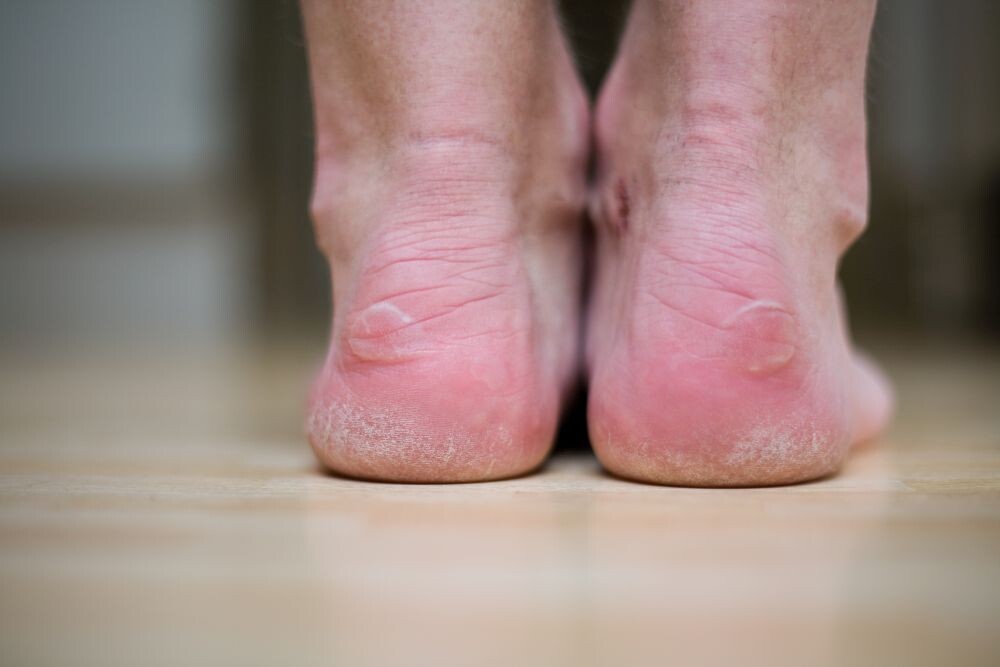
2.- Shin splints
Your running shoes should be the most comfortable pair of shoes you own. If you start experiencing shin splints or any pain or discomfort in your feet, it’s a sign that your shoes aren’t providing adequate support, or they may not be right type of running shoes for you. The foam in running shoes deteriorates over time (even if you aren’t using them for running), leading to less shock absorption and more stress on your joints and muscles.
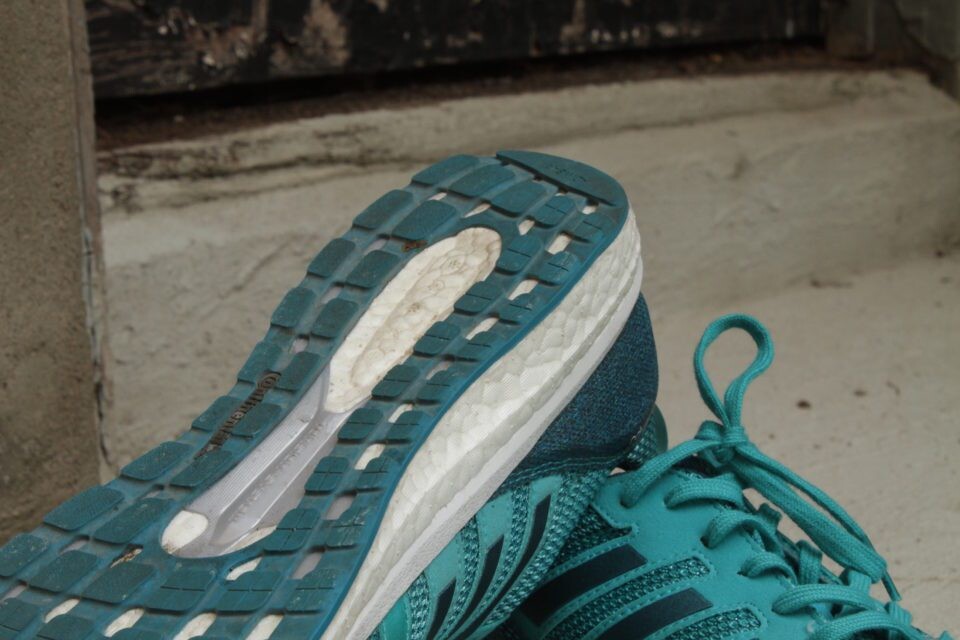
3.- Worn-out soles
The most obvious sign you need to buy new running shoes is visible wear and tear on the outsole. Examine the soles of your shoes for uneven wear patterns, which can indicate that the cushioning and support are compromised. The outsole is designed to provide grip and stability, but over time it can wear down and become flat, particularly in high-impact areas like the heel and forefoot. A flattened outsole not only reduces traction, but also affects the overall structure and support of the shoe. If your shoe’s outsole is noticeably worn and smooth, it’s a clear indication you need a new pair. On average, a new pair of running shoes should last between 400 and 700 kilometers.
4.- Frequent blisters
If you are getting nonstop blisters every time you run, getting fitted for a new pair of shoes is a quick fix. Blisters indicate that your current shoes do not fit properly, are too old or aren’t meant for your foot type and running style. Shoes that are too tight, too loose or have a shape that doesn’t match your foot can cause friction, which leads to blisters. You need to get fitted at a running specialty store for a new pair of shoes.
5.- Compressed cushioning
A critical function of every running shoe is to provide cushioning for your landings. Over time, the foam in the midsole compresses and loses its ability to rebound and provide adequate support. Even if you aren’t tracking the miles in the shoes, there’s still a way to test if they are worn out. Put your hand inside the shoe and push against the midsole, with your other hand on the bottom of the outsole. If it feels hard or you can feel the force of your hand, it’s a sign that the cushioning is worn out. The pounding of your body weight against the ground is a lot more force than your hand, so if you can feel anything, it’s a clear-cut sign the shoes need to be replaced. Continuing to run on compressed cushioning can lead to increased fatigue and possible injury.
(06/07/2024) ⚡AMPby Marley Dickinson
Daniel Mateiko explains why teaming up with Nicholas Kimeli guarantees Kenya an Olympic medal
Daniel Mateiko has given a reason why he believes teaming up with Nicholas Kimeli will earn Kenya the coveted gold medal.
The reigning Ras Al Khaimah Half Marathon champion Daniel Mateiko has explained why teaming up with Nicholas Kimeli guarantees Team Kenya an Olympic medal in the men’s 10,000m.
Mateiko and Kimeli got direct Olympic qualification following their impressive runs at the Prefontaine Classic, the Diamond League Meeting in Eugene, which also served as the Kenyan trials for the 10,000m.
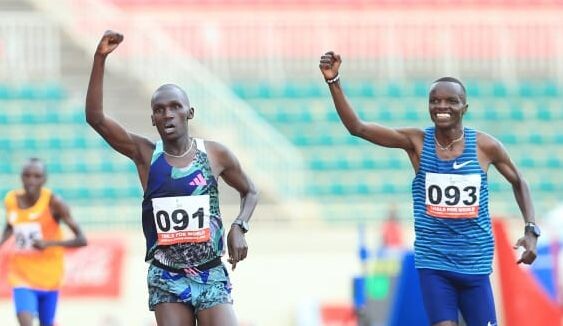
The 25-year-old clocked a stunning world leading and personal best time of 26:50.81 to win the race as Kimeli finished second in a personal best time of 26:50.94. The third participant will be selected by a panel of selectors.
The 2022 Antrim Coast Half Marathon champion noted that he trains with Kimeli, something that places them at a greater level of winning the gold medal that was last won during the 1986 Olympic Games by Naftali Temu.
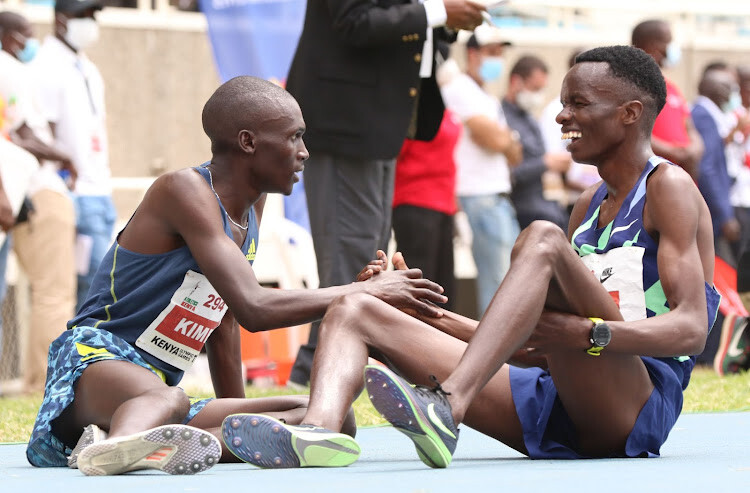
“Firstly, Kimeli and I train together, so I think we make a great team since we have been training together and we are going to Paris together, so we shall do well. It’s all about working on the confidence and believing in yourself that you can win.
“Actually, my journey in athletics has had ups and downs, sometimes you fail sometimes you succeed. Both of them are important in my career because when you fail, you grow,” he said.
The Kenyan also insisted that he will not change any of his training techniques in the build up to the global bonanza. He admitted that training with some of the greatest long-distance runners including Eliud Kipchoge and Geoffrey Kamworor has helped him gain confidence and helped him learn a lot of skills.
“I believe my preparation will be good and I have no plans of changing any program that I have been doing so I go and do my best there. I hope to do my best.
“It’s a great motivation for me to be training with great athletes like Eliud Kipchoge and Geoffrey Kamworor and I have learnt a lot of tactics and resilience from them,” Mateiko said.
(06/07/2024) ⚡AMPby Abigael Wuafula
Paris 2024 Olympic Games
For this historic event, the City of Light is thinking big! Visitors will be able to watch events at top sporting venues in Paris and the Paris region, as well as at emblematic monuments in the capital visited by several millions of tourists each year. The promise of exceptional moments to experience in an exceptional setting! A great way to...
more...Three workouts to rev up any race pace
Whether you’re hoping to maximize your mile pace or prepping for a fall marathon, these speedwork sessions are for you. Dr. Andrew Reheisse, a Salt Lake City-based chiropractor and running coach, suggests adding one of these speed-boosting sessions to your training regime once a week. These workouts are based around your mile pace for your goal race distance—if you calculate your running pace in kilometres, just multiply it by 1.6. For these workouts, you’ll be gearing up to 30 seconds to one minute faster than goal mile pace.
Reheisse explains that as you progress, you can extend the intervals so that you’re comfortably covering longer distances at tempo pace.
1.- 200m repeats
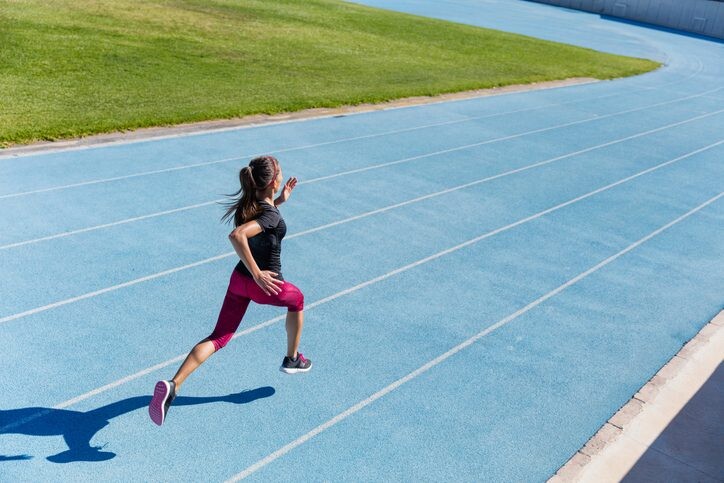
For these intervals, you’re aiming to run a minute or faster than your goal (mile) race pace for the interval. Tweak the number of sets to prep for any distance: for a 5-10K race, run 2-3 sets, for a half-marathon, aim for 3-4 and for a marathon, bump it up to 5 or 6. This workout is easiest on a track, where 4 laps equal 1 mile.
Warm up with a mile of easy jogging and some dynamic drills, like these.
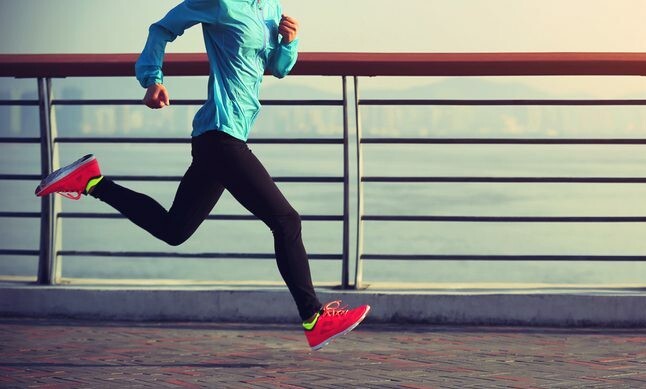
Run 4 x 200m with a 200m jog between reps; take a 400m jog between sets.
Cool down with a mile of easy running.
2.- Speedy fartlek fun
“In this workout we play around with our speed at different intervals of time, says Reheisse. “I outlined a common workout I do, but it can really be any amount of short bursts.”
Warm up with 1 mile of easy running and 5 minutes of dynamic drills. Start with 3 sets of this workout at 1 minute faster than race pace to get a feel for it—add more sets when you feel ready.
Run 3 sets of 40 seconds, 30 seconds and 20 seconds, with recovery time equalling interval time (40 seconds of speed work followed by 40 seconds of recovery, 30 seconds fast running followed by 30 seconds recovery, etc.).Take 2 minutes of easy recovery running.Run 1 minute, 1 minute 30 seconds, 1 minute, with recovery time equalling interval time (1 minute interval followed by 1 minute of easy running).Take 2 minutes of very easy running to recover.Run 3 sets of 40 seconds, 30 seconds and 20 seconds, with recovery time equalling interval time.
Cool down with a mile of easy running.
3.- Yo-yo intervals
“These are necessary to turn your newfound speed into a sustainable pace during a race, explains Reheisse. “Performing repeat miles or 800s, or yo-yo-ing back and forth in this workout, you will still be running faster than your goal pace.” Reheisse suggests aiming for 15-30 seconds faster than goal pace on the mile repeats, and 45 seconds to 1 minute faster in the 800s. “As you progress, it will be the rest period that gets shorter, so that it becomes more race-like.
Warm up with a one-mile jog and 5 minutes of dynamic drills. This example workout is designed for a 8:00/mile goal race pace. Take 2-3 minutes of recovery running between each interval to start; lower to 1-1.5 minutes as your fitness progresses.
Run 800m with a goal time of 3:30.Run 1 mile with a goal time of 7:30-7:40.Run 800m with a goal time of 3:30.Run 1 mile with a goal time of 7:30-7:40.Run 800m with a goal time of 3:30.Cool down with an easy one-mile run.
Remember to hydrate well during speedwork sessions (and all training sessions) and follow a harder training day with a day of very easy running or complete rest.
(06/07/2024) ⚡AMPby Keeley Milne
David Rudisha explains why he never switched to a longer distance in his prime years
David Rudisha has explained why he could never dare to compete in a longer distance than the 800m.
World 800m record holder David Rudisha has disclosed why he could never dare to run a longer distance than the 800m.
Most 800m runners love blending the two-lap race with the 1500m but Rudisha opted to scale down to the 400m and he admitted that it worked perfectly for him.
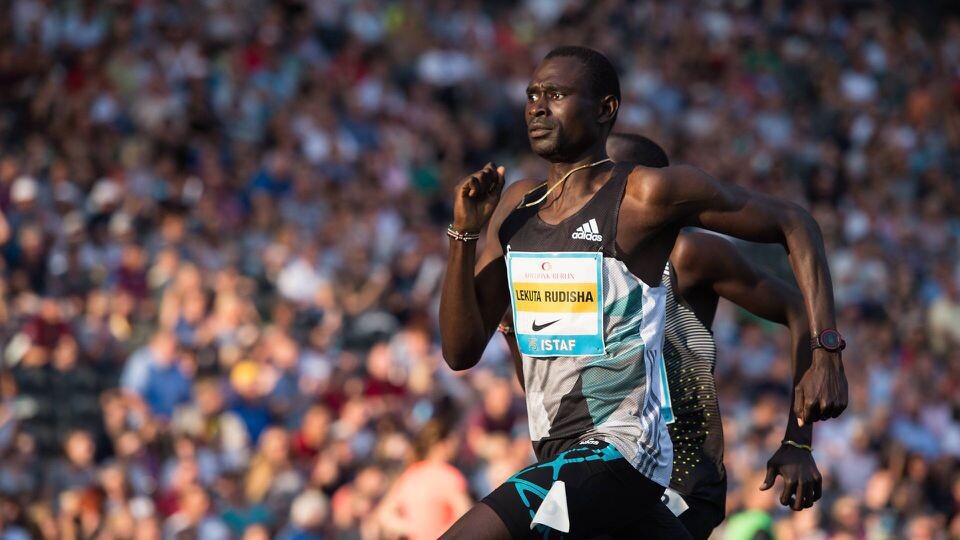
In Kenya, Emmanuel Wanyonyi is one of the athletes who does the 800m and combines it with longer distances but reigning world 800m champion Mary Moraa is more of Rudisha’s type. Moraa is always known to compete in the 400m and 600m and she rarely makes appearances in the longer distances.
“If you see 800m runners, you find that some are doing 800m and others can move to 1500m and 5000m. However, others can only move to the 400m and I believe I’m the one who could only do the 400m.
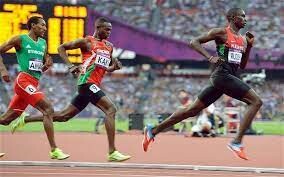
“Even during my training days, I wasn’t doing so well with the endurance and I would struggle a lot. I wasn’t kind of a longer-distance athlete and at some point, at the beginning of the season, my coach would tell me to do 800m and 600m races.
“However, I never liked that because it was tough. During training, I would usually do maybe one 600m race and then go down to 200m or 400m and then the 300m, the one that I loved,” Rudisha said in an interview with World Athletics.
Speaking about his world record at the 2012 London Olympics, Rudisha disclosed that he had worked towards achieving that goal for years.
The two-time Olympic champion was only making his debut at the Olympics and deep down, he knew there was no chance of making mistakes. He explained that his team had worked around the clock and refined the finer things in his training and he was confident of running something special.
However, the two-time world champion noted that it was not an easy thing but he knew if he missed that chance, he would have to wait for four more years to make history.
“London 2012 was my first Olympic Games and as I was training, way back, my coach used to emphasise and he would say we would be in the Olympics and that got into my mind. Over five, six, seven, or eight years, I was focusing on the Olympics.
“Going there was very special and we did very good preparation to make it happen since you can’t make mistakes at the Olympics. I knew that I had a better chance and I was still in the peak of my career and we did very good training.
“At the beginning of the season, I did like two races in New York and Paris and I did 1:41, and going to London, I knew it wasn’t easy. I made my plans and knew that if I executed the race well, I would win the 800m and because I was a front runner, it would be easier for me,” Rudisha said.
(06/07/2024) ⚡AMPby Abigael Wuafula
Netflix’s track and field series, Sprint, to be released on July 2
We are 50 days from the start of the 2024 Paris Olympics, and if you aren’t excited about it yet, maybe this news will help. On Wednesday, Box To Box Films announced that their documentary series Sprint, focused on following the world’s top 100m and 200m sprinters, will be coming to Netflix on July 2.
Sprint will follow the journey of several elite sprinters, including world champions Noah Lyles, Sha’Carri Richardson, Fred Kerley and Dina Asher-Smith, providing a behind-the-scenes glimpse into their world of track and field.
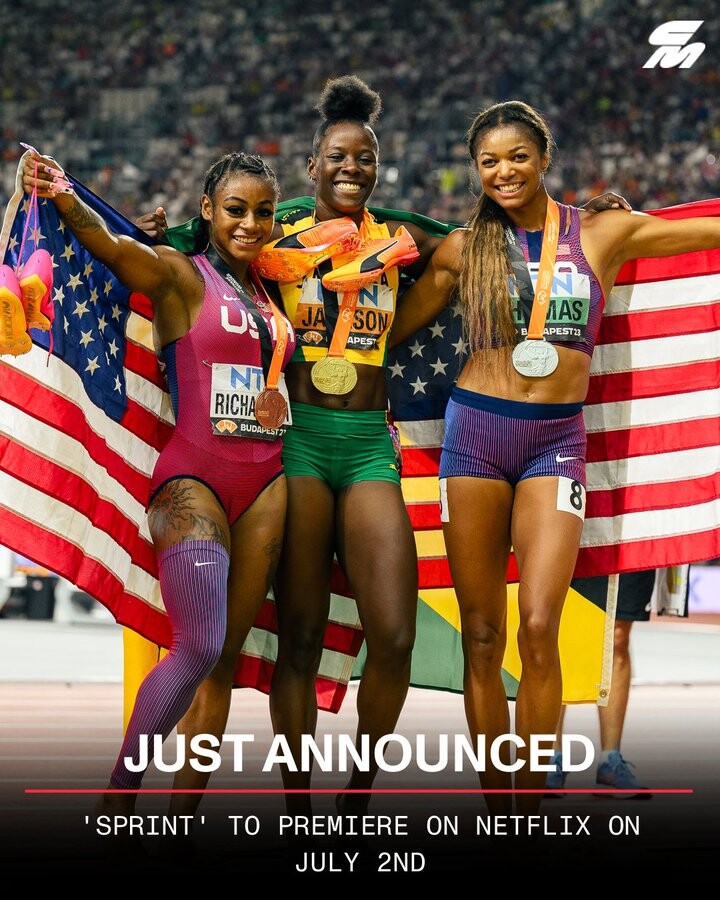
The series takes place over the summer 2023 season and captures the thrilling moments from the Diamond League and Continental Tour, with the final episodes taking place at the 2023 World Championships in Budapest, where Lyles won double gold in the 100m and 200m–the first athlete to do so at a world championship since Jamaica’s Usain Bolt in 2015.
Despite being the only track and field athlete to win six sprint medals at the last two Olympic Games, Canada’s Andre De Grasse is not one of the athletes featured in the series.
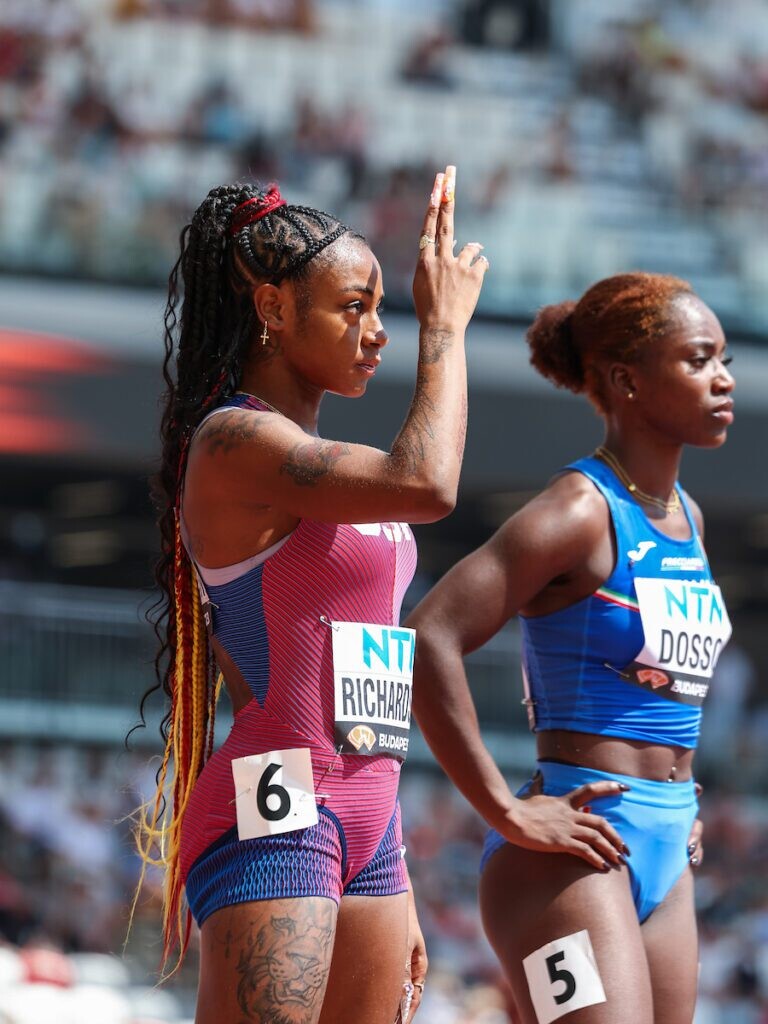
Box To Box Films is the same company behind the Formula One racing series Drive To Survive, the golf series Full Swing and the pro tennis series Break Point.
These series have resonated with existing fans and attracted new audiences to the respective sports. World Athletics hopes Sprint will have the same effect in the lead-up to the Paris Olympics.
If you are a Netflix account holder, you can search for Sprint now on the app, set a reminder and add it to your watch list. This is a series we will most definitely be bingeing, come July 2.
(06/06/2024) ⚡AMPby Marley Dickinson
Timothy Cheruiyot reveals struggles with injuries and overcoming challenges as he chases Olympic glory
Former world 1500m champion Timothy Cheruiyot has opened up on his struggles with injuries and his comeback plan to the top of the men's 1500m.
Olympic silver medallist Timothy Cheruiyot has opened up about his injury bout that saw him struggle to produce great results since the 2022 World Championships in Eugene, Oregon.
Cheruiyot, a former world champion, explained that he had been through a tough time with his injury and explained that he had a torn knee which cost him a lot in terms of training and performing well.
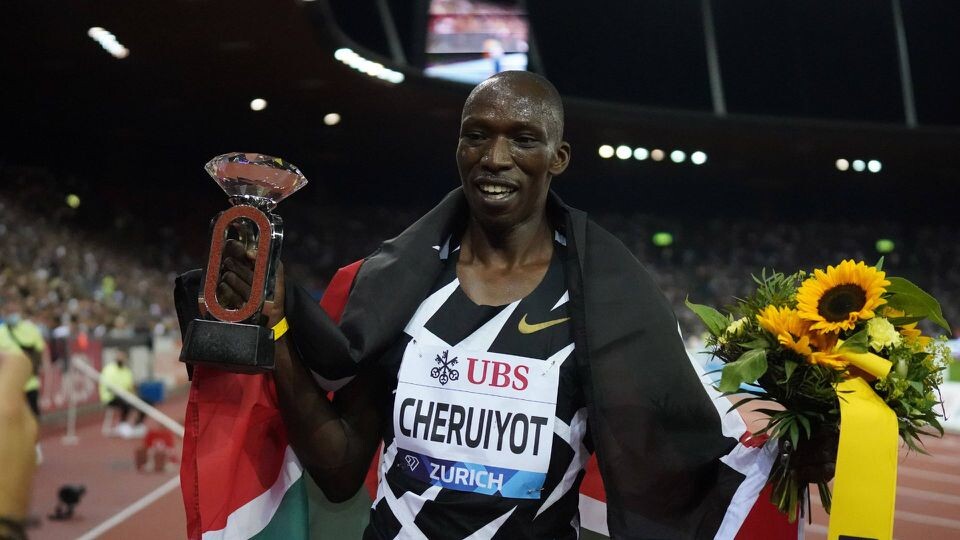
He was a favourite at the 2022 World Championships but failed to live up to the billing, finishing sixth in the final of the 1500m before proceeding to a second-place finish at the Commonwealth Games in Birmingham.
Last season, Cheruiyot had a bitter exit from the World Championships in Budapest, Hungary, where he was eliminated in the semifinal of the race. He explained that the injury has been a nightmare to him but appreciated his management and coach Bernard Ouma for walking with him during the difficult period.

“It was a bit hard because sometimes when an athlete has an injury, it’s a bit of a problem but for me, I thank my management and my coach for coming together and finding a good physiotherapist and a great rehab.
“At the moment I’m very happy to be back…it was hard because I had a torn knee and I’m happy to have come back and I’m training well now,” Cheruiyot said.
This season, the 28-year-old has been in great shape, and has competed in Diamond League Meetings and local races as he eyes the Olympic trials.
He was in action at the Diamond League Meeting in Doha, finishing second behind Brian Komen before almost upsetting Jakob Ingebrigtsen on home soil, at the Diamond League Meeting in Oslo.
Cheruiyot was also in action at the trials for the Africa Senior Athletics Championships, where he doubled in the 800m and 1500m and finished third and fifth respectively.
He has assured his fans of being fully back and will be keen to go back and take his rightful position as one of the greatest 1500m runners the world has ever known.
(06/06/2024) ⚡AMPby Abigael Wuafula
U.S. Olympic Team Trials Track And Field
Eugene, Oregon has been awarded the 2024 U.S. Olympic Team Trials - Track & Field, USA Track & Field and the U.S. Olympic & Paralympic Committee announced today. From June 21 to 30, Hayward Field at the University of Oregon will be home to one of the biggest track and field competitions in the country, as the U.S. Olympic Team...
more...Treadmill desks are becoming more popular—but do they help your running performance?
We all know that exercise has a multitude of benefits, and sitting at a desk all day can take a toll on our mental and physical health. It can be hard to get out for a run sometimes, let alone get in our daily step count. Could a treadmill desk be the answer?
Prolonged inactivity is known to increase the risk of heart disease, Type 2 diabetes and other health issues, with the adage “sitting is the new smoking” underscoring the dangers of a sedentary lifestyle. Conversely, walking as few as 4,000 steps a day has been shown to benefit both mind and body. Treadmill desks, which combine a standing desk with a treadmill, offer a potential solution to counteract sedentary office environments, The New York Times recently reported. But are they a worthwhile investment for runners?
Are they effective?
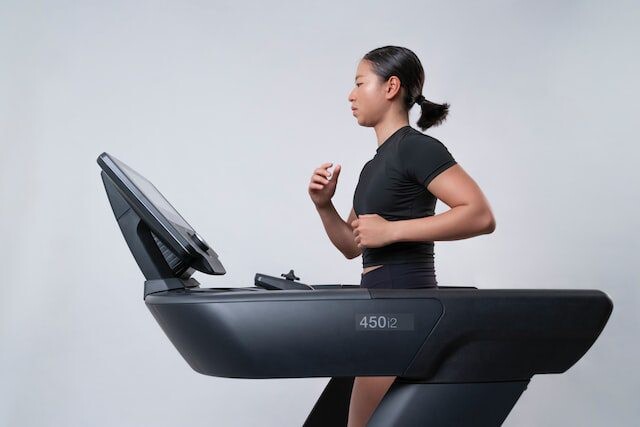
As treadmill desks become more popular, researchers are examining their efficacy. Studies, though sometimes limited in scope, indicate that treadmill desks can help people stay active, potentially adding an average of two extra miles of walking per day. A 2023 study even found that regular use of treadmill desks increased energy levels, improved mood, and in some cases, enhanced job productivity.
Akinkunle Oye-Somefun, a doctoral candidate at Toronto’s York University and lead author of a recent meta-analysis on treadmill-desk research, says that adding small amounts of activity throughout the day can accumulate. He cautions: “walking on a treadmill desk is a supplement, not a replacement for your regular exercise routine.” In other words—while a treadmill desk may boost training by enhancing your mood and adding to time spent on your feet, it’s not a replacement for your regular running routine.
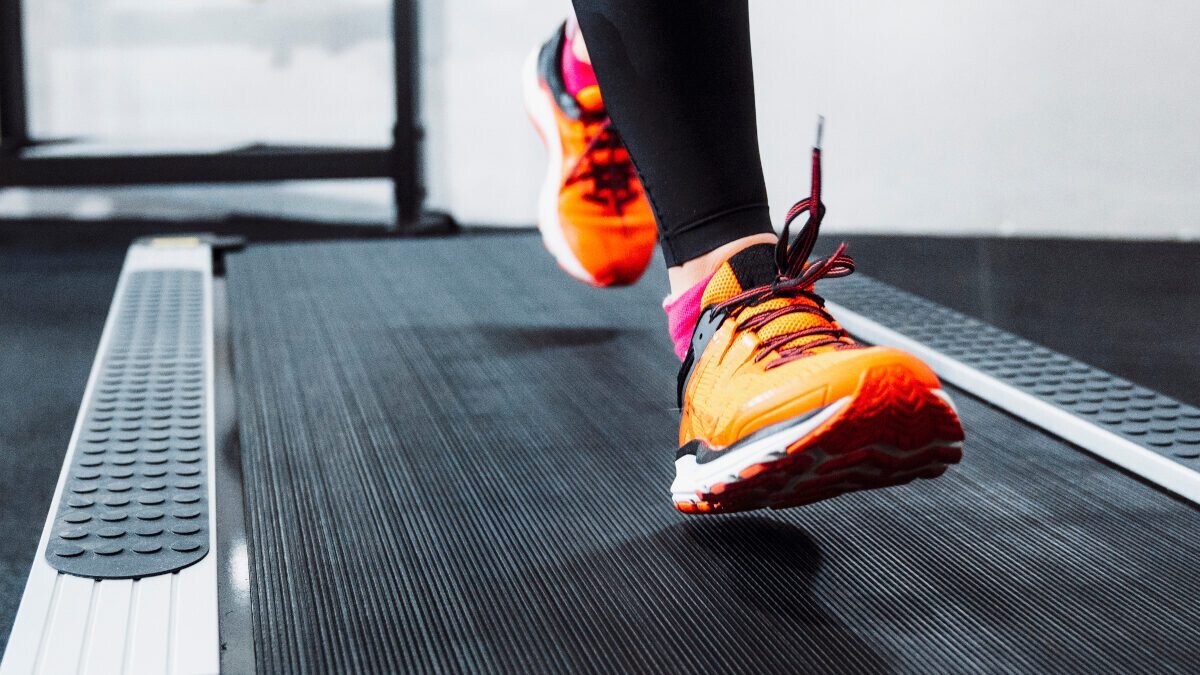
Be mindful of cost
While treadmill desks can increase daily movement, they come with potential drawbacks. Noise is a significant issue, especially with standard running treadmills—the motor and the sound of footsteps can make it difficult to concentrate, both for the user and their co-workers. Quieter models tend to be more expensive, with treadmills and walking pads running from $280 to $1,400.
Taking those Zoom meetings can be a little challenging if you’re trying to speedwalk, and fine motor skills take a hit: Jenna Scisco, an associate professor of psychology at Eastern Connecticut State University and lead author of a 2023 study on treadmill desks, found that typing becomes more challenging while walking. Despite this, she noted that the health benefits often outweigh these drawbacks.
Build a consistent routine
Let’s face it—a walking desk won’t help you race to your next PB… directly. However, building a daily routine of getting more consistent exercise will make you fitter, and you may find yourself pushing through distance and effort barriers with more ease. While adding a lunchtime walk is still a good option if you’re limited by cost or office dynamics, establishing a regular routine on a treadmill desk can be an effective way to add more movement to your day. Experts suggest starting small, with 30-minute increments, before spending longer periods of your work day moving your legs.
(06/06/2024) ⚡AMPby Keeley Milne
Husband and wife Mudzinganyama, Tshuma aim to ‘Givemore’ at Comrades Marathon
While the Comrades Marathon has produced sibling champions in the past, there is yet to be husband-and-wife winners of the Ultimate Human Race.
Russian twin sisters Elena and Olesya Nurgalieva dominated the race in the early 2000s, with the former winning the race eight times, while the latter was victorious just once.
South African brothers Andrew (2001) and Gift Kelehe (2015) are the other siblings to have conquered the about-90km race run between Durban and Pietermaritzburg.

This year’s race will see a married couple making their debut, with the husband and wife sure to start among the contenders.
Last year’s Two Oceans Marathon champion Givemore Mudzinganyama, who was third in this year’s edition, and his wife Nobuhle Tshuma – fourth in the Two Oceans in 2023 – will line up at the Durban City Hall on Sunday morning intent on making history.
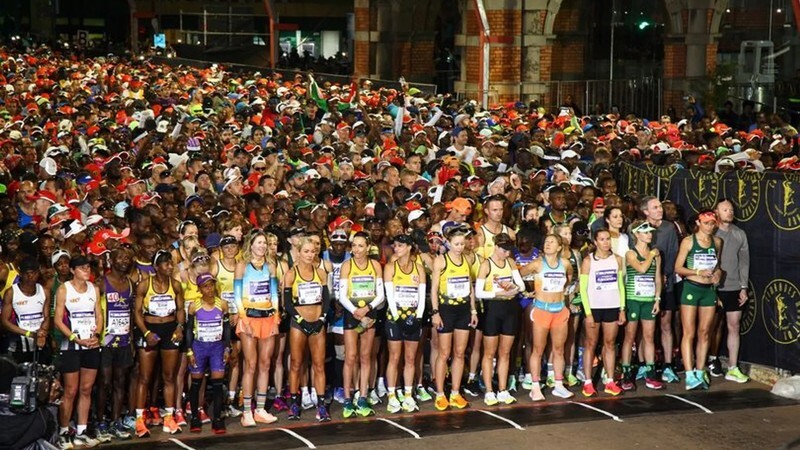
The couple that runs for Entsika Athletics Club are confident of getting into the top-10 gold medal positions.
But being the ambitious athletes they are, they will have victory in mind when the starting gun sends the runners off towards Scottsville Racecourse.
Somewhat opposites, as most couples tend to be, Tshuma is very extroverted and outspoken, while Mudzinganyama is somewhat shy – although not on the road.
(06/06/2024) ⚡AMPby Matshelane Mamabolo MERCURY SPORT Husband and wife Mudzinganyama, Tshuma aim to ‘Givemore’ at Comrades Marathon
Comrades Marathon
Arguably the greatest ultra marathon in the world where athletes come from all over the world to combine muscle and mental strength to conquer the approx 90kilometers between the cities of Pietermaritzburg and Durban, the event owes its beginnings to the vision of one man, World War I veteran Vic Clapham. A soldier, a dreamer, who had campaigned in East...
more...Boston Athletic Association unveils revised unicorn logo for Boston Marathon
On the occasion of Global Running Day, the Boston Athletic Association is unveiling a revised version of its iconic unicorn logo.
B.A.A. officials said the new logo is intended to be a forward-facing and athletic symbol of the organization's future.
"Between our mass participatory events and our support of philanthropic organizations, we aim to spearhead continued growth and enthusiasm around the sport of running while supporting those around us," said Jack Fleming, B.A.A. President and CEO.
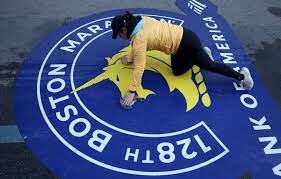
Elements of the new logo include:
Facing forward, the emblem eyes the future and many miles ahead.

Spike’s jawline is enhanced, demonstrating the athletic and gritty nature of Boston.
With alert and focused eyes, Spike is determined to conquer the challenging Boston Marathon course.
Pointing northeast, Spike’s horn represents the direction of the Marathon route on a compass from start to finish.
The flowing mane shows swift movement on the pursuit of a healthy and active lifestyle – directly tied to the B.A.A.’s mission.
The new base of the unicorn showcases two sides coming together, the merging of the B.A.A.’s history and future.
Within Spike’s neck is a gap between two lines, symbolic of breaking the champion’s tape at the finish line.
13 points are on the mane, one for each decade of B.A.A. heritage.
B.A.A. officials said the finish line on Boylston Street is being repainted Wednesday to feature the updated logo.
WCVB is the official broadcast partner of the B.A.A. and the Boston Marathon.
(06/05/2024) ⚡AMPby Phil Tenser
Boston Marathon
Among the nation’s oldest athletic clubs, the B.A.A. was established in 1887, and, in 1896, more than half of the U.S. Olympic Team at the first modern games was composed of B.A.A. club members. The Olympic Games provided the inspiration for the first Boston Marathon, which culminated the B.A.A. Games on April 19, 1897. John J. McDermott emerged from a...
more...World 10km record holder Rhonex Kipruto handed six-year doping ban
Rhonex Kipruto is the latest Kenyan athlete to be disgraced over doping as he has been handed a six-year suspension with his big achievements quashed.
Kenya's Rhonex Kipruto has been banned for six years over a doping offence, adding to the grim statistics for the country.
Athletics Integrity Unit (AIU) handed the punishment to the 24-year-old on Wednesday, meaning he will lose his 10 kilometres road race world record and a World Championships bronze medal.
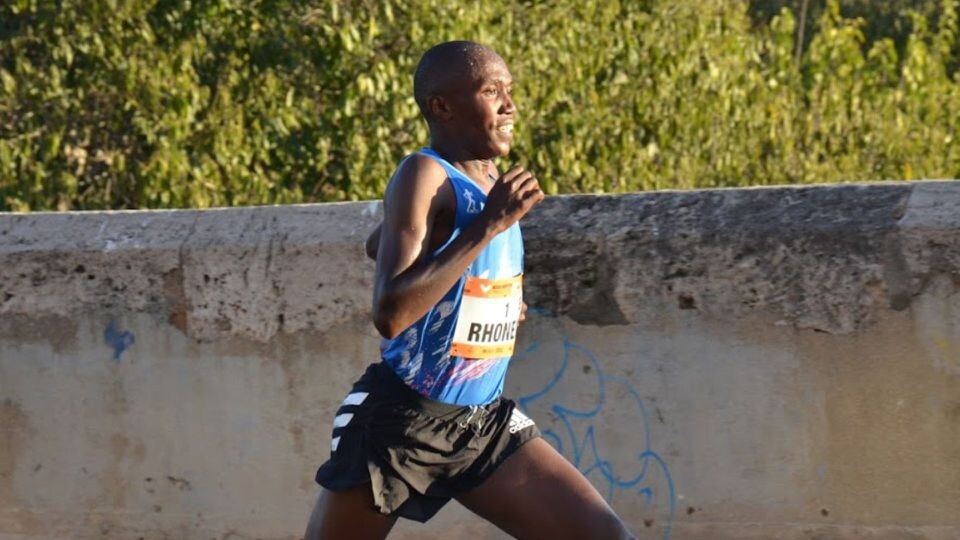
Kipruto, who won the 10,000 metres bronze in the 2019 World Championships in Doha, had been provisionally suspended for an anti-doping violation in May last year and is now banned until May 2029.
Kipruto broke the 10km road race world record in 2020 in Valencia and won the 10,000 metres at the 2019 Stockholm Diamond League, achievements that are now null and void.
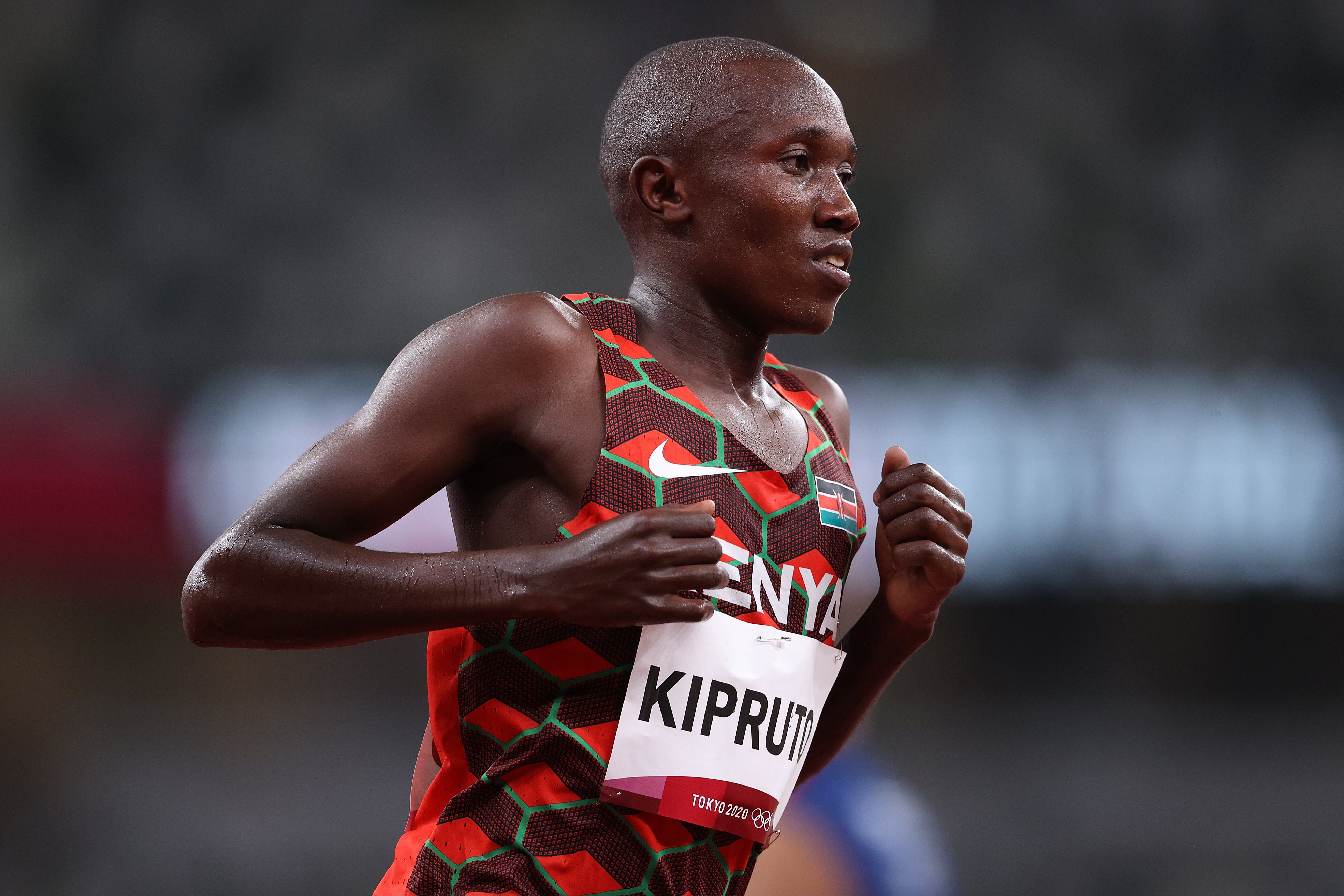
A Disciplinary Tribunal ruled that there were irregularities in Kipruto's Athlete Biological Passport (ABP), which shows discrepancies that can reveal the effects of doping.
"The Tribunal rejected Kipruto's defence, concluding the 'cause for the abnormalities in the ABP is more likely to be due to blood manipulation' such as through the use of recombinant human erythropoietin (rEPO)," AIU said its ruling, adding that there was no other plausible explanation for the abnormal values.
Kipruto had denied the Anti-Doping Rule Violation (ADRV) charge but the panel said it was "comfortably satisfied" that the Kenyan was involved in a "deliberate and sophisticated doping regime over a long period of time".
Kipruto can still appeal to the Court of Arbitration for Sport.
The disgraced long-distance athlete joins a long list of Kenyan runners who have been suspended over various doping offences.
His suspension comes just a day after the Anti-Doping Agency of Kenya suspended 33 sportsmen and women for failing doping tests.
(06/05/2024) ⚡AMPby Joel Omotto
What is the meaning of Global Running Day? Inspirational quotes for runners
At its core, Global Running Day is about community and solidarity. It's a day when runners from all corners of the world come together
Global Running Day, celebrated annually on the first Wednesday of June, is a worldwide celebration of running that encouragespeople of all ages and abilities to get moving. It is a day to recognize the positive impact running has on physical and mental health, as well as the sense of community it fosters.
The initiative, led by the New York Road Runners (NYRR), aims to inspire people to lace up their shoes and experience the joy of running. Whether it’s a short jog around the block or a longer distance, Global Running Day welcomes everyone to participate and embrace a healthier lifestyle.
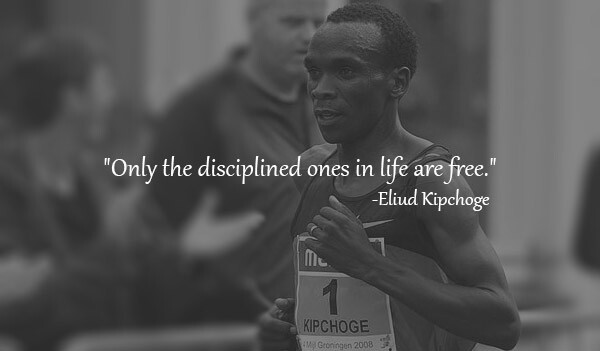
The day serves as a reminder of the many benefits associated with running, including improved cardiovascular health, increased energy levels, stress reduction, and enhanced mood. It also promotes the social aspect of running, encouraging people to connect with others through group runs, races, or virtual challenges.
The Spirit of Togetherness
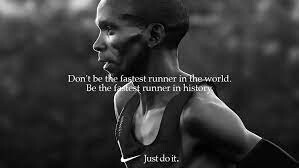
At its core, Global Running Day is about community and solidarity. It’s a day when runners from all corners of the world come together, not just to run but to share their stories, goals, and experiences.
Whether you’re a seasoned marathoner or a beginner taking your first steps into the world of running, Global Running Day welcomes you. The inclusive nature of this celebration fosters a sense of belonging, reminding us that running is a universal language that transcends borders and cultures.
Promoting Health and Wellness
Running is one of the simplest yet most effective ways to maintain physical and mental health. Global Running Day serves as a reminder of the numerous benefits of running, from improved cardiovascular health and stronger muscles to reduced stress and enhanced mood. By encouraging people to participate in this activity, the event aims to inspire healthier lifestyles and promote the importance of regular exercise.
Inspiring Future Generations
Global Running Day is much more than a date on the calendar; it’s a movement that encapsulates the joy, community, and benefits of running.
It’s a day to celebrate the collective love for running, inspire new runners, and promote health and wellness across the globe. As we lace up our shoes and hit the road, we’re reminded that every step we take brings us closer together, creating a healthier, happier world. So, whether you’re running alone, with friends, or as part of a larger event, take a moment to appreciate what Global Running Day means to you and the global community of runners.
The best quotes from Eliud Kipchoge
Eliud Kipchoge is an inspiration for runners. The double Olympic champion in the Marathon (Rio 2016 and Tokyo 2020) is also the only human to have run the 42.195 kilometers in less than two hours. He also holds the world record for the Marathon with a time of 2:01:39, which he achieved in Berlin.
Kipchoge is an athlete born in Kenya. Running comes naturally to him; he has been doing it since he was a child when he had to run 8 kilometers to get to school and another 8 kilometers to return home.
Besides having a technique that can be considered perfect, Eliud Kipchoge has managed to convey to runners around the world the joy of running and the importance of the mental factor.
Here are some phrases from Kipchoge and some other runners, which are an inspiration to celebrate this Runner’s Day 2022 together.
“Humans have no limits; they can achieve whatever they set their minds to. You must think beyond your own limits, run against the unthinkable.” – Eliud Kipchoge
“Athletics is not so much about the legs. It’s about the heart and mind.” – Eliud Kipchoge
“Only the disciplined in life are free. If you are undisciplined, you are a slave to your moods and passions.” – Eliud Kipchoge
“There are no secrets in my training. What is truly crucial is believing that progress is possible… believing that you can do anything.” – Eliud Kipchoge
“The ability to achieve your goals is not possible without hard work and self-confidence.” – Eliud Kipchoge
“I always aim to give my best until I reach the finish line.” – Eliud Kipchoge
“Never stop running for fun.” – Eliud Kipchoge
“Passion is a choice. You have to choose to be great. It’s not an opportunity; it’s a choice.” – Eliud Kipchoge
“When you feel pain, try to forget that pain. The only way to achieve this is by smiling, being happy, and enjoying running.” – Eliud Kipchoge
“Marathon is life. And life is where you progress.” – Eliud Kipchoge.
(06/05/2024) ⚡AMPby Laura Islas
Global Running Day
What is Global Running Day? Global Running Day is a worldwide celebration of running that encourages everyone to get moving. It doesn’t matter how fast you run or how far you go—what’s important is that you take part, and how you do it is up to you. Run a lap around your block, take your dog for a long walk,...
more...World Athletics Adds Ranking Spots to Olympic Men’s Marathon Field — American Leonard Korir Will Run in Paris
The United States will have three men in the 2024 Olympic marathon after all. Following months of uncertainty, World Athletics added one universality place and four rankings places to the Olympic marathon field on Tuesday. The four ranking spots were awarded to athletes from Chile, South Africa, the United States, and Australia, meaning that Leonard Korir will join Americans Conner Mantz and Clayton Young on the Olympic marathon start line on August 10.
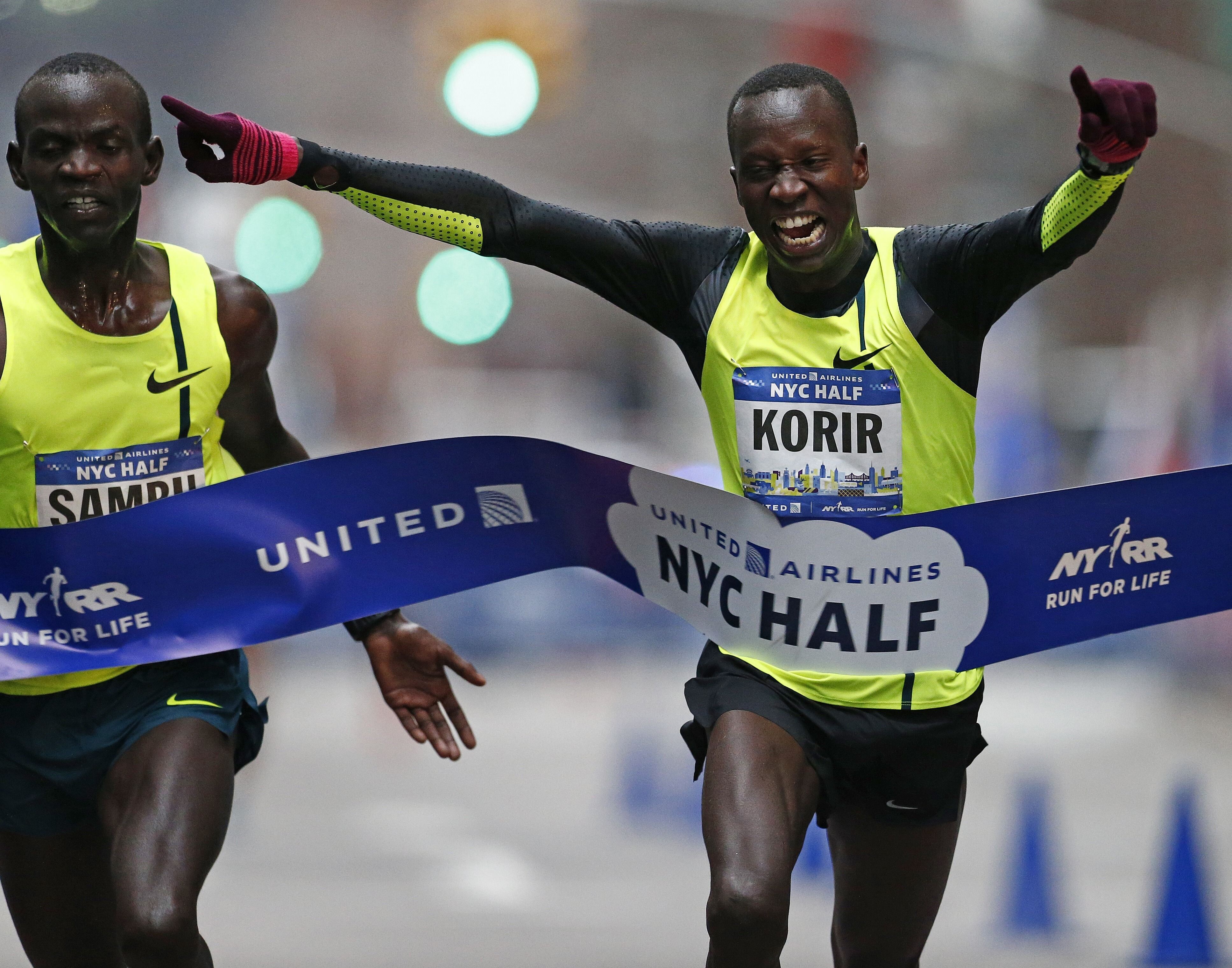
Korir’s spot had been in jeopardy after World Athletics added 11 universality places on May 8, but the Road to Paris list of qualifed athletes has been updated and American CJ Albertson is now listed as qualified at spot #84. Per USATF selection procedures, Albertson’s place will pass to Korir, the third-placer at February’s US Olympic Marathon Trials. Korir’s coach Scott Simmons confirmed to LetsRun.com that Korir is now qualified and will compete in the Olympic marathon on August 10.
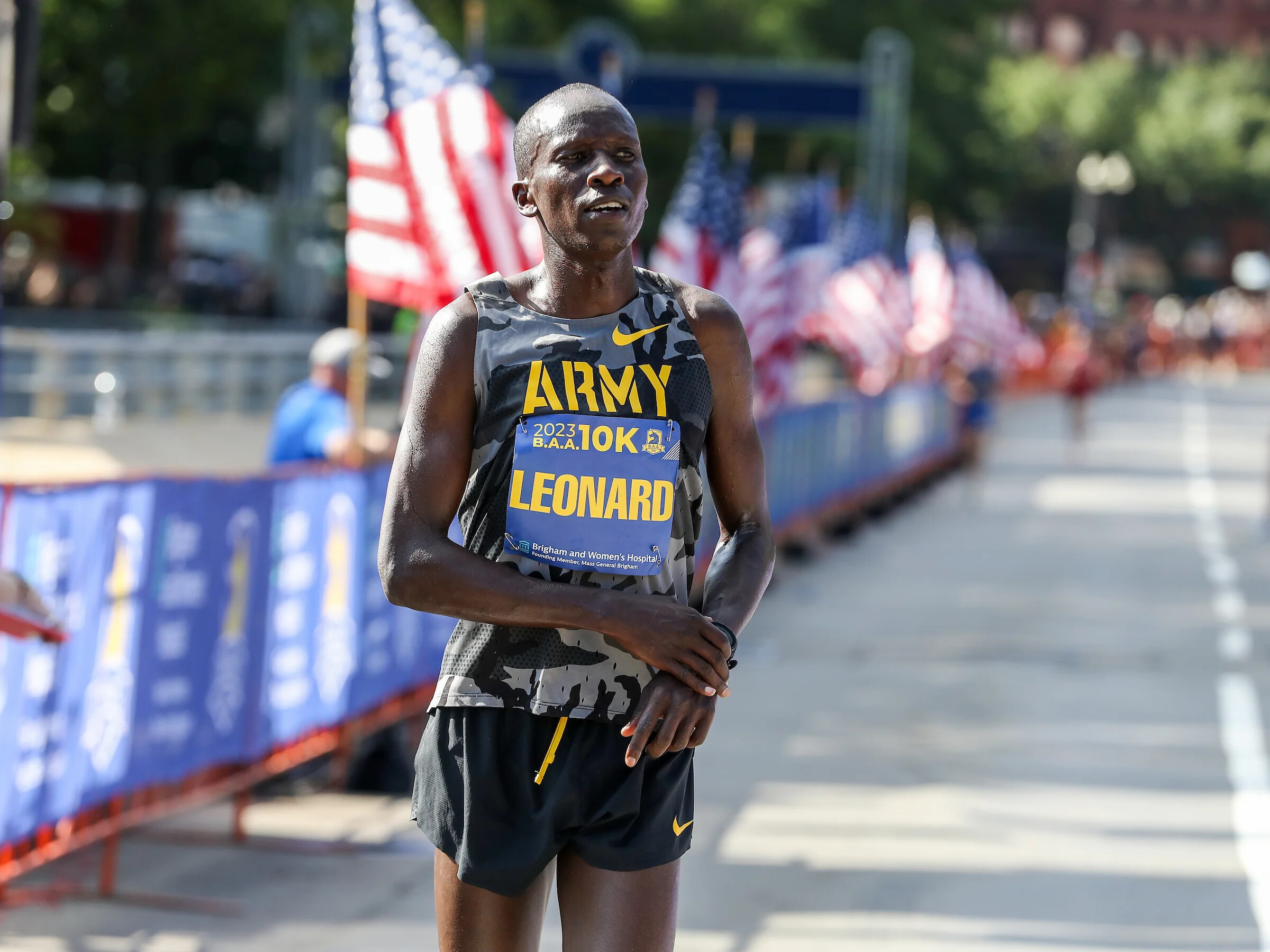
Australia’s Wide World of Sports reported that in recent weeks, World Athletics had been working on a solution to fit some highly-ranked athletes into the Olympic marathon while respecting Olympic sport quota limits set by the International Olympic Committee.
It was not immediately clear why World Athletics added four ranking places on Tuesday; this story will be updated as LetsRun.com learns more.
(06/05/2024) ⚡AMPby Jonathan Gault
Paris 2024 Olympic Games
For this historic event, the City of Light is thinking big! Visitors will be able to watch events at top sporting venues in Paris and the Paris region, as well as at emblematic monuments in the capital visited by several millions of tourists each year. The promise of exceptional moments to experience in an exceptional setting! A great way to...
more...ADAK suspends highest number of Kenyan athletes since January last year
The Anti-doping Agency of Kenya has unveiled the highest number of athletes banned for violating various doping rules.
The Anti-doping Agency of Kenya has banned 33 Kenyan athletes for violating the various doping rules as per the Athletics Integrity Unit.
The list includes 26 runners with the remaining coming from basketball, rugby and handball. In road running, one of the most shocking athletes to have made the list of shame is Joshua Belet, the 2023 TCS Amsterdam Marathon champion.
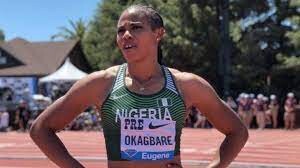
According to reports, this marks the highest number of suspended athletes since January last year, when Kenya was on the verge of being banned by World Athletics. However, it is a move that was anticipated since there has been increased testing.
Belet, a 26-year-old long distance runner, has been suspended for the presence of Anabolic Androgenic Steroids, Testosterone, Adiol, Pregnanediol, Androsterone and Etiocholanolone. Belet was a promising talent who even made his national team debut at the World Championships in Budapest, Hungary but did not finish the race.

Dorcas Kimeli has also been suspended and she was also a promising athlete who had represented Kenya in a couple of events including the 2020 World Half Marathon championships where she finished 11th. As reported by Nation Sport, Jepchumba has been suspended for tampering with any part of the doping control.
Meanwhile, upcoming sprinters Duke Osoro and Joan Jeruto have also been added to the list of shame with the 2012 World Under-20 5000m champion David Bett also making the list.
Brian Wahinya, a former Kenya Sevens player has also found himself in hot soup alongside fellow players Charlton Mokua and Zeden Lutomia. The trio has been suspended for the presence of Cannabinoids, linked to cannabis sativa.
The basketball players who have gotten themselves in the list of shame include Alex Ramazani, Albert Onyango and James Mwangi Maina.
(06/04/2024) ⚡AMPby Abigael Wuafula
David Rudisha names 3 key athletes to shape 800m race this Olympic season
World 800m record holder David Rudisha has revealed the three key athletes who will shape the two-lap race this Olympic season and might even threaten his world record.
World 800m record holder David Rudisha has singled out three athletes that could shape the 800m at the Paris 2024 Olympic Games and beyond.
Rudisha was an 800m maestro and defined the two-lap race in his prime and he believes other athletes are coming up and have the ability to change the quality of the 800m race.
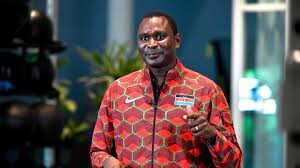
The two-time Olympic champion set his first 800m World Record of 1:41.09 on August 22, 2010 in Berlin, Germany before lowering his time to clock another world record of 1:40.91 set during the 2012 London Olympic Games.
No athlete has gotten near to the world record but the two-time world champion believes the trio of Emmanuel Wanyonyi, Marco Arop and Djamel Sedjati have the ability to redefine that.
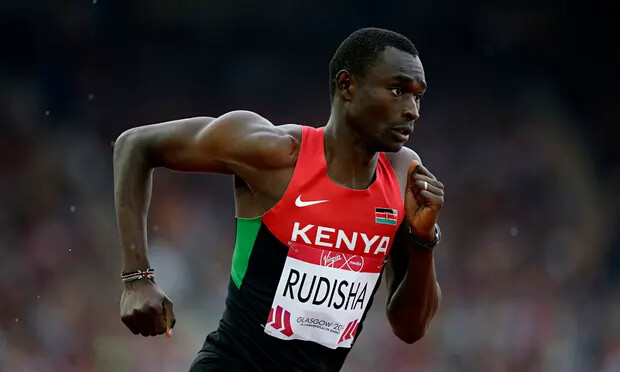
“From Kenya, we have Emmanuel Wanyonyi. Marco Arop from Canada. And I saw also a young kid Djamel Sedjati from Algeria running the world-leading time in Ostrava,” Rudisha told AFP.
“This is really amazing. We are looking forward to seeing how they are going to perform. In the Olympics, anything can happen. It's always very competitive and everybody goes there to win. So, there's a lot of expectation.”
Wanyonyi, the youngest of the three, has been in great form this season, and he will certainly be an athlete to watch in the city of love.
The world 800m silver medallist has been unbeaten in the 800m this season, winning the Kip Keino Classic and the Diamond League Meeting in Rabat, Morocco. He also set the road mile world record at the Adizero road to records event.
Meanwhile, Arop, the reigning world champion, has only raced once in the 800m outdoor and won in the Diamond League Meeting in Xiamen. He has been in great form, however, in his indoor events and will certainly be out to give his competitors a run for their money one more time.
Sedjati, 25, has also proven to be a strong athlete, striking with a world leading time of 1:43.51 in Ostrava in his season opener. He will also be looking to impress at the Paris 2024 Olympic Games, following his silver medal at the 2022 World Championships in Eugene, Oregon.
(06/04/2024) ⚡AMPby Abigael Wuafula
Registration dates for the 129th Boston Marathon announced
The Boston Athletic Association (B.A.A.) announced Monday that registration for the 129th Boston Marathon will take place over five days, from Sept. 9–13 at www.baa.org
The field size for the 129th Boston Marathon, to be run on Monday, April 21, 2025, will be 30,000 participants.
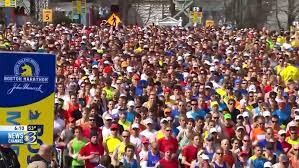
Qualifier registration will open on Sept. 9 at 10 a.m. and will close on Sept. 13, at 5 p.m. Any athlete who has achieved a currently valid Boston Marathon qualifying time may submit a registration application during registration week.
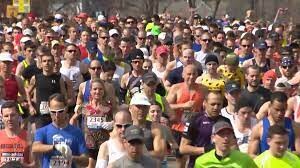
Applications will be accepted until 5 p.m. on Sept. 13. The 2025 Boston Marathon qualifying window began on Sept. 1, 2023, and will close at 5 p.m. on Friday, Sept. 13. If space is still available after the conclusion of registration week, registration will re-open on Sept. 16.
Qualifying standards across all divisions will remain the same as they were for the 2024 Boston Marathon.
(06/04/2024) ⚡AMPby Andrew Clark
Boston Marathon
Among the nation’s oldest athletic clubs, the B.A.A. was established in 1887, and, in 1896, more than half of the U.S. Olympic Team at the first modern games was composed of B.A.A. club members. The Olympic Games provided the inspiration for the first Boston Marathon, which culminated the B.A.A. Games on April 19, 1897. John J. McDermott emerged from a...
more...

